Home » Blog » What to see in Abruzzo, a list of the 12 best places
- February 7, 2018

What to see in Abruzzo, a list of the 12 best places
Fabrizio Lucci
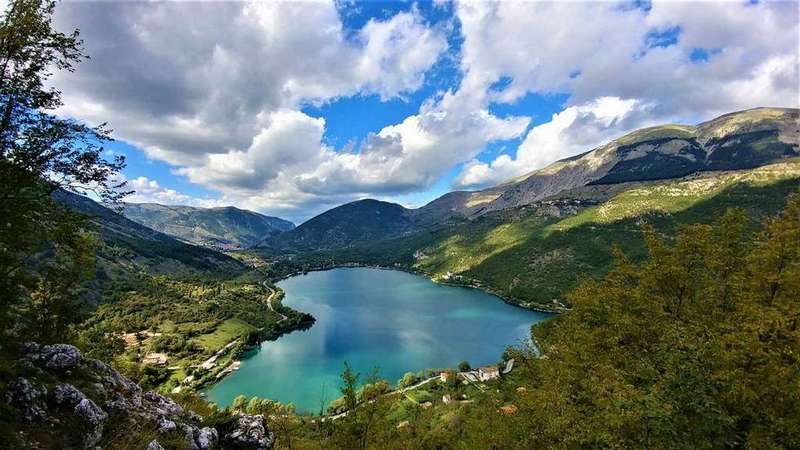
We will now take you on a trip across this incredible region just to give you an idea of what you should expect… And fall in love with.
So what to see in Abruzzo ? Here’s a list of the 12 best places .
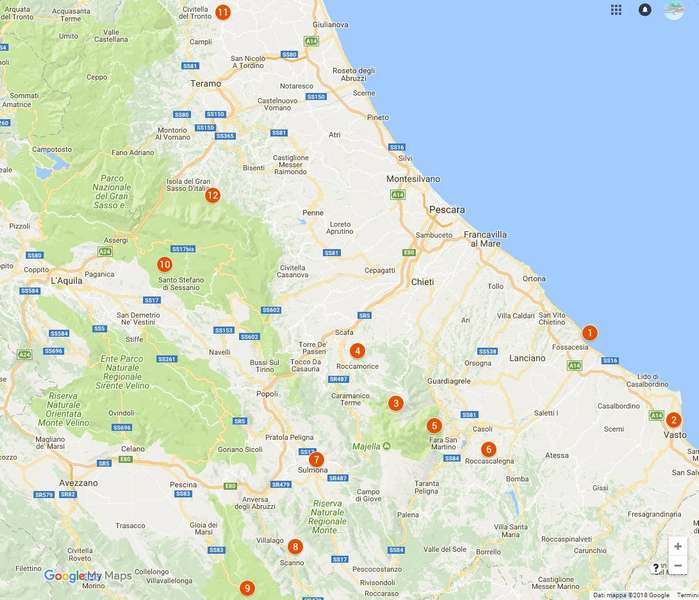
See the full map here .
1. The Trabocchi Coast with its unique fishing platforms
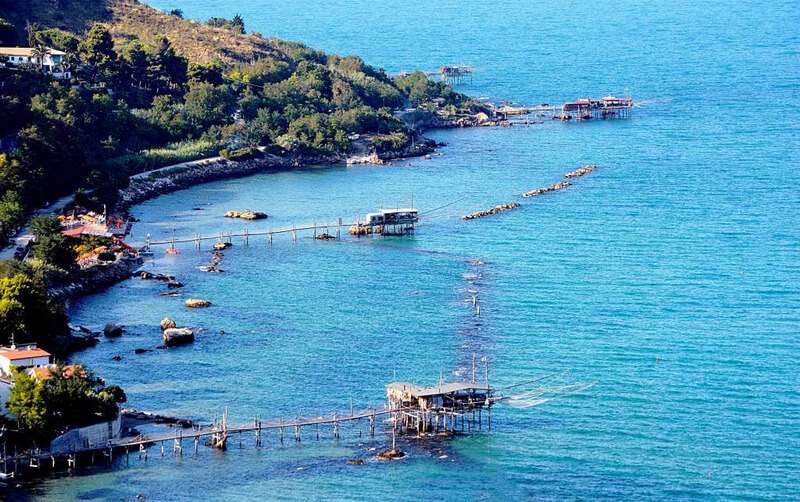
So yes, you can also have lunch or dinner over there!
All our tours include a visit to this charming fishing houses, where you can take part into a fish cooking class and enjoy a wonderful meal.
Another enchanting and still well-preserved gift from the past is the Abbazia of San Giovanni in Venere . Sited on a hill near Fossacesia and built on the site of a Roman temple, it is a wonderful abbey and holy site of art, peace and prayer, a great example of romanic and Italian gothic style. Its privileged position offers an incredible view of the Adriatic sea from north to south.
2. Vasto, the ancient Roman town and its enchanting beaches
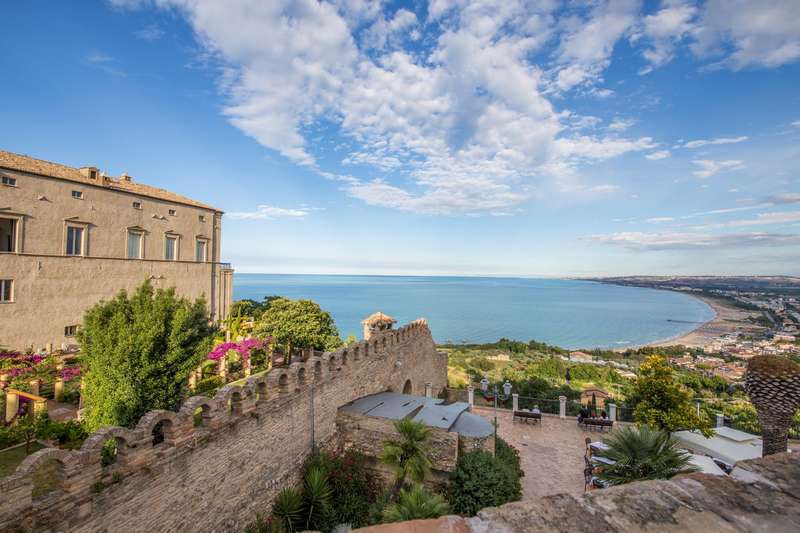
Vasto is a hilltop town overlooking the Adriatic sea in southern Abruzzo. The old centre is a lovely medieval spot with beautiful buildings dating from the 15th century.
Taking a walk from Piazza Rossetti , you will see the Caldoresco Castle , the San Giuseppe Cathedral with its Romanesque facade, and Palazzo d’Avalos : here you can visit its museums and Neapolitan-style gardens. If you keep wandering through the narrow alleyways you will find yourself speechless in front these ancient buildings and the view over the gulf.
Vasto is also well known for the variety of its beaches . Going downhill from the ancient centre you will reach Vasto Marina, a popular holiday destination full of many beach resorts. If you keep going north along the coast, nature will surprise you with a rocky spot and its crystal clear water: this is hidden gem of San Nicola .
Further along the coast, past the lighthouse at Punta Penna ( the second tallest lighthouse in Italy ) is another, even quieter, beach, by a nature reserve at Punta Aderci , which was listed as one of the 10 most beautiful Italian beaches for 2018 by the The Telegraph UK . Vasto is a stop-over of all our tours, and we will make sure you will leave it with the greatest memories.
3. Passolanciano-Majelletta, skiing and hiking with a sea view
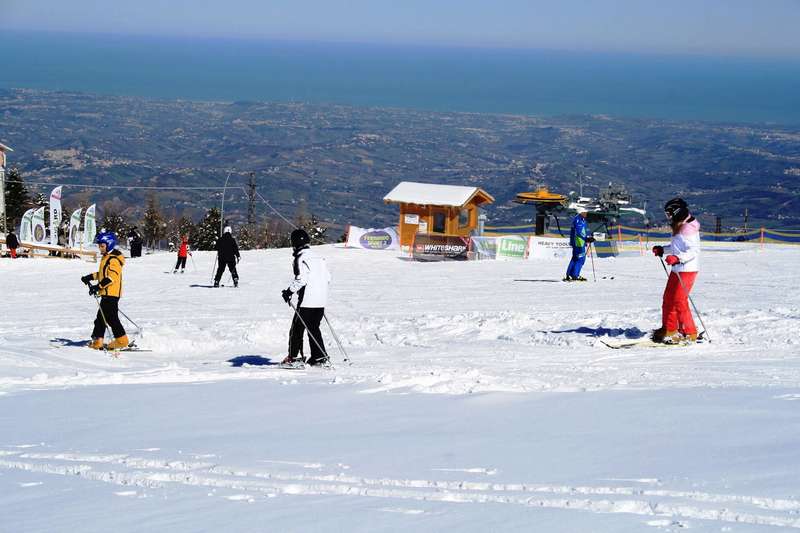
Have you ever skied with a sea view? Passolanciano – Majelletta is a ski resort that offers a unique scenery at almost 2000 meters above sea level, overlooking the Adriatic coast.
This area is also a great place for hiking, walking through incredible sceneries and discovering solitary and remote hermitages set in the rocky mountainside.

4. The stunning landscapes and treasures of Majella National Park
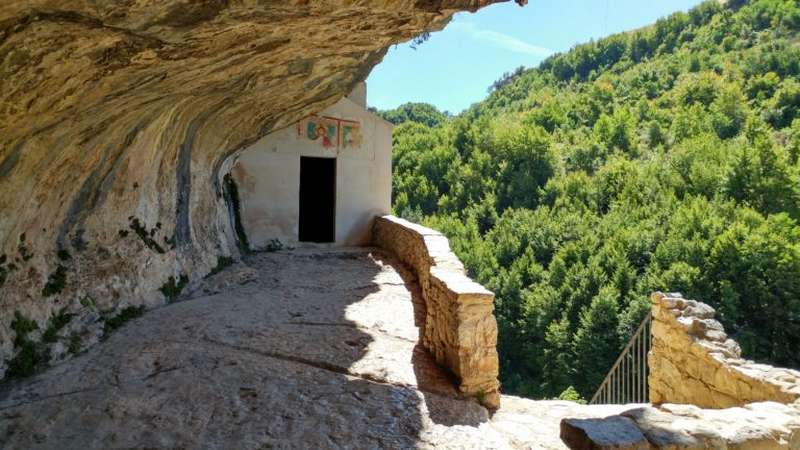
Majella National Park is one of three national parks of the region, together with National Park of Abruzzo, Lazio and Molise , and Gran Sasso and Monti della Laga National Park .
It is one of the best preserved apennine ecosystems, made of nearly 100 square miles of immaculate mountains and canyons to enjoy.
In the warmer months, its hiking trails are the ideal activity for those who love the great outdoors.
Our Cultural, Culinary & Walking Experience Tour in Abruzzo will guide you through the beauty of this area: we will reach the Hermitage of San Bartolomeo in Legio , Abruzzo’s most famous rock face retreat , just outside the town of Roccamorice , c arved into the mountain and immersed in the silence of the surrounding woods, and the Hermitage of Santo Spirito , one of the most important monasteries of the Majella.
They are both so evocative that, around 800 years ago, the future pope Celestino V chose them as the places for his meditation and prayers.
5. Fara San Martino, the kingdom of Italian pasta
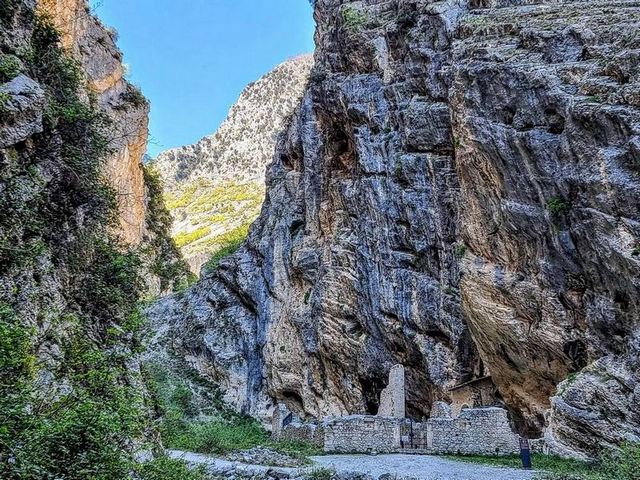
Abruzzo also has a long history of pasta-making . Located in the Majella National Park, the quaint village of Fara San Martino is known for the distinctive flavor and quality of its pasta. It is home to three of the most widely recognized high-end pasta brands, De Cecco, Delverde and Cocco.
We cannot share the secrets of how they make it (actually, nobody knows them!), but we will still be able to teach you the best techniques to make it on your own if you wish… You just have to take part into one of our cooking classes!
Fara San Martino is also known for its “gole” , located a few minutes away from the town, one of the longest Italian canyons (9 miles), a wonderful path for walks and picnics.

6. The medieval atmosphere of Roccascalegna and its castle
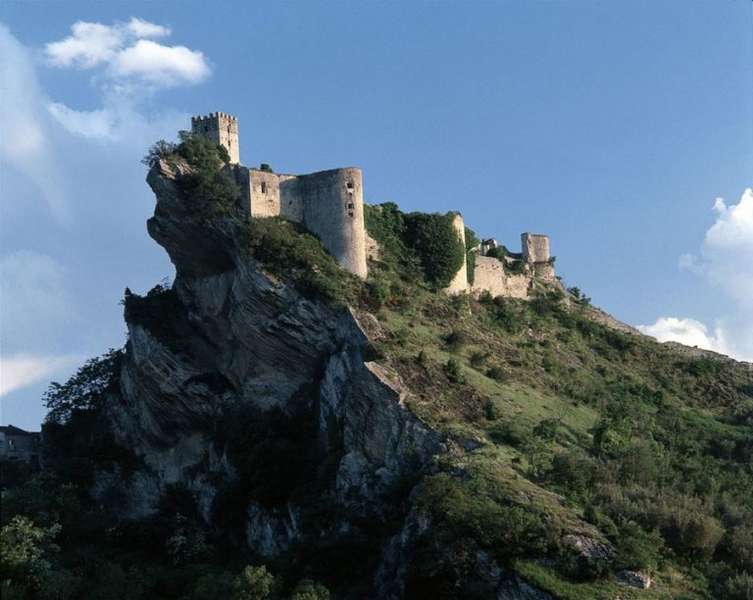
There are more than fifty castles in Abruzzo alone, but this is definitely one of the most impressive.
It is a must see spot for anyone who visits Abruzzo.
7. Sulmona, the capital of “confetti”
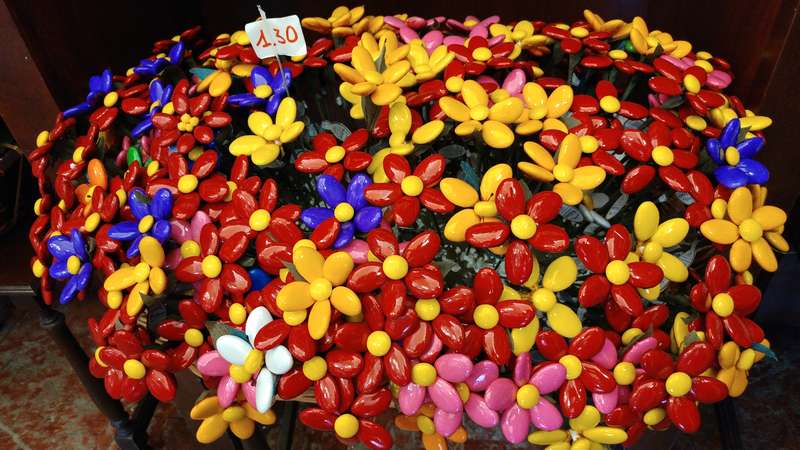
Sulmona is a charming town located at the foot of the Majella, surrounded by mountains, where ancient history and a strong tradition for colorful sweets live together making it one of the most famous villages in Abruzzo.
Originating as Sulmo, a town of the Peligni (an ancient Italic people), it was later a Roman possession and was the birthplace of the 1st-century Roman poet Ovid .
Nowadays, it is famous for being the capital of sugared-coated almonds, known as “confetti” in Italian. Its streets are adorned with colorful confetti bouquets, which you can buy in any imaginable flavor – Nutella, tiramisu, ricotta and pear, fruits of the forest, hazelnut, and anything you can think about.
8. The magical village and lake of Scanno

The same lake touches Villalago , a tiny village located 15 minutes away from Scanno, mostly known for the Hermitage of San Domenico , a small church surrounded by peace and the beauty of nature.
9. Abruzzo National Park, deep in the heart of nature
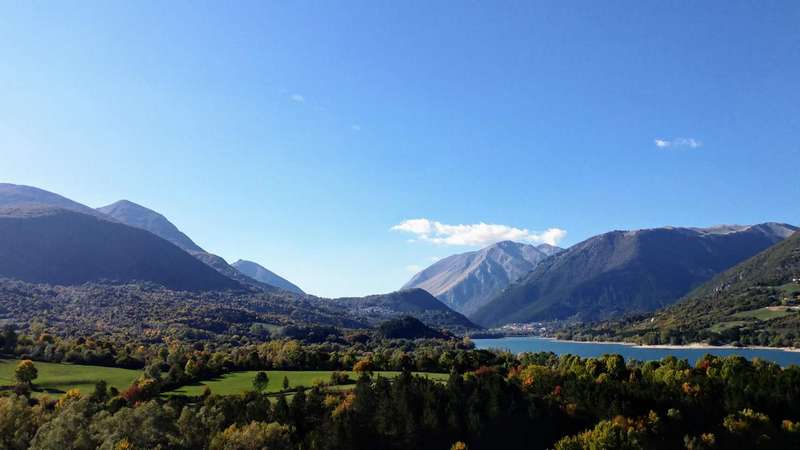
It is home to 25 towns, of which two of the most widely known are Pescasseroli – a popular ski resort in winter an excellent base camp in warmer months to explore the plant and wildlife of the forest landscape – and Civitella Alfedena , located in an area inhabited by the Appennine wolf and lynx.
The Park is the ideal destination for anybody who wants to experience a break from crowded cities and get immersed in the heart of nature, taking a walk or a drive through the fascinating paths from where it’s quite common to see the local fauna.
10. The fabulous hamlets and panoramic views of Gran Sasso
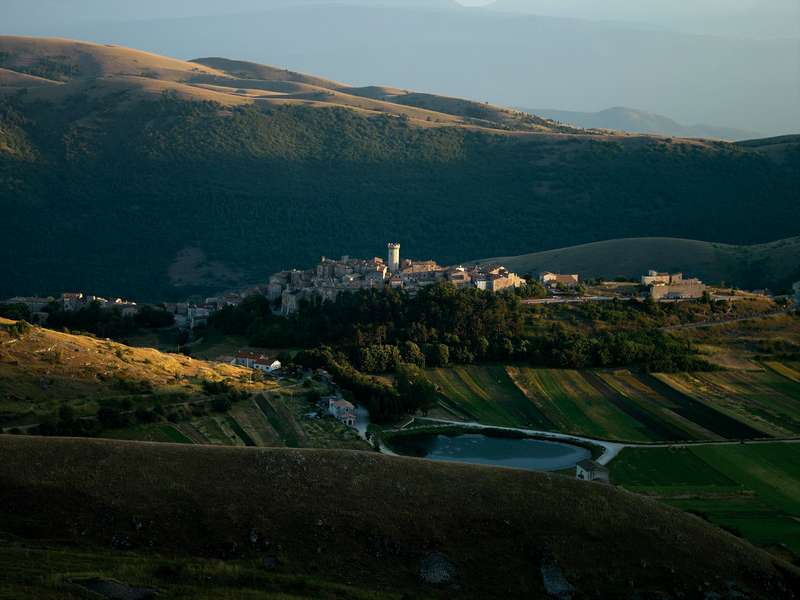
Gran Sasso d’Italia is a mountain massif located in Abruzzo. Its chief peak, the Big Horn , is the highest mountain of central Italy. It is located in the Gran Sasso and Monti della Laga National Park , another great spot for excursions and “hamlet-hunting”: we will now introduce you to three gems that are definitely worth a visit.
Have you heard of “extended hotel”? In Italian we call it “ albergo diffuso ” and Santo Stefano di Sessanio is one of the greatest example of this peculiar way of being a tourist and a local resident at the same time.
In order to protect the ancient architecture of the village that was mainly left in abandonment, in the last 15 years many houses and structures have been restored and converted into vacation homes. This means you will basically breathe the medieval atmosphere just like it was in old times.
A few minutes away from Santo Stefano di Sessanio there is another not-to-be-missed stop in the area: it is the 12th Century military fortress of Rocca Calascio , proudly standing in the middle of nowhere, and offering the most glorious views of the surrounding countryside and mountains. No wonder why, among others, it was chosen as the set for The Name of the Rose , with Sean Connery, and Lady Hawke , with Michelle Pfeiffer.
Talking about panoramic sceneries, Campo Imperatore (“Emperor’s Field”), the largest and highest Alpine meadow of the region, is another must for visitors to Abruzzo. The magic, history, colors and harmony of the surroundings will leave you speechless all year round.
11. Civitella del Tronto and its impressive fortress
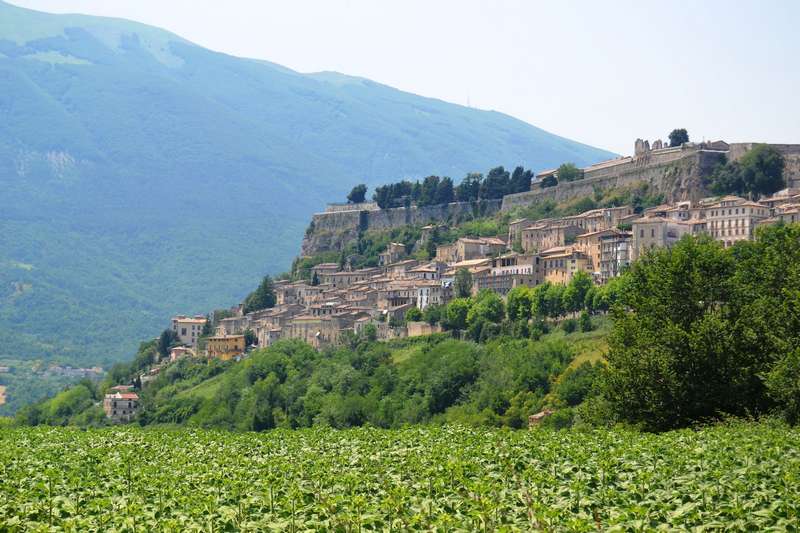
Civitella del Tronto is another enchanting town in the Gran Sasso e Monti della Laga National Park . It is home to the largest fortress in Italy and the second largest in Europe, that offers 360° views over three different mountain ranges, the village below and the Adriatic sea: absolutely stunning.
After admiring this incredible military architecture, you can wander down the hill and explore all the streets and alleys of the small village and try to fit into the smallest street of Italy, that is called “ruetta”… We will be happy to teach you how to pronounce it!
12. Castelli, the home of world famous hand-painted ceramics
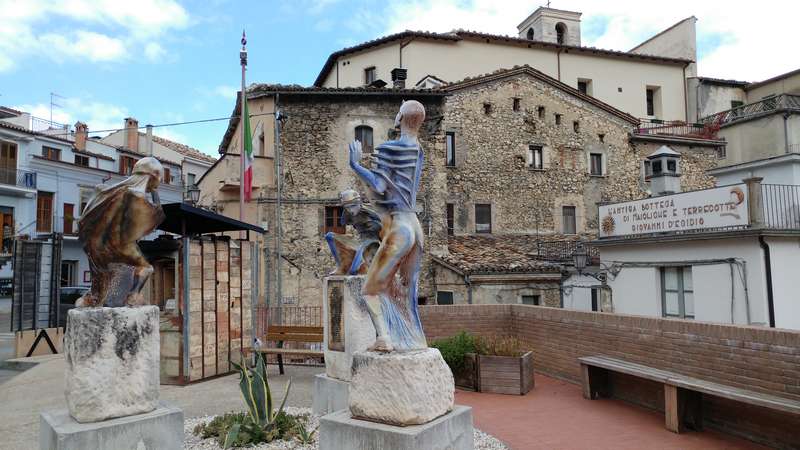
Castelli (located within the Gran Sasso e Monti della Laga National Park ) is the capital of Abruzzo’s version of decorative ceramics, which were collected by the nobility of Europe for centuries.
Majolica is the name given to pottery with clear colored glazes and these brightly colored hand-painted pieces are famous for their characteristic “pentacromia,” a five-color palette of yellow, green, blue, orange, and brown.
There are plenty of shops and factories to visit, and if you would like to make your own Castelli masterpiece, you just need to take part into one of the culture and art tours of Abruzzo .
Ready to Go?
So if you’re tired of the same-old same-old city tours of Rome or Venice, why not experience the authentic Italy of Abruzzo?
Get in touch today to help bring your dream tour into focus – wouldn’t you love to see the Adriatic sea from the mountains or to have a lunch suspended over the sea? And if you’re not quite ready to make an enquiry, sign up for our free email course to learn everything you need to know about planning a tour of Abruzzo.

18 thoughts on “What to see in Abruzzo, a list of the 12 best places”
Congratulations and thanks for this great picture of Abruzzo. Keep up the good work !
Many thanks for your nice words David, keep following us. Fabrizio
My grandfather from antrodrocco
This company is amazing. It is unlike any other tour I have ever been on. Fabrizio is a thoughtful, friendly, well educated guide. He will personalize your tour to cover your areas of interest. The groups are small so you do not feel herded or hurried. The food experiences are authentic with an amazing variety of area specialties. Fabrizio is from Vasto and is especially proud of his native area and wants to share his culture with his guests. You could not do better than this tour to a much less “touristy” area of Italy. Grazie Febrizio.
Dear Gerry, many thanks for your wonderful words. I’m really happy to read them, grazie mille and ciao for now, Fabrizio.
Every word is true. Abruzzo is magical and Fabrizio is the most conscientious guide you can imagine. Go to Abruzzo and experience the best time of your life with Fabrizio. Ciao amico Fabrizio!
Dear Pamela, many thanks for your wonderful words. I’m really happy to read them, grazie mille and ciao for now amica mia:-), Fabrizio.
Many thanks for your wonderful words. I’m really happy to read them, grazie mille and ciao for now, Fabrizio.
Is there any hill towns with sea views? 15 miles or so from the coast.
my hometown, and our base, Vasto, is an hill town with sea view, it is 2.5 miles from the coast. Click here to discover more: https://italiasweetitalia.com/vasto-abruzzo-an-evocative-itinerary-between-memories-and-beautiful-spots/
Many thanks for your interest,
Fabrizio I am considering a trip to Abruzzo in 2023, my family is from Luco Dei Marsi and Opi… possibly Civitella Alfedna (if my ancestry research is correct). Can you recommend how to add these places into a trip..
Ciao Andrea
Ciao Andrea,
many thanks for your comment and it si nice to know that you are “abruzzese”.
I’m sending a private e-mail to your.
Best regards
Do you have experience with Alfedena? My grandfather is from there so coming to Abruzzi I’d like to see Alfedena.
Buongiorno Ivie,
many thanks for sharing with us your family information.
I just sent you an email.
Grazie and ciao for now
Thanks for your beautiful information
Buongiorno Fatima, thank you for your kind words!
We will be in Sulmona Sept 4 to 7 2024 . 4 people can we set up a tour with you? My Grandfather was born in Sulmona.
Thanks, Donna
Ciao Donna,
many thanks for contacting me.
I’m sending you an e-mail.
I would be happy to let you discover (y)our culture, traditions, food, landscapes and people through one of our tours of Abruzzo that you can discover here: https://www.italiasweetitalia.com/italian-cookery-holidays-calendar-and-booking/ .
Thank you and ciao for now
Leave a Comment Cancel Reply
Your email address will not be published. Required fields are marked *
Save my name, email, and website in this browser for the next time I comment.
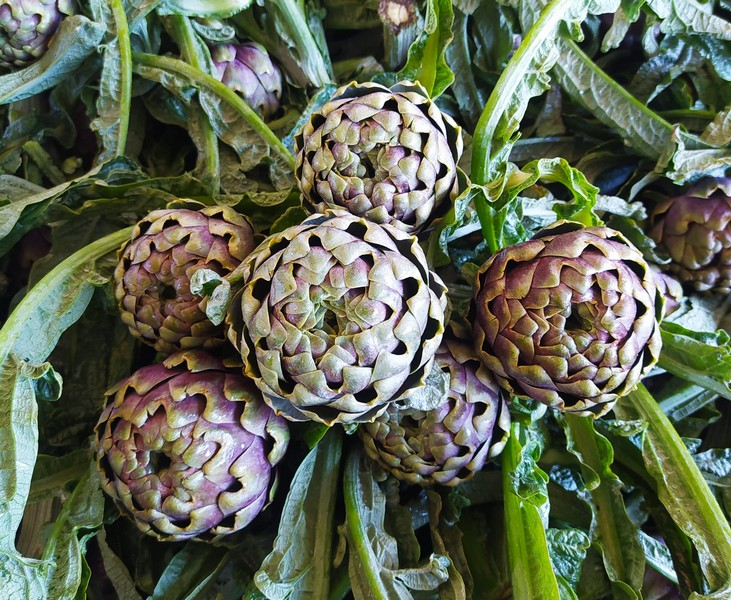
Cupello: The Heart of Flavor – The Tradition of Mazzaferrata Artichoke
In the heart of Abruzzo, amidst the fertile hills of the province of Chieti, lies a village that tells centuries of history and passion: Cupello.
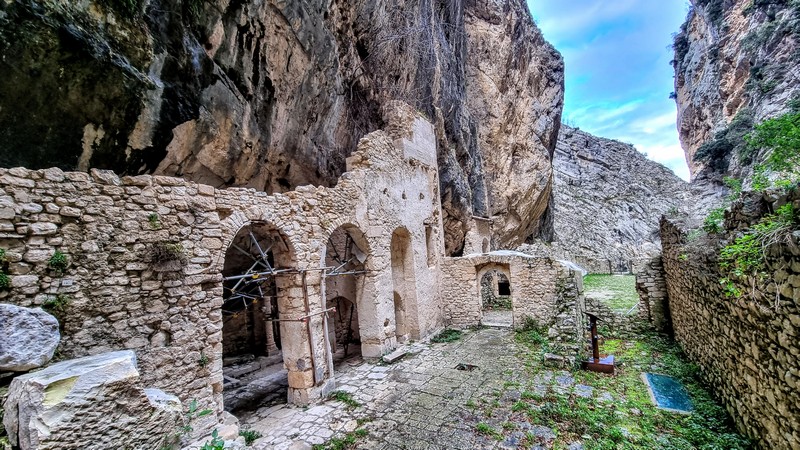
Pasta Excellence and Natural Majesty: Exploring Fara San Martino
Imagine walking through the streets of an ancient village, surrounded by the grandeur of mountains and the tranquility of an unspoiled natural landscape. Welcome to

Abruzzese Aperitifs: A Sensory Journey of Taste and Tradition
If there’s a magical moment during the day in Italy, it’s aperitivo time. It’s that time when friends and family gather to relax, share stories,
Are you ready to experience Abruzzo and Beyond?
The abruzzo, puglia & matera experience €3,565, cultural, culinary & walking experience in abruzzo €1,985, food, culture and wellness in the hidden emilia romagna €2,595.
- Emilia-Romagna
Love Italy? You've come to the right place.
Enter your details to get travel inspiration, curiosities and amazing offers delivered to your inbox
I authorise the processing of personal data transmitted pursuant to the Italian & EU law on privacy 679/2016

If you have any questions or an authentic Italian vacation idea for yourself or a group that you would like to discuss with Italia Sweet Italia please do get in touch with Fabrizio by any of the methods below:
- Mobile | WhatsApp (call or text): +39 349 8630483 (Fabrizio)
- E-Mail: [email protected]
Click here to Schedule a Free Consultation with Fabrizio to Discover more about Abruzzo and our Tours
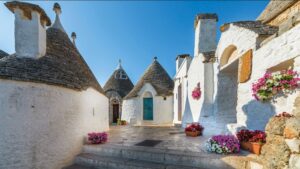
The Abruzzo, Puglia & Matera Experience
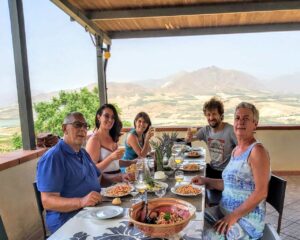
Culture and food trip in authentic Sicily

Cultural, Patron Saint Celebrations & Grape Harvest Experience in Abruzzo
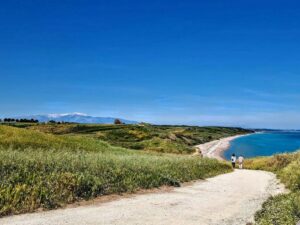
Cultural, Culinary & Walking Experience in Abruzzo
© 2023 Italia Sweet Italia Holidays di Lucci Fabrizio | P. IVA/VAT: IT02557170699 | Via Circonvallazione Histoniense n. 501/A – 66054 Vasto (CH) – Italy | Terms of Use
Download Free cooking booklet
Discover our authentic recipes from Abruzzo passed down over the years for generations
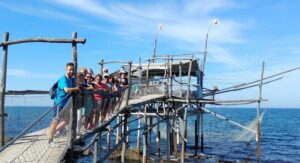
Discover Authentic Italy With Fabrizio: How to Plan an Amazing Tour of Abruzzo
Our 6-part free email course will walk you through everything you need to know about planning - and enjoying - an amazing tour of abruzzo..

Touropia Travel Experts
Discover the World
12 Best Places to Visit in Abruzzo, Italy

Unassuming, unheralded, or underrated. However you see it, Abruzzo is a beautiful and historic playground that you can discover as the world ventures elsewhere.
Its proximity to Rome makes travel easy, without overwhelming the trio of national parks, alpine villages, and coastal hideaways. The nature within Abruzzo makes it a haven for hikers and explorers, plus skiers when the temperature drops.
The mountains which are so stunning were seen as natural fortresses for the region’s towns. These villages and cities tucked away along mountain ranges, have connections to pre-Roman times. Their culture, craftsmanship, and recipes survive as the generations pass.
As travelers venture further north in Abruzzo, Italy, or to the western coast, take time to explore a place as raw and wild as any in Italy.
12. Civitella del Tronto
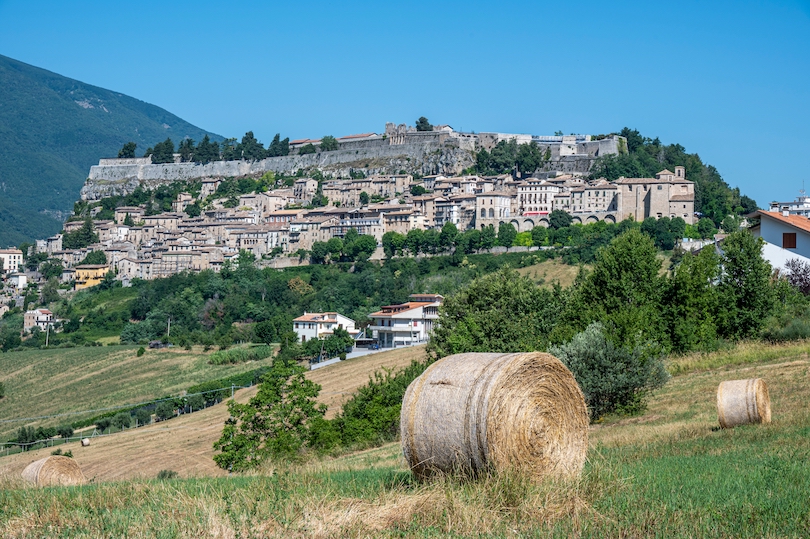
Home to the highest fortress in Italy, Civitella del Tronto is a trip back in time. In the 1860s, the fortress helped the city become the last bastion of resistance against Victor Emmanuel’s plans to unify Italy.
Much of Civitella del Tronto is encased in the Bourbon Fortezza, whose origins can be traced to the 11th century. Its almost 700 years of defending the town allowed its cobbled streets to blossom with sightly buildings, delicious cuisine, and gravity-defying stairways.
One of these stairways rises steeply out of the valley to the fortress entrance. Soon you’ll pass the old Governor’s house and the Church of San Giacomo where the parapets guide you around the fort’s entirety.
11. Sulmona
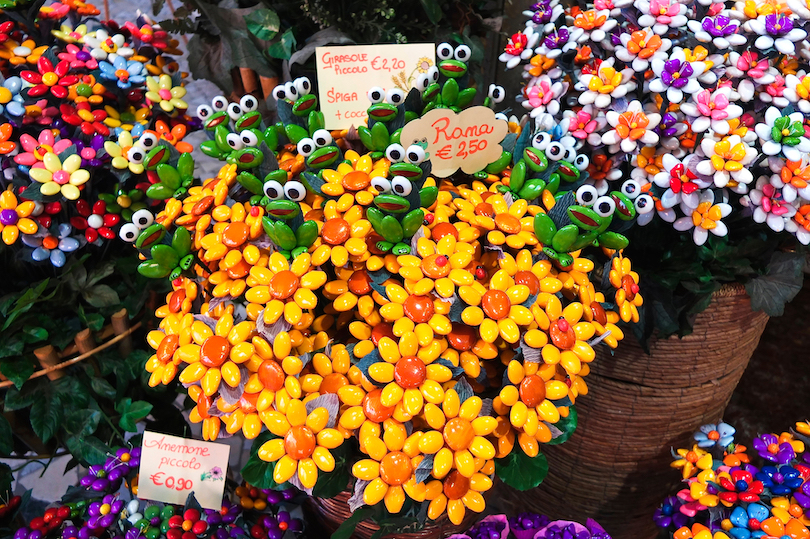
With a history that began with the ancient Italic people of Peligni, Sulmona has been around for thousands of years. Once it fell under Roman possession, it became known as the birthplace of Ovid, a 1st-century Roman poet.
Fast forward to now and Sulmona is synonymous with confetti. No, not the kind that blasts into the sky. Instead, Italian confetti is a collection of colorful, flavored almonds.
Designed in all sorts of artistic fashions, including colorful bouquets, the streets of Sulmona are laden with confetti. While you wouldn’t want to eat those, head into the town’s many shops to find delicious confetti featuring fruit flavors, Nutella, hazelnut, and even tiramisu.
10. Trabocchi Coast
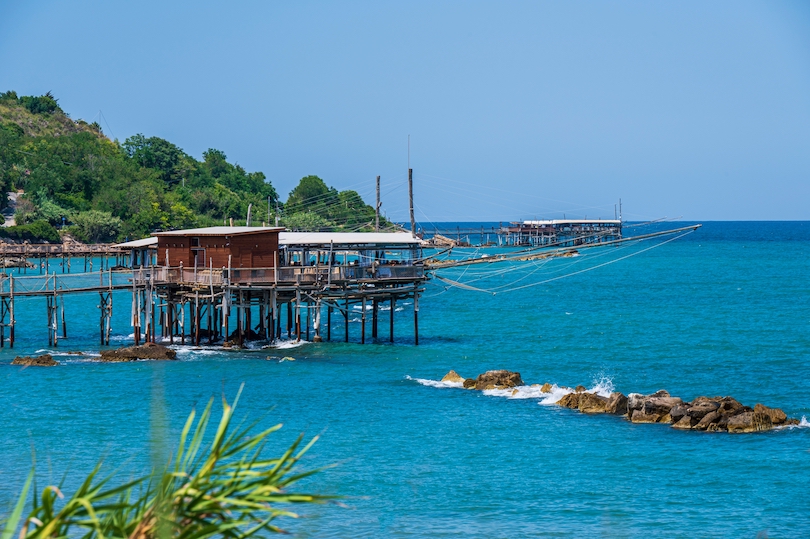
Connecting Ortona to San Salvo, the Trabocchi Coast, is beautiful and fascinating. The name derives from the centuries-old fishing net designs that are spread along the coasts 70 kilometers (43 miles).
These “nets” are in face lengthy wooden platforms that run into the Adriatic. From the end of them, fishermen could essentially deep sea fish. As old as many are, they stand before you, some with their own restaurants.
A memorable coastal drive takes you from town to town with an endless blue sea to enjoy along the way. Other highlights include the Abbazia of San Giovanni. The gothic abbey is set upon an ancient Roman temple looking out to the sea.
9. Majella National Park
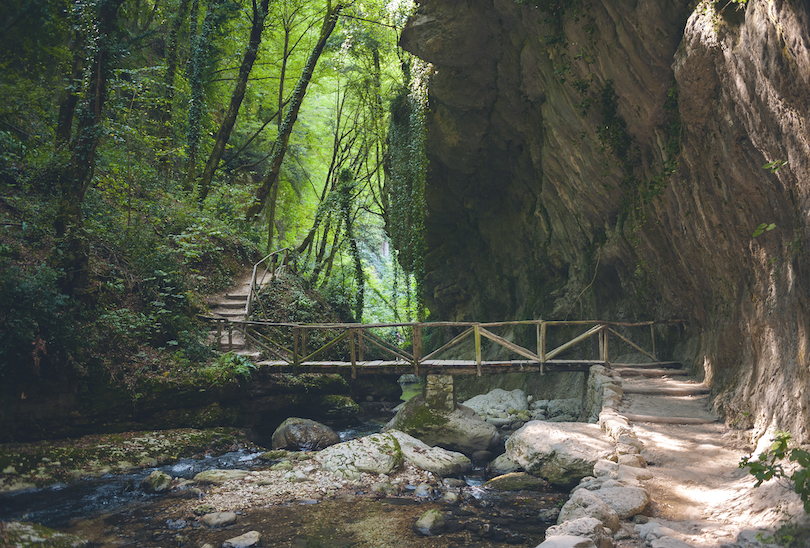
One of three national parks in the Abruzzo region, Majella National Park, features spectacular Apennine mountain scenery. Among the high peaks are jaw-dropping valleys where vast canyons have carved their way ruggedly through the otherwise pristine landscape.
Under the delightful Italian sun, lather on the sunblock and make your way down the park’s miles of hiking trails. The extensive system guides you to postcard-worthy views, with each step bringing the chance to discover Majella’s rich natural diversity.
One trek to add to your Majella National Park itinerary is the jaunt to the Gorges of Fara San Martino. A brief hike takes you to a natural rock entrance where a vast valley spreads out before you and you’ll uncover the ruins of the historic Benedictine Abbey of St. Martin. If you’re still energetic, continue on to Mount Amaro, the park’s highest peak.
Aside from nature, this national park is packed with ancient culture and archaeology. Aside from the abbey, there are roughly 40 hermitages that were first developed to house monks.
8. Roccascalegna
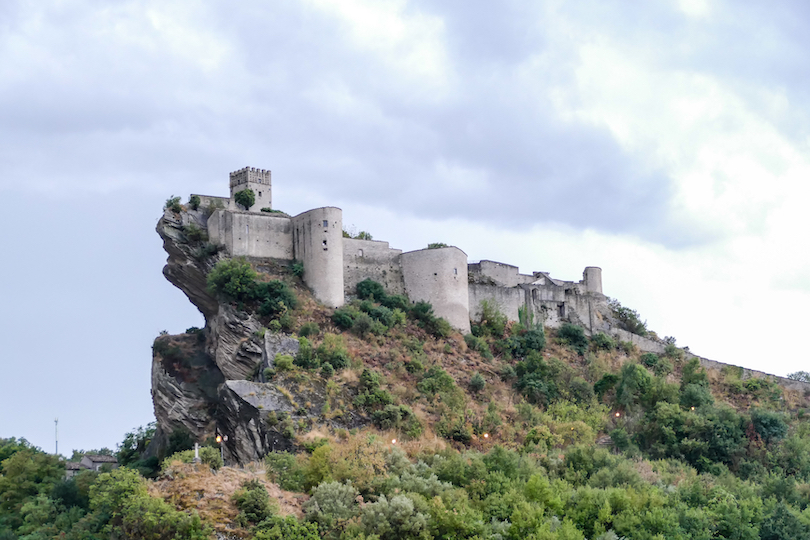
A 16th-century castle in Roccascalegna will redefine what you can expect from medieval architecture. Rising out of an angled limestone cliff, the Castle of Roccascalegna sits in an impressively precarious location.
Lying in the valley beneath is a small village whose origins can be traced to the 7th-century. Designed to protect it, the aptly named Castle in the Sky looked over the village and helped slow the rise of invaders. The very folks that led people to think of Roccascalegna as Death Valley.
The castle’s most famous inhabitant was the Crow Baron, Corvo de Corvis. He was an evil ruler who forced high taxes and made all new brides spend their first night of marriage with him. A fact that would eventually lead to his downfall, with a newlywed plunging a knife into his heart.
Today, you can visit the castle’s keep, courtyard, and prison.
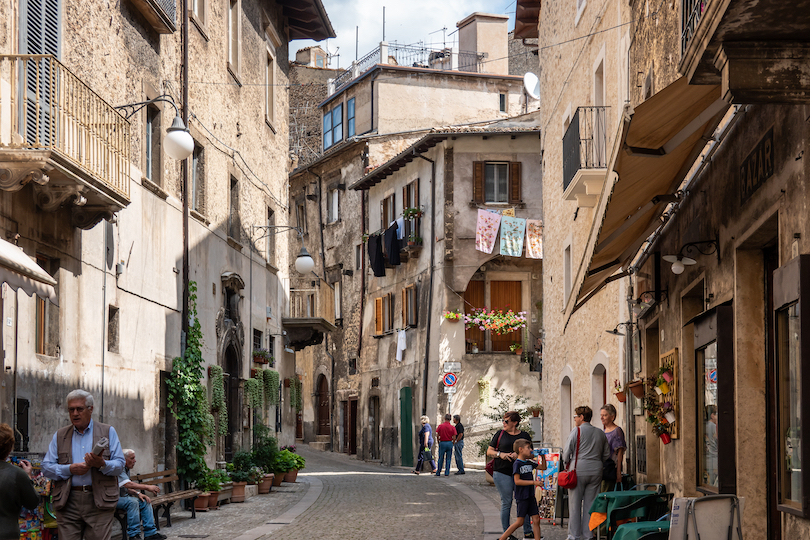
The alpine town of Scanno is known as the Pearl of Abruzzo. In many ways, it combines the best parts of the region into one, featuring medieval architecture, surrounded by mountains and fresh alpine air.
In the 15th century, thanks to agriculture and a talented community, Scanno was a wealthy town. Today, its buildings tell the tales of the era’s past but the old skills and craftsmanship survive.
As you explore the ancient streets of Scanno, shops selling handmade ricami (lace work), orafa (goldsmiths), and high-end ceramics are direct descendants of a time when affluent goods were in high demand.
The maze of streets makes Scanno a great place to get lost. But be sure to find time to see the Sarracco Fountain and the Church of Santa Maria Dalla Valle.
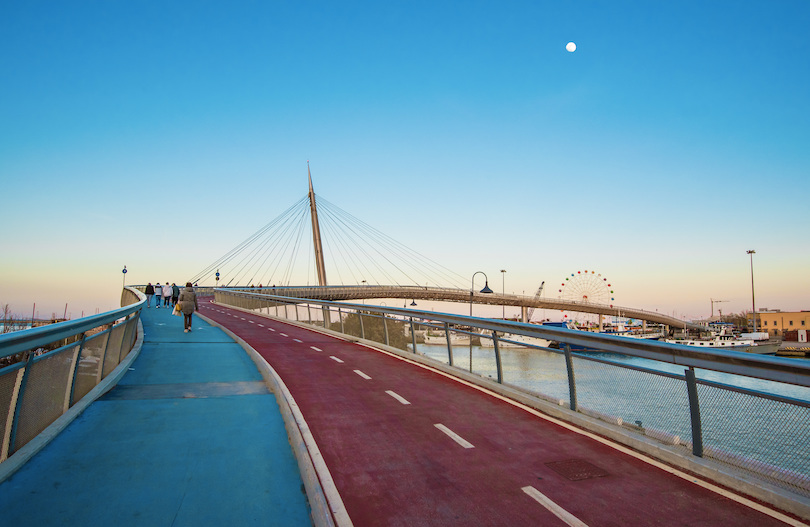
L’Aquila may be the capital, but Pescara is the biggest city in Abruzzo. Famous for its golden coast, line with marinas that jut out into the Adriatic, Pescara is the place to develop a terrible tan line.
Compared to other parts of Abruzzo, Pescara is refreshingly modern. Its now lively waterfront owes its recent developments to its predecessors being heavily bombed during the Second World War.
Boasting just shy of 20 kilometers (12 miles) of pristine waterfront, Pescara is a buzz of action during the summer months. The beaches are lined with umbrellas, locals reading in the shade, and hordes of swimmers making use of the refreshing Adriatic that is just as easy on the eyes.
As the sun falls behind Pescara, restaurants quickly fill out and the DJ beats flow out of nearby nightclubs into the happening streets.
5. Roccaraso Ski Area
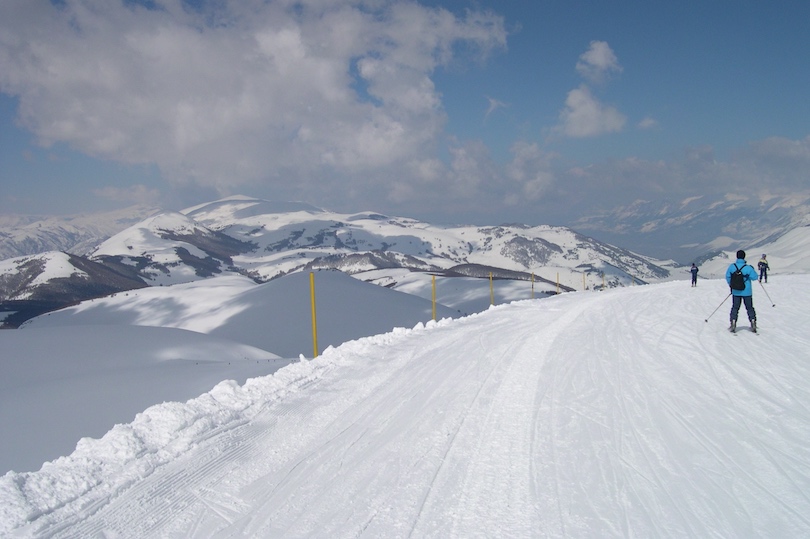
Come winter, do as the locals do, and visit the Roccaraso Ski Area. While international tourists venture further north to France and Switzerland, Roccaraso is home to a ski culture that is pure Italian.
With little outside interests (aside from those in Rome and Naples), the ski area has developed its own way of doing things. Once we are sure you’ll appreciate it. Roccaraso is the most popular of Abruzzo’s budding slopes. It covers all abilities, from beginners to experts with over 1000 meters (3,200 ft) of vertical.
In town, you’ll find a relaxing cafe culture, bars for après-ski, and shops for when the slopes aren’t calling out. In addition, Roccaraso connects with other ski resorts, vastly increasing the amount of downhill and cross-country trails all on the same pass.
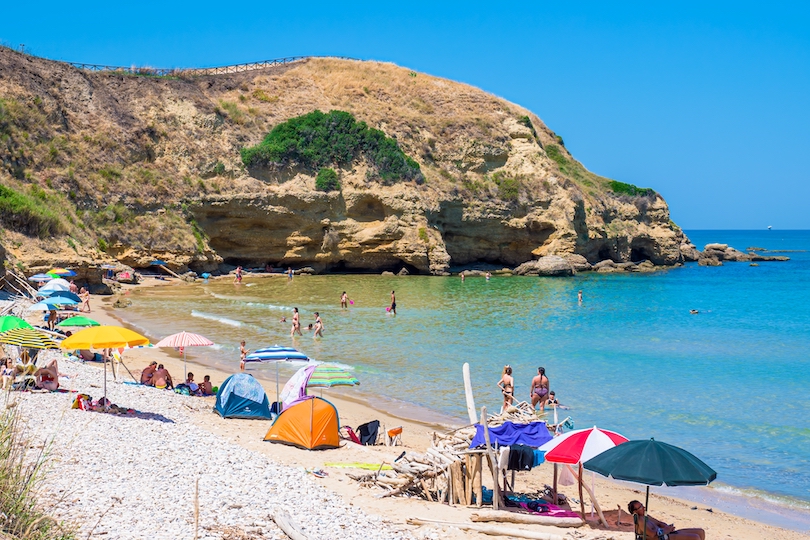
Overlooking the vast and scenic Adriatic Sea, Vasto is as charming as it is unassuming. Its eye-catching coastal location makes it a great beach getaway along Italy’s east coast. While its architecture adds plenty of medieval brilliance to the mix.
From the Adriatic Sea, the coastal hills rise quickly towards the center of Vasto, which sits elegantly along the peak. With great views around every corner, Vasta is a joy to discover on foot. Fortress walls blend in with spots of gorgeous green vegetation and narrow streets guide you by 500-year-old buildings.
At the heart of Vasta’s history is the stunning Caldoresco Castle and the San Guiseppe Cathedral. Their delightful Romanesque facades will stop you in your tracks. After a day of walking, stop by Piazzo Rossetti for an afternoon espresso surrounded by a quaint local atmosphere.
Beyond the center of town, Vasto offers lovely beaches. Pick between the resort-laden Vasta Marino or go off-trail and seek out the crystalline waters of San Nicola.
3. Gran Sasso National Park
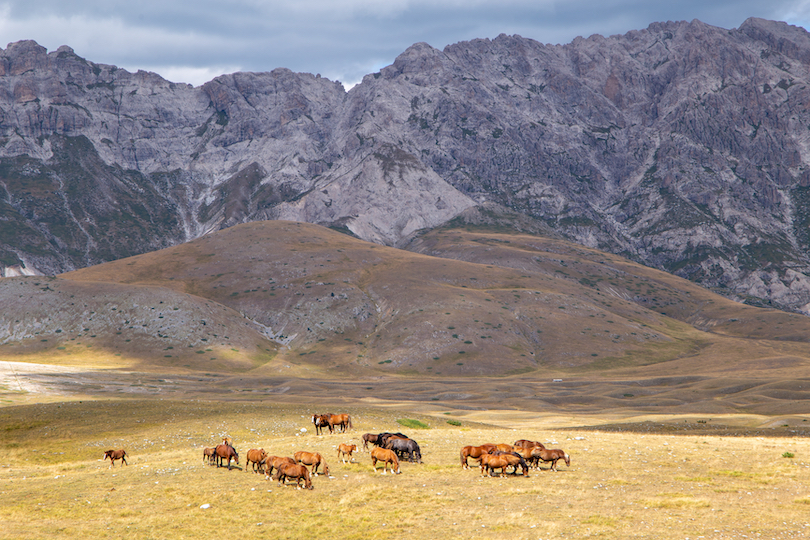
Epitomizing the beauty and personality of Abruzzo, Gran Sasso National Park is spectacular yet unheralded. As one of the biggest national parks in Italy, Gran Sasso boasts astonishing scenery. Its towering mountains have taken inspiration from the Swiss Alps, and its alpine lake offers a hint of Patagonia.
Home to three mountain ranges, there’s plenty of exploration for travelers to embark on. Hiking, mountaineering, and rock climbing are the main sports when the sun is high and warm. Come winter, snow falls heavy and climbing shoes are switched for snowshoes and cross-country skis.
One hike not to miss takes you from the valley floor to the above treeline and into the alpine tundra. Clouds waft by and after a hearty 8-hour trek, your feet bring you to the park’s tallest peak. At almost 3,000 meters (9840 ft), the peak’s 360-degree views will be a memory for years to come.
2. L’Aquila
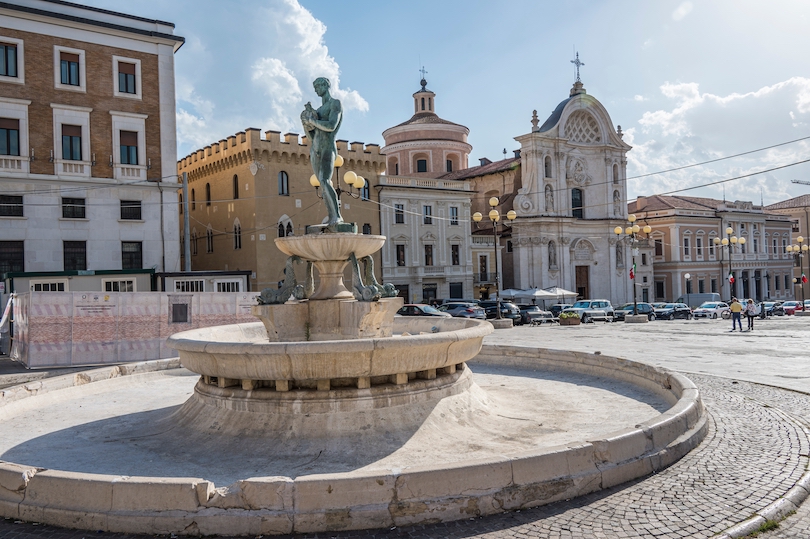
As the capital of Abruzzo, there’s no missing L’Aquila. The town’s center is surrounded by medieval fortress walls while the broader landscape has a different kind of encasing. Just beyond L’Aquila are four towering peaks.
Set in a beautiful yet small valley, L’Aquila is laden with history, gorgeous architecture, cultural highlights, and amazing food. The town’s well-kept buildings feature Renaissance and Baroque-style facades, and behind each door lies something more captivating.
L’Aquila’s rich heritage has survived into the modern era. Conservatories, symphonies, churches, and historic academies peel back the curtain on life here, long before the 21st century. A highlight is the National Museum of Abruzzo. Housed in the 16th-century San Giorgio castle, the museum focuses on pre-Roman era artifacts, Renaissance works, and historic religious art.
1. Abruzzo National Park
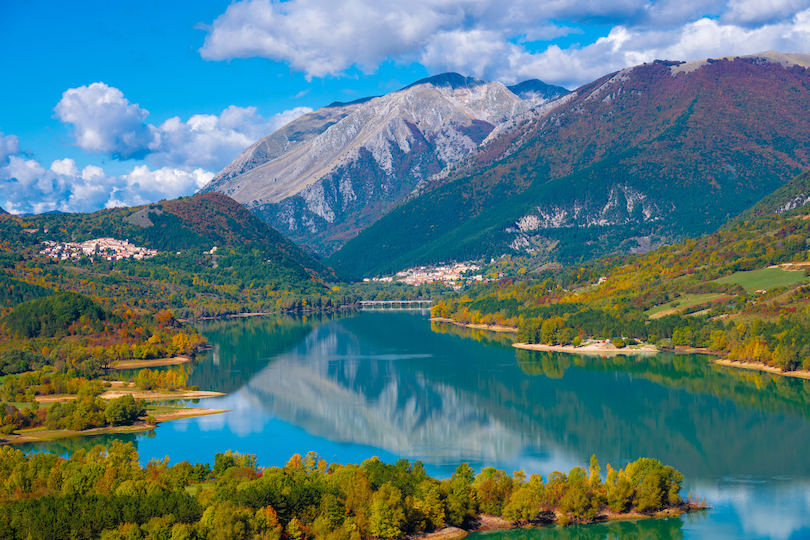
Wild animals, epic hikes, and ancient history come to the fore in Abruzzo National Park. In Italy’s most protected region, this national park is the centerpiece. Just two hours from Rome, you’ll feel a world away, in a raw paradise where bears and wolves linger.
Spotting either is not an easy task. But in such a wild and lively landscape, evidence of both lies around every corner. Thus, Abruzzo National Park is a perpetually unfolding journey. One you can embark on along the park’s well-maintained trail system.
Guided or on your own, seek out the hundreds of miles of trails that lead you into a wilderness where evidence of human interference becomes almost null. The primeval forest full of beech tree words hides various ecosystems and mountain huts fit snugly within the surrounding landscapes.
The park’s huts are the perfect spot to kick back after a day of exploration. Hosts cook up a feast of Abruzzo cuisine, which is notoriously hearty.
Map of Places to Visit in Abruzzo, Italy
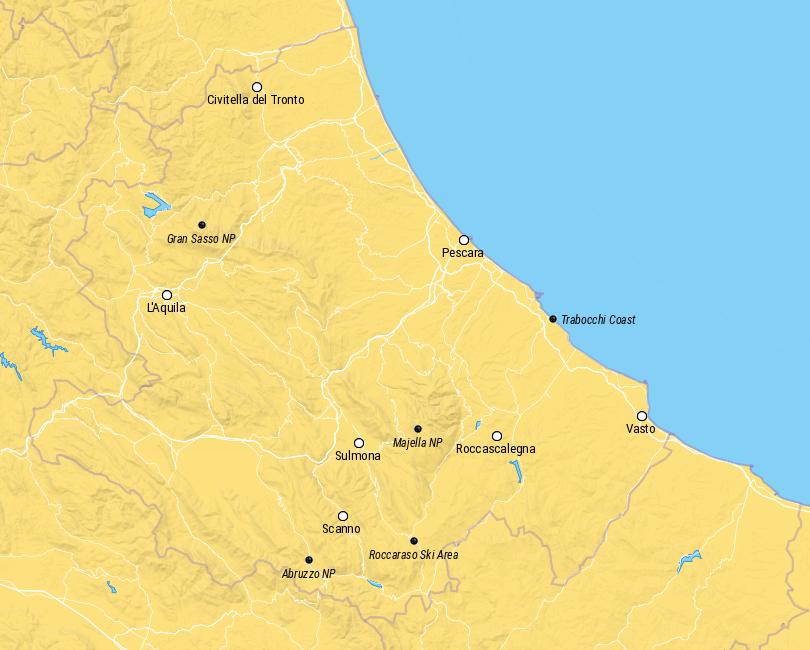
Share this post:
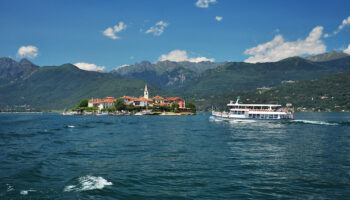
14 Best Places to Visit in Lombardy, Italy
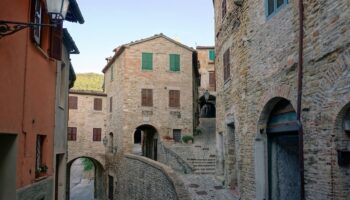
14 Best Places to Visit in Marche, Italy
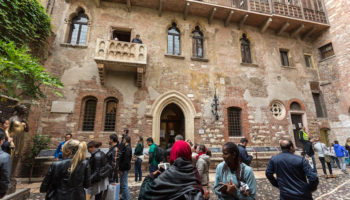
12 Best Things to do in Verona, Italy
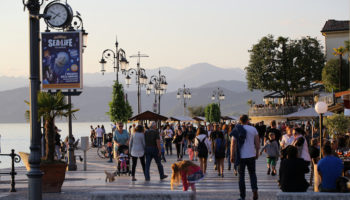
Where to Stay in Lake Garda: Best Towns & Hotels
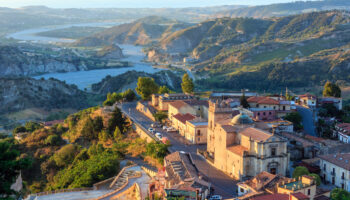
12 Best Places to Visit in Calabria, Italy
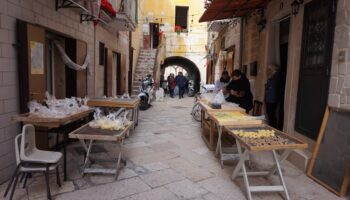
14 Best Things to do in Bari, Italy
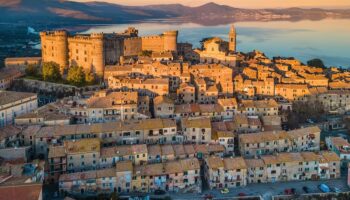
14 Best Places to Visit in Lazio, Italy
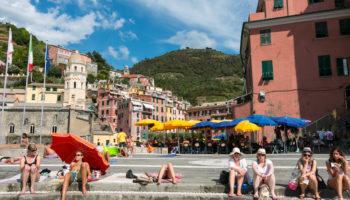
Where to Stay Cinque Terre: Best Towns & Hotels
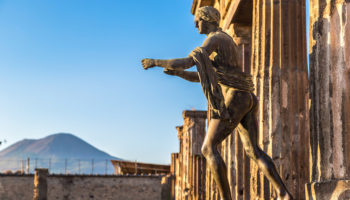
10 Most Fascinating Ruins in Pompeii, Italy
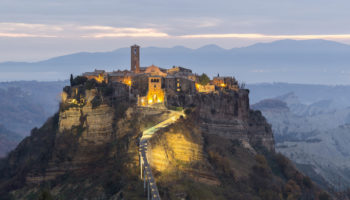
14 Gorgeous Small Towns in Italy
Reader interactions, leave a reply cancel reply.
Your email address will not be published. Required fields are marked *
This site uses Akismet to reduce spam. Learn how your comment data is processed .

- What to see in Abruzzo: 10 unmissable places
- Places and Tours
What to see in Abruzzo ? Between mountains, national parks, and villages to discover, you will be breathless. Come and discover it with us.

Abruzzo is one of the Italian regions where it is possible to admire the spectacular strength of Mother Nature . Lakes, mountain rivers, nature reserves. But the region of Abruzzo is also a land rich in history, an important bastion of the Kingdom of Naples on the border with the papal possessions. So are you ready for our adventurous journey?
10. The Fortress of Civitella del Tronto: on the edge of the kingdom
.jpg)
The Fortress of Civitella del Tronto (Teramo) is one of the most important engineering works on the Italian peninsula. Built from the fifteenth century by the Aragonese, the Fortress was later enlarged and modified by the Spanish Habsburgs and the Bourbons, representing an important bastion on the border between the Spanish Viceroy and the Papal State. Currently the structure is entirely viable and houses an interesting Museum of Weapons.
9. The Gran Sasso and Monti della Laga National Park: the force of nature

For nature lovers and hikers, the ideal destination to reach is the Gran Sasso and Monti della Laga National Park, the third largest in Italy. Here you can admire the typical animal species of the area, such as the Apennine wolf, the Abruzzo chamois and the Marsican brown bear. Here you can forget about the chaos of the metropolis, among snow-capped peaks and endless meadows...

8. The Majella National Park: between History and Nature

The Majella National Park is another unmissable event for nature lovers traveling to Abruzzo . The park, established between 1991 and 1995, extends between the provinces of Chieti, L'Aquila and Pescara and offers a vast range of attractions. From the scenic beauty of the Apennines, to the historical and archaeological ones, the park offers a vivid and deep cross-section of Abruzzo history and nature.

7. The abbey of San Giovanni in Venere: the triumph of Christianity

For lovers of art and monuments, the trip to Abruzzo will certainly have as its goal the Abbey of San Giovanni in Venere in Fossacesia, in the province of Chieti. The great monastic complex, which owes its name to a pre-existing pagan temple dedicated to Venus, has a rich and articulated construction history, from the interventions promoted by the hermit Martino in the 6th century, to those sponsored by the abbot Oderisio in the XII.
6. The National Park of Abruzzo, Lazio and Molise: respecting nature

The National Park of Abruzzo, Lazio and Molise , is one of the most important and ancient natural reserves of the Italian peninsula. Its history, in fact, begins way back in 1917, to reach our days. His mission? Preserve, enhance and promote the precious Abruzzo natural heritage. What are you waiting for then? Backpacker and packed lunch, and watch the Marsican bear!
5. The strength of the spirit: the hermitage of San Bartolomeo in Legio

The hermitage of San Bartolomeo in Legio is one of the most evocative and mystical places in the Abruzzo region. The hermitage is located in the municipality of Roccamorice (Pescara) surrounded by the Maiella and Morrone woods. The building was built in the 13th century by Pietro da Morrone, the future Pope Celestino V, who lived there with some disciples between 1274 and 1276. Here you will deeply feel the strength of the spirit and faith...
4. The National Museum of Abruzzo: history of a region

For those wishing to learn more about the history of the Abruzzo region, a must is a visit to the MuNDA, the National Museum of Abruzzo . The museum is now temporarily housed in the former slaughterhouse of Borgo Rivera, in the presence of the magniloquent Fontana delle 99 cannelle, waiting for the restoration of the original site to be completed: the 16th-century Castle of L'Aquila, nicknamed the Spanish Fort, where, in its 41 rooms, the story of an entire region was told.
3. In the bowels of Abruzzo: the Stiffe caves

If you want to penetrate the deepest bowels of the Abruzzo region, to fully grasp its vital breath, you should definitely visit the Stiffe Caves (L'Aquila). Among the most important karst phenomena of the Peninsula, the Stiffe Caves are hundreds of thousands of years old, and have a depth of several hundred meters ... Arm yourself with compasses and courage and have a good trip!
2. The Calanchi di Atri Nature Reserve: the wounds of Abruzzo

Among the many wonders that Abruzzo offers us, among the most characteristic, is the Calanchi di Atri Nature Reserve , in the province of Teramo. The Calanques are a particular phenomenon of soil erosion, and appear as huge and deep furrows on the side of mountains and hills. But in spite of the arid conformation, the Calanques are rich in animal species and vegetation: badgers, porcupines, tamarisks, licorice, etc ...
1. The Heart of Abruzzo: Lake Scanno

If you are in Abruzzo and you want to visit a fabulous place, your ideal stop is surely the lake of Scanno (L'Aquila), set between the Marsican mountains and the valley of the Sagittarius river. Here you will feel the divine presence of Nature like nowhere else, here you will find yourself, in contemplation of such wonders. And if you pay attention, you will see that the lake has the shape of a Heart ...
We recommend

You’ve probably never been to…Italy’s Abruzzo National Park. Here's why you should

Dec 20, 2022 • 7 min read

Experience one of Europe's rewilding projects in Italy's Abruzzo National Park © Francesco Riccardo Iacomino / Getty Images
In Rome, tourists swarm into the ruins of ancient temples, jostle for selfies and stand in line for restaurants. But just two hours away, the hills and valleys are empty and the only wait you have is in hope for a sight of an elusive bear or wolf. This is Italy ’s Abruzzo National Park, a triumph of conservation and rewilding in both Italy and Europe.
In the entirety of the Abruzzo region – of which the national park is only a portion – just 1.3 million tourists visited in 2021, with far less making the journey from Abruzzo’s gorgeous coastline inland to the park. The result is that outside the high summer season , it’s completely possible you might hike for the day without passing anybody else.
Here are the best things to do in Abruzzo National Park.

Look out for the local wildlife: bears, wolves and deer
Abruzzo National Park is one of the best places in Italy to spot large animals and makes a strong contender for the best in Europe. When it comes to advertising the park, however, there is one superstar and that’s the Mariscan brown bear. Smaller and less aggressive than their fearsome North American counterparts, they are literally the icon of this area, appearing on the park logo and on statues in Pescasseroli, the main town of the park.
Walking with my guide Andreas from Wildlife Adventures, he described the park as a “heaven for bears” thanks to an abundance of good food. They can be difficult to spot due to being largely solitary creatures but evidence of them is everywhere if you know where to look. Over the course of five days, Andreas regularly pointed out tree trunks that were used by bears to rub against, finding hairs still trapped in the wood.
A slightly more contentious inhabitant of the park is the Italian wolf. There are many farmers in the region that dislike sharing space with them. We met a local farmer who lost cattle due to wolves and even pointed out a calf who was still recovering from painful injuries sustained from a wolf attack. But the wolves are a huge draw for people. For many visitors, especially from urban areas, Andreas said they tend to view wolves almost as puppies. Despite his own deep love of the animals, he takes a more neutral standpoint: “I think the truth is something in between.”
Recent reports say the wolves are not showing as much fear around humans as they were before, something of a “shifting point in their attitude towards us”. There was even a biting incident recently near the Abruzzo coast after a tourist cornered a wolf. However, the biggest problem is often other humans, in particular the desire to get close to get the "perfect" picture. If people are lucky enough to spot the wild animals one day, they will often tell their friends who come back and, perhaps, take more risks in order to get the same experience.
Despite the long days and good weather, it can sometimes be more difficult to see wolves in the summer because the pack splits while in winter they travel together. The last intensive survey of wolves in the park estimated there to be about 10 packs, with between 60 and 70 wolves in total.
Still, there is no shortage of animals to see. When I visited, we were lucky enough to be treated to two spectacular displays of red deer in the early mornings. The males bellowed loudly, their noisy display the first step in warning other males against approaching some females in the area. Despite that, some persisted and the sight of them locking antlers in the early morning sun, at the side of a mountain, was spectacular.
The best time to go wildlife watching is very early morning or at sunset. While waiting, it’s a beautiful opportunity to slow down and really take in the landscape. And if you don’t spot anything? “That’s part of the game!”, jokes Andreas.
Want some help? Let Elsewhere plan your next trip
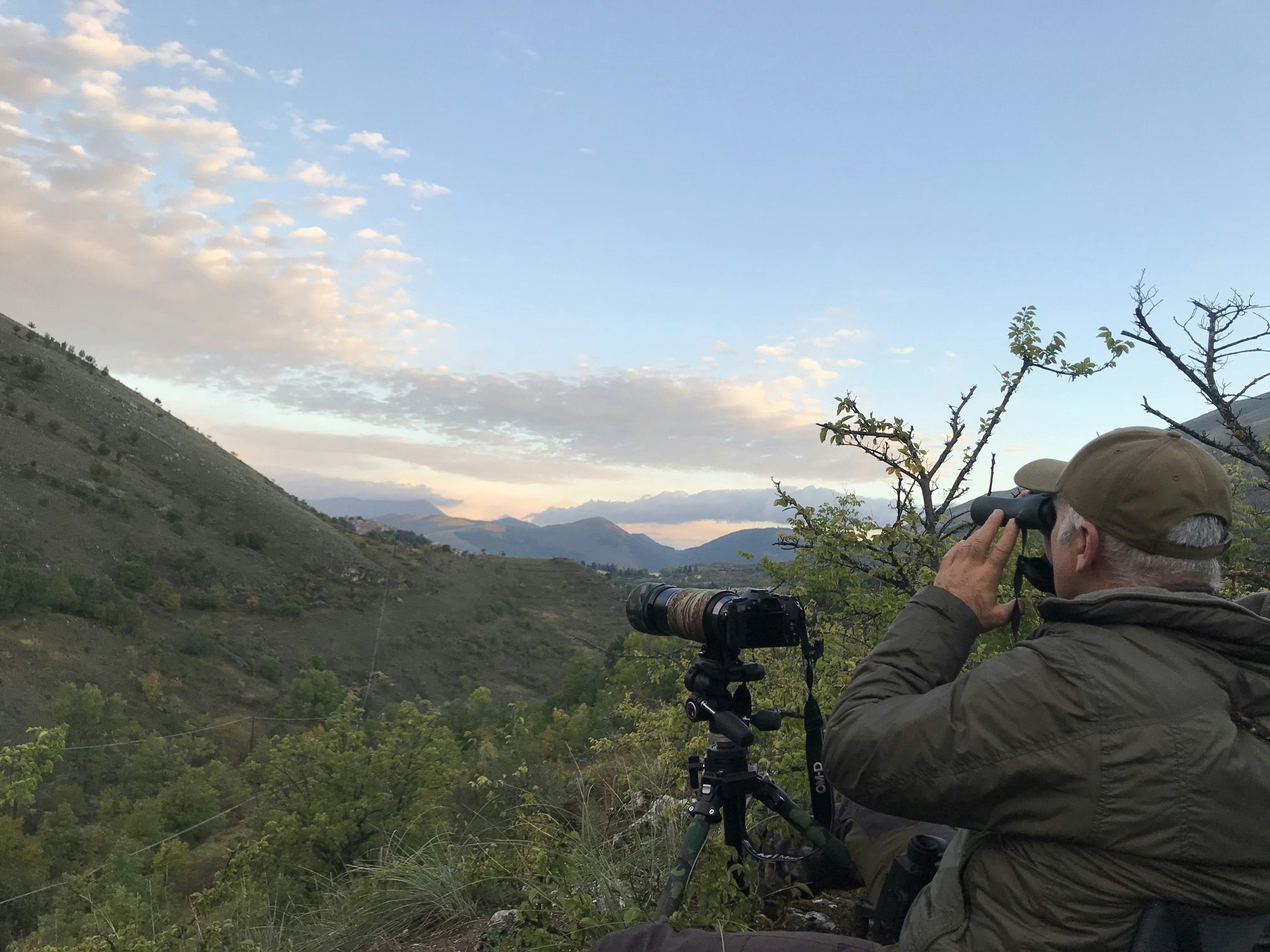
Witness a gradual rewilding during a rewarding hike
When not waiting for the animals, there are nearly 150 well-marked hiking trails for you to explore, covering an incredible 750km (466 miles) in total. If you’d prefer to not hire a guide, a full list of trails is available on a map you can pick up from any local tourist office.
However, with a bit of expert help, you can more deeply appreciate the gradual rewilding of the park. Intensive forest management ended 50 years ago but the landscape is still feeling the effects of it today. Trying to optimize the land for agriculture meant plenty of space was kept between trees to ensure there was enough shade for grazing animals, as well as space for them to eat. Now the trees are gradually closing the gap and Andreas estimates that maybe in 100 years, without intervention, it will resemble a primeval forest once again. Beech tree woods cover about 60% of the park today.
In the meantime, it is a joy to trek through, spotting the slow re-encroachment of nature, imagining what it might have been like in the past and what it may look like again. Even the fallen or dead trees are left here to add to the ecosystem, fungus and seeds appearing on them like mini-universes. Good mushrooms often appear when trees are about to die. Bring your attention and slow down to really take in all these details.
Stay in a mountain hut
We spent one night in Rifugio Terraegna , a hut high up in the mountains that can accommodate groups of up to ten people. With comfy beds and some limited electricity from solar power, it has everything you need for a short stay and our host Valeria cooked a delicious three-course meal, with some organic local red wine also available to purchase. Afterwards we all told stories about some of our favorite moments in nature, one that brought a touch of magic to our lives.
There are plenty of rifugios (refuges or shelters) dotted around the park with varying degrees of luxury. Booking ahead is recommended.
Indulge in Abruzzo's local cuisine
During your wild wanderings, you may sometimes forget you’re in Italy but you’ll certainly remember when it comes to dinner. Abruzzo is famous for hearty takes on Italian classics . The region is famous for lamb and the arrosticini sheep skewers are a local delicacy, although the meat will be used in any number of delicious dishes for your secondo, including agnello cacio e ovo (lamb covered in a lemon, egg and cheese sauce) or mutton stew. If you’re so inclined, everything is best washed down with some Montepulciano d'Abruzzo, the most famous wine of the region.

Check out the Visitor Centre and sanctuary
Pescasseroli is the headquarters of the park and the Visitor Centre is a sanctuary for a couple of injured bears and other wild animals. A lot of the displays are only in Italian but at least you’re guaranteed to spot some animals if your wildlife-watching has been a bit disappointing. It's not an essential stop but we passed a particularly wet afternoon there quite pleasantly and it was my only sighting of a bear in the park.
How to get to Abruzzo National Park and where to stay
Pescasseroli is the main town in the park and the most popular base to stay in if you want to remain within the park bounds. It has the most choice of accommodations and places to eat, as well as some charming lanes to explore in your downtime. If you want to stay near the coast and don’t mind a longer drive, Pescara is a good option.
It’s a two-hour drive from Leonardo DaVinci airport to Pescasseroli. It’s probably too long a drive – with far too many things to do – for a day trip but it’s certainly doable in a weekend trip from Rome (although you will certainly fill more days if you’d like to, particularly if you’re a nature-lover).
If you are traveling independently, a car is your best bet, both to get there and also to ensure you have full access to the beginnings of the trails and the best wildlife watching spots. There are bus connections from Rome via Prontobus to the town of Avezzano.
AnneMarie traveled to Abruzzo National Park on the invitation of Much Better Adventures.
Explore related stories

Jan 11, 2024 • 8 min read
Italy has so many delights for visitors, it’s hard to know where to start. Lucky for you, we’ve made this list of the best experiences all over the country.

Feb 18, 2021 • 2 min read
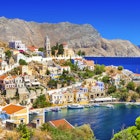
Aug 25, 2020 • 8 min read
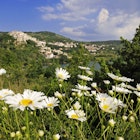
Apr 4, 2017 • 4 min read

Apr 25, 2024 • 7 min read
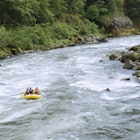
Apr 27, 2024 • 6 min read

The Best Reasons To Visit Abruzzo, Italy
Do you want to visit Abruzzo, Italy?
The Central Italian region of Abruzzo is perched in the Apennines and the Adriatic coast, just a couple of hours away from Rome .
Abruzzo’s capital, L’Aquila (“The Eagle”), is a lively college town with numerous cultural institutions.
Food and wine tourism makes Abruzzo a destination of choice. It is home to the world-renowned Montepulciano d’Abruzzo wine, one of the best Italian red wines . The region is also where you can find the capitals of confetti , ceramics, and Italian pasta.
Abruzzo also boasts fabulous lakes, breathtaking mountain ranges , fantastic medieval hamlets and villages, and the Adriatic coastline.
Table of Contents
Let’s dive into the must-see attractions in Abruzzo, Italy.
1. The Trabocchi Coast

Truly one of the best reasons to visit Abruzzo, the trabocchi have always been associated with the region. A UNESCO World Heritage Site , the Trabocchi Coast is named for its collection of trabocchi, old fishing platforms that have been in use here since the 15th century.
Dotting the 70-km coast from Ortona to San Salvo, these trabocchi are surely the star attraction of the place.The coast also houses one of Europe’s longest cycling lanes so if you’re an enthusiast, this makes it even more enticing.
The Trabocchi Coast is a lovely place for relaxation away from the crowds. It has plenty of public beaches from the Ortono area to San Vito Chietino and Fossacesia to Vasto, so there’s no running out of emerald waters and pebbles to enjoy.
Wear the right shoes for walking and swimming when you go to the Trabocchi Coast – one of the best places to visit in Abruzzo!
2. Abruzzo’s Three National Parks
With Abruzzo’s 38 protected nature reserves, three national parks, and one regional park, Abruzzo is dubbed “the lung of Europe.” The three national parks cover over half of the entire region. Their dramatic hiking trails are a joy to discover and truly among the best things to do in Abruzzo.
• Gran Sasso National Park

Locals call it “little Tibet” – and for good reason. The terrain is mountainous with alpine plains and marvelous rock mountains with tons of trails to hike as you enjoy the breathtaking views.
During World War II, Mussolini was detained in Gran Sasso for a short time. You can still see the room he stayed in before the Germans came and rescued him.
• National Park of Abruzzo, Lazio, and Molise

One of Italy’s most important national parks, the National Park of Abruzzo, Lazio, and Molise, is also the oldest. It was established in the early 1920s to protect nature and to save the Marsican brown bears and Apennine chamois from extinction. Here’s your chance to see these beautiful native Italian animals .
• Majella National Park

Majella National Park was declared a UNESCO Global Geopark in 2021. It is a paradise for climbers and hikers. Its upland meadows and the Orfento Valley are among the most beautiful and biodiverse spots you’ll ever see in Europe.
3. The Beautiful Lakes
The region is also never short of bodies of water as points of interest. These are among the must-see attractions in Abruzzo.
Here are three of the best lakes you can visit in the region.
• Lake Scanno

A beautiful mountain lake with a lovely shade of bright blue-green that shimmers in the sunlight, Lake Scanno in the province of L’Aquila is the region’s largest natural lake.
it is noted for its shape that resembles a heart and is deemed one of the best lakes in Italy . It is a great place for walks and picnics.
To see Lake Scanno’s beauty from the top, head to the trail leading to a quaint little church that overlooks the lake. This church is built right into the rockface and a must-visit when in Lake Scanno. After descending, you can rent a nice paddle boat right on the lake to enjoy the most of Lake Scanno.
There are amenities on both sides of the lake. You can go grab some snack or a meal at the bar. There’s also lots of nice spots for a picnic.
• Lake Barrea

This one is an artificial lake located within the National Park of Abruzzo, Lazio, and Molise. It’s small but offers spectacular views of the mountains and the town of Barrea.
With its emerald green waters and the Apennines , Lake Barrea is the stuff postcards are made of.
Here you can also enjoy plenty of activities from swimming to paddle boats and sunbathing – even horseback-riding!
The added bonus is a marvelous snack or meal at the restaurant that offers the most authentic mouth-watering Italian meals you’ll ever have.
• Lake Campotosto

Lake Campotosto is a man-made artificial lake in the Gran Sasso National Park.
On a good weather, you’ll be lucky to see the sky mirrored in the blue-green water of the lake.
The landscape is fantastic in every season, with the surrounding mountains adding to the already overwhelming beauty of Lake Campotosto.
Lake Campotosto offers an excellent opportunity for pet walks, trails, or baths in the lake. This is also a perfect place for camping and barbecues.
A lake so vast it looks like a sea with the spectacular views of the Gran Sasso reflected in the water, if this one’s not a gem then I don’t know what is. One of the absolute must-see attractions in Abruzzo!
4. The Caves and Caverns of Abruzzo

One of the most exciting things to do in Abruzzo is exploring its caves and caverns. The region is rich in well-maintained river caves. Here are some of them:
• Grotti dei Stiffe
You will absolutely love this karst cave system’s colorful rock formations and waterfalls. These caves are set on a mountain in Stiffe so you can also enjoy spectacular views of Abruzzo on your way up.
It can get really cold inside the caves so bring a light jacket.
• Grotta del Cervo
Grotta del Cervo in Carsoli is a natural coastal cave housing the most impressive Neolithic painting complex in Europe. This is a must-explore!
• Grotte di Beatrice Cenci
The western Marsica area offers a good number of caves to choose from.
The Caves of Beatrice Cenci in Cappadocia are some of them. This complex of karst caves and sinkhole will leave you breathless.
5. The Beautiful Medieval Towns and Villages of Abruzzo
Some of Italy’s most fantastic medieval villages are found in Abruzzo – villages which, if in Tuscany , would be crowded with tourists.
These Abruzzese borghi are all situated on the top of a hill (or hills) with a church and a piazza town square – and those enchanting houses and all with sweeping views. Here are some of the prettiest villages and best places to visit in Abruzzo.
- Also read : 13 Prettiest Towns in the Apennines

The medieval town of Sulmona is not only famous for being the birthplace of Ovid but for confetti as well.
However, the confetti in Italy is not the confetti that non-Italians know. The confetti which Sulmona is known for are glazed almond candies given away on baptisms, weddings, and other important family occasions.
The charming town is surrounded by mountains and offers tons of attractive sights such as Baroque monuments and Roman remains, grandiose churches, and a museum dedicated to confetti .
• Pietracamela

A stunning medieval village in the province of Teramo, Pietracamela – La Pròtë to locals – boasts equally stunning views of the mountains around it.
This village is nestled smugly at the foot of the Gran Sasso massif, allowing for great summer walks and fabulous winter skiing, so it’s a perfect borgo to visit anytime of the year.
• Rocca San Giovanni

Medieval walls and ancient buildings and churches make up the Rocca San Giovanni village in Chieti. It is perched on top of a rocky hill overlooking the coast of Trabocchi, so imagine the spectacular scenery!
Lovely olive groves and panoramic vineyards also surround the village.
Once selected as one of the “Most Beautiful Towns of Italy,” Penne in the province of Pescara sits on top of four large hills between the Apennines and the Adriatic Sea.
The rustic town offers that authentic Italian feel we crave when visiting Italy.
Must-do when in Penne is strolling the cobbled streets that will take you to its gorgeous piazzas and splendid churches and palaces.
The medieval hill town of Castelli in Abruzzo’s Teramo province is one of Italy’s best. It offers spectacular views of the Gran Sasso and is best known for the decorative ceramic called maiolicas .
Castelli is a favorite destinations among tourists and art lovers. The town hosts an art institute and ceramics museum if you want to learn about this Italian tradition.
Don’t forget to visit any of the many ceramics shops for maiolica souvenirs.
6. Abruzzo’s Amazing Churches and Sanctuaries
A visit to any city of Italy is not complete without seeing one or more of its incredible churches and cathedrals.
Abruzzo is home to a good number of amazing churches and sanctuaries, being so near the Holy See in Rome . L’Aquila alone has about 60 churches, reduced from at least 80 (although legends say it was 99) by a succession of earthquakes in the past.
Let’s take a look at some of Abruzzo’s amazing churches and sanctuaries.
• Sanctuary of Our Lady of the Lightning – Massa d’Albe, Italy
Located in a hamlet of Massa d’Albe in the L’Aquila Province, right on the slopes of Abruzzo’s Apennines, a small but miraculous sanctuary is flocked by pilgrims every 29th of April.
Sanctuary of Our Lady of the Lightning ( Madonna del Fulmine ) is well worth a stop, with the Roman town of Alba Fucens close by for the Roman ruins and the glorious Monte Velino in the background.
• Santuario del Volto Santo – Manoppello, Italy

This Capuchin church in the province of Pescara is popular among pilgrims as it houses the Holy Face of Manoppello. Here you can spend the whole day just looking at the Jesus Christ’s face at the moment of His resurrection.
• The Church of Santa Maria Assunta and the Oratory of San Pellegrino – Bominaco, Italy
Definitely one of Abruzzo’s best hidden gems, the Church of Santa Maria Assunta actually comprises of two very different churches – plus, the remains of a castle.
All these were part of a powerful monastery from the 8th century, which was destroyed in the 15th century.
The Romanesque church with its frescoes is perched on the hill above the small hamlet of Bominaco. The smaller chapel called the Sistine Chapel of Abruzzo also boasts equally important frescoes.
8. Abruzzo’s Vineyards and Signature Wines
Abruzzo produces over 22 million cases of wine annually. It takes pride in its three signature wines made from grapes cultivated in some 30,000 hectares of the region’s vineyards .
• Montepulciano d’Abruzzo

The iconic Montepulciano d’Abruzzo is a red wine made from the Montepulciano grape grown in the region. It has pepper and spice notes and is described by some connoisseurs as “rustic.”
• Trebbiano d’Abruzzo
Trebbiano d’Abruzzo is the region’s dry white wine made from Trebbiano Abruzzese grapes.
Abruzzo makes some 14 million liters of this wine each year. Along with Abruzzo’s red Montepulciano, Trebbiano d’Abruzzo is one of Italy’s most widely-exported DOC wine.
• Cerasuolo d’Abruzzo
An Italian rosato (rosé) made from Montepulciano grapes, characterized by its bright flavor and cherry-red color which is behind the name Cerasuolo (“cherry”).
Vineyards To Visit:
Antica Casa Vitivinicola Italo Pietrantonj in Sulmona is a must-see wine making estate in the province of L’Aquila.
In Chieti, Sambuceto’s small winery and organic farm called Teatina is highly rated by visitors for their hospitality and wide array of wine options – whites , red , and rosés .
8. Abruzzese Traditional Dishes

Abruzzo’s traditional cuisine is a trove of gastronomic treasure. Partaking in the regional dishes is definitely one of the best things to do in Abruzzo. However, picking just a few for this list is a hard feat, but let’s get to it.
• Maccheroni alla Chitarra
Fara San Martino, the capital of Italian pasta, is at the foot of Majella in the province of Chieti. It is home to the world-famous pasta brands like De Cecco and Delverde.
Pasta dishes in Abruzzo are aplenty, but the most popular is arguably the “guitar pasta,” locally known as maccheroni alla chitarra . The pasta used is made with egg and semolina flour, with the dough cut into large square-shaped strands using a guitar-shaped tool.
Maccheroni alla chitarra or spaghetti alla chitarra is served in the traditional sauce made with tiny meatballs of mixed meat. It’s an absolute must-eat!
- ALSO READ: 13 Famous Pasta Brands in Italy
This one’s a bouillabaisse-type fish soup, seasoned with fresh tomato, herbs, and various spices.
• Arrosticini
In Abruzzo, arrosticini or lamb skewers are called arrustelle or rustelle and spiducci or spiedini . They are cooked on a special barbecue grill called furnacella and often served with bread slices soaked in extra-virgin olive oil.
Arrosticini are one of the best street foods you should sample when in Italy .
• Pizza Scima
“ Pizza scima” literally means “stupid pizza.” The sole reason for the curious name is the lack of yeast. So pizza scima is basically an unleavened bread which goes best with salami and cheese shavings.
9. The Festivals and Events in Abruzzo
I love how Italians celebrate just about everything. This is evident in the numerous festivals found in many towns and cities all over Italy.
You will sure be delighted to join any of these and if you’re a bit more into the aventurous side, Il Bel Paese sure has some of the world’s craziest festivals you might be interested in. Abruzzo boasts some of them. Read on.
• La Giostra Cavalleresca di Sulmona – Sulmona, Italy

Sulmona’s La Giostra Cavalleresca is a five-day knightly jousting contest that starts on the last Saturday of July each year. This is an ancient celebration the people of Sulmona revived in the early 1990s. Witnessing it is absolutely one of the best activities in Abruzzo!
As per Italian festival, this one is also filled food. It’s your chance to sample some of Abruzzo’s street foods as you party with the locals in the city’s most popular event.
• The Festival of the Snake Catchers – Cocullo, Italy

If you have a penchant for snakes or are simply looking for something exciting to partake in on the first of May in Abruzzo, well, this one’s for you.
The Festival of the Snake Catchers (Festa dei Serpari di Cocullo) takes place in the mountainous village of Cocullo in the province of La’Aquila. It’s one of Italy’s most unique festivals ever and truly one of the very interesting reasons to visit Abruzzo.
This celebration is held among the Majella Mountains, where snake handlers or serperi carry hundreds of non-venomous snakes caught in the wild and parade them through the medieval streets of Cocullo.
Some of these snuggly worms are wrapped around a statue of the town’s patron saint – San Domenico di Sora, who is also the patron saint against snakebite and toothache.
The Festival of the Snake Catchers is an annual celebration in honor of San Domenico, to thank him for ridding the local fields of snakes in the 1200s.
The snakes are released back into the wild after the parade.
• Altino Sweet Pepper Festival – Altino, Italy

Festival del Peperone Dolce di Altino is celebrated in late summer, the last week of September.
It’s the time of year when this small town in the Chieti Province comes alive with festivities involving street performances and locals dishes strictly based on Altino’s sweet peppers.
This fun food festival features a culinary contest between the districts of Altino, each of which should come up with original yummy recipes using sweet peppers. Winning recipes are revealed at the end of the festival.
In the meantime, before winners are announced, people can buy these foods using the €peperone or pepper Euro.
The Altino Sweet Pepper Festival lasts for two days and is concluded with fireworks and more music.
Check Out These Abruzzo Group Tours:
Where to stay in abruzzo, italy.
Explore Abruzzo
Plan your trip to abruzzo: best of abruzzo tourism.

Essential Abruzzo

Trending in the forums
Abruzzo Is Great For
Dining experiences.

Art & history

Wine Tastings

Sand & surf

Cooking Classes

- Parco Nazionale d'Abruzzo
- Corno Grande
- Parco Nazionale della Majella
- Chef Interviews
- Restaurants and Dining
- Specialty Food
- The Hamptons
- New England
- Interior Design

How to Ensure Your Kids Have Fun on Your Next Trip
Traveler’s treasure trove: 6 self-storage tips for jet-setting adventurers, maximizing your culinary adventures: a guide to sustainable eating while traveling, how to safeguard your caravan adventure from unforeseen events, a local food guide to bologna, italy’s food capital, 15 essential north fork restaurants, 11 foods to try in the yucatan | yucatan food guide, the best bakeries in london, a timeless european journey: italy, france, and the uk, top day trip destinations from birmingham by train, planning your entertainment for a uk getaway, pet friendly hotels across the hamptons, restaurants that serve brunch on the south fork year round, 12 essential hamptons restaurants, hamptons passover and easter restaurant dining specials, coffee shops to know across the hamptons, where to stay on shelter island, get to know the beaches on the north fork, the must-try brunch restaurants on the north fork, top 10 family-friendly wineries on long island, the best way to spend 24 hours in bellport, best family friendly summer activities on cape cod (besides the beach), gurumé korean tapas bar launches in manhattan’s theater district, a guide to the gold coast mansions of long island, meditation practices for developing awareness of trigger patterns, maintaining optimal eye health made simple, the role of negligence in florida personal injury claims, the variables that can make or break your retirement goals, the best 2-day travel itinerary for abruzzo, italy.
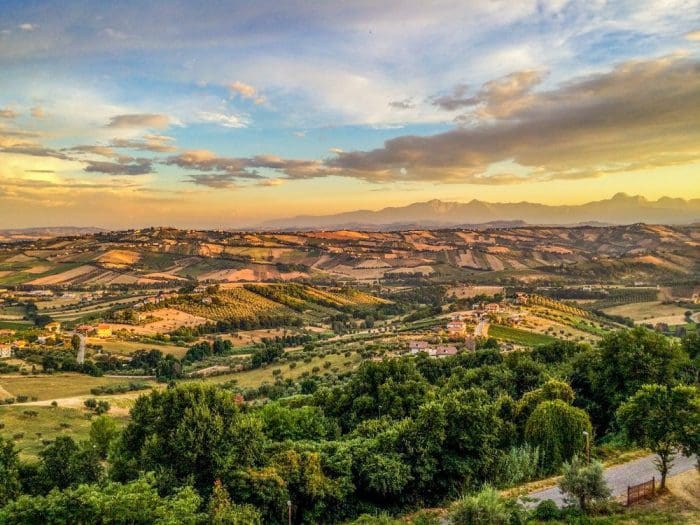
Abruzzo is a region of central Italy that boasts stunning landscapes ranging from the Apennine Mountains to the Adriatic Sea. The region is rich in history, culture, and traditions, and it is renowned for its excellent cuisine, wine, and hospitality. Here is a suggested two-day travel itinerary for Abruzzo, including tips on how to travel from Rome, the best places to visit, the best food to try, and where to stay.
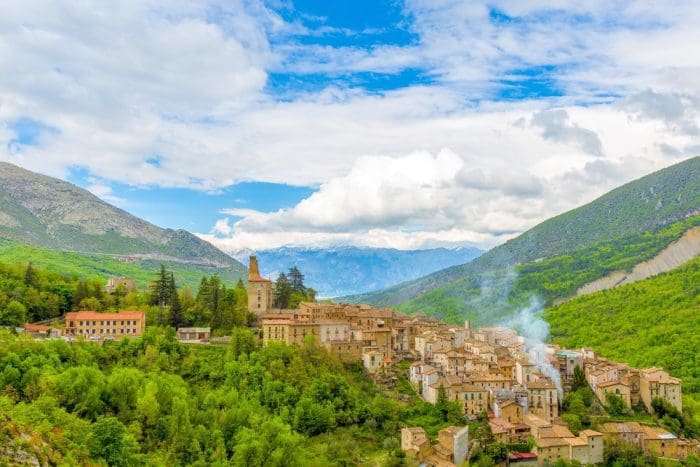
The easiest way to travel to Abruzzo from Rome is by train or car. If you choose to take the train, the journey will take about two hours, and you can catch a train from Termini station in Rome to Pescara station in Abruzzo. If you prefer to drive, it will take approximately two and a half hours, and you can take the A24 highway.
Sulmona is a charming town located in the heart of Abruzzo, famous for its sugared almond confectionery, known as “confetti.”
The town is also home to the Romanesque church of San Panfilo and the impressive Medici aqueduct. Enjoy lunch at a local trattoria, and don’t forget to try some confetti for dessert.
Scanno Scanno is a picturesque medieval town situated in the Majella National Park. The town is known for its traditional stone houses and narrow streets, and it offers stunning views of Lake Scanno. Take a stroll through the town, visit the Church of Santa Maria della Valle, and stop by the Museum of Popular Arts and Traditions.
Pescara Pescara is a lively coastal city located on the Adriatic Sea, known for its beautiful beaches, seafood restaurants, and nightlife. Enjoy a relaxing evening at the beach, dine at a local restaurant, and stay overnight at one of the many hotels in the city.

Chieti is a historic town located on a hill overlooking the Pescara River valley. The town is home to the National Archaeological Museum of Abruzzo, which showcases the region’s ancient history and culture. Visit the Cathedral of San Giustino, the Church of Santa Maria Maggiore, and the Roman Theatre.
Lanciano Lanciano is a medieval town located in the foothills of the Majella Mountains, known for its delicious cuisine and excellent wine. Enjoy lunch at a local restaurant, and don’t miss out on trying the local pasta dish called “maccheroni alla chitarra” and the traditional lamb stew.
Santo Stefano di Sessanio is a beautiful medieval village located in the Gran Sasso e Monti della Laga National Park. The village is known for its stunning views of the mountains, traditional stone houses, and the impressive Rocca fortress. Take a walk around the village, visit the Church of Santo Stefano, and enjoy a coffee at a local café.
L’Aquila is the capital city of Abruzzo, located at the foot of the Gran Sasso Mountains. The city is known for its Renaissance architecture, beautiful churches, and traditional cuisine. Enjoy a leisurely stroll through the historic city center, visit the Basilica di Santa Maria di Collemaggio, and dine at a local restaurant.
Where to stay
There are many excellent hotels and guesthouses in Abruzzo, ranging from luxury resorts to traditional B&Bs. Some of the best options include the Hotel Villa Maria in Pescara, the Palazzo Tour d’Eau.
Small Towns and Villages of Abruzzo
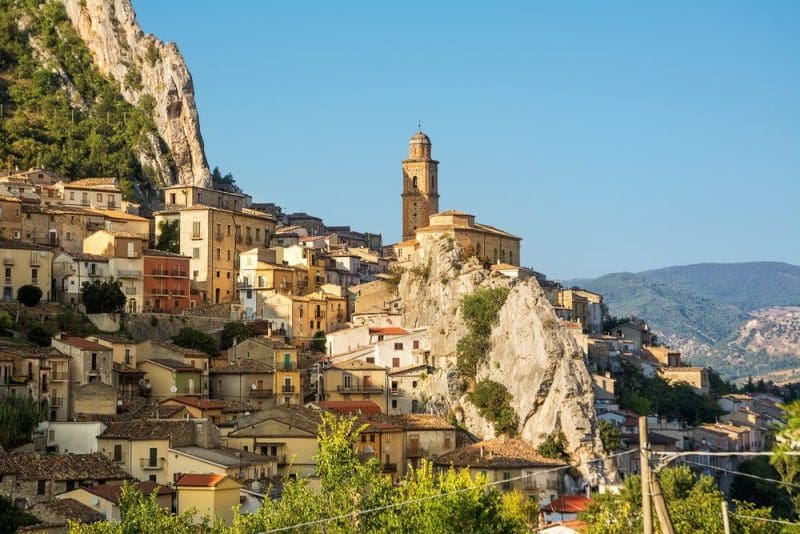
Vasto is a beautiful coastal town located in the province of Chieti, in the southern part of Abruzzo. The town is situated on a hill overlooking the Adriatic Sea, and it is known for its stunning beaches, historic landmarks, and lively atmosphere. Here is some information on what to do and see in Vasto:
Vasto Old Town
The Old Town of Vasto is a charming and picturesque area, with narrow streets, historic buildings, and stunning views of the sea. You can visit the Cathedral of San Giuseppe, the Palazzo d’Avalos, and the Museum of Sacred Art and Crypt of San Michele Arcangelo. Take a stroll through the town, explore the alleys, and admire the stunning architecture.
Vasto Marina
Vasto Marina is the seaside area of Vasto, with miles of sandy beaches, crystal clear waters, and plenty of seaside resorts, restaurants, and bars. You can enjoy sunbathing, swimming, or watersports, and sample the delicious seafood dishes served in local restaurants. Don’t miss out on trying the “brodetto vastese,” a traditional fish stew made with a variety of local fish and shellfish.
Punta Aderci Nature Reserve
Punta Aderci is a stunning nature reserve located near Vasto, with a beautiful stretch of coastline, sandy beaches, and a rocky promontory. The reserve is home to a variety of flora and fauna, including sea turtles, dolphins, and rare bird species. You can hike along the trails, explore the coves and cliffs, and enjoy the stunning views of the sea.
Trabocchi Coast
The Trabocchi Coast is a beautiful stretch of coastline that runs along the Adriatic Sea, from Ortona to Vasto. The coast is known for its unique fishing structures called “trabocchi,” which are wooden platforms built on stilts that extend into the sea. The trabocchi were used by local fishermen to catch fish, and many of them have been restored and transformed into restaurants.
Vasto Wine Tour
Vasto is also known for its excellent wines, particularly the Montepulciano d’Abruzzo and the Trebbiano d’Abruzzo. You can take a wine tour to discover the local vineyards, taste the wines, and learn about the winemaking process. Some of the best wineries in the area include Tenuta Terraviva and Cantina Frentana.
Where to Stay in Abruzzo
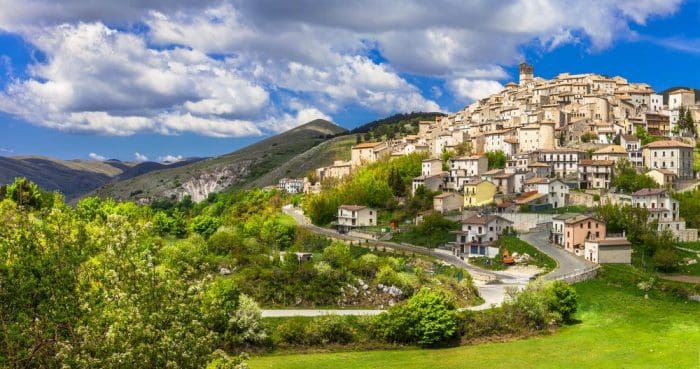
Vasto has a wide range of accommodation options, from luxurious hotels to cozy guesthouses and B&Bs. Some of the best places to stay in Vasto include the Hotel dei Sette, the Hotel Acquario, and the Hotel San Marco.
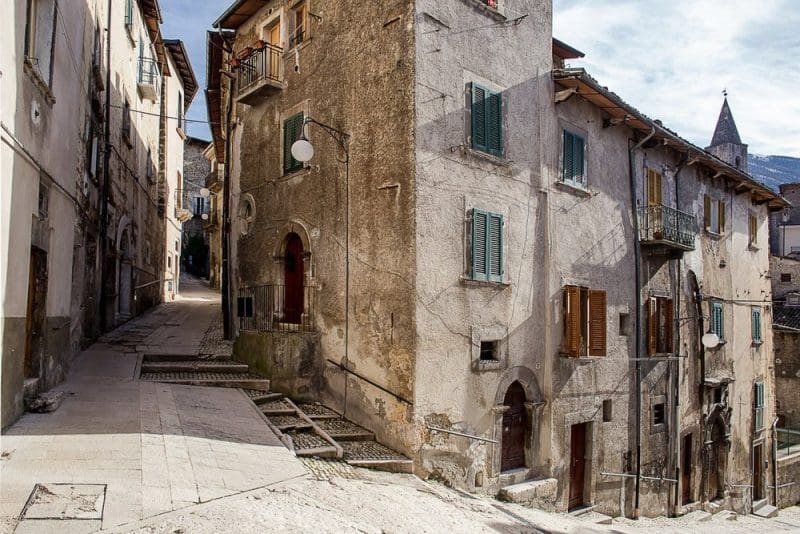
Wineries of Abruzzo
Abruzzo is known for its excellent wines, and there are many wineries in the region that offer wine tastings, vineyard tours, and other wine-related activities. Here are five of the best wineries in Abruzzo:
Cantina Zaccagnini
Cantina Zaccagnini is located in the village of Bolognano, in the province of Pescara. The winery is known for its Montepulciano d’Abruzzo, one of the most famous wines of the region. The winery offers tours of the vineyards and the cellars, as well as wine tastings accompanied by local food specialties.

How to get there
Cantina Zaccagnini is located about 30 km from Pescara. The easiest way to get there is by car or taxi.
Masciarelli
Masciarelli is a well-known winery located in San Martino sulla Marrucina, in the province of Chieti. The winery produces a variety of wines, including Montepulciano d’Abruzzo, Trebbiano d’Abruzzo, and Cerasuolo d’Abruzzo.
Masciarelli is located about 40 km from Pescara. The easiest way to get there is by car or taxi.
Tenuta Terraviva
Tenuta Terraviva is a family-run winery located in the town of Vasto, in the province of Chieti. The winery produces a variety of wines, including Montepulciano d’Abruzzo, Trebbiano d’Abruzzo, and Pecorino. .
Tenuta Terraviva is located about 60 km from Pescara. The easiest way to get there is by car or taxi.
Valle Reale
Valle Reale is located in the town of Popoli, in the province of Pescara. The winery produces a variety of wines, including Montepulciano d’Abruzzo, Trebbiano d’Abruzzo, and Cerasuolo d’Abruzzo.
Valle Reale is located about 40 km from Pescara. The easiest way to get there is by car or taxi.
Cantina Frentana
Cantina Frentana is located in the town of Rocca San Giovanni, in the province of Chieti. The winery produces a variety of wines, including Montepulciano d’Abruzzo, Trebbiano d’Abruzzo, and Passerina.
Cantina Frentana is located about 50 km from Pescara. The easiest way to get there is by car or taxi.
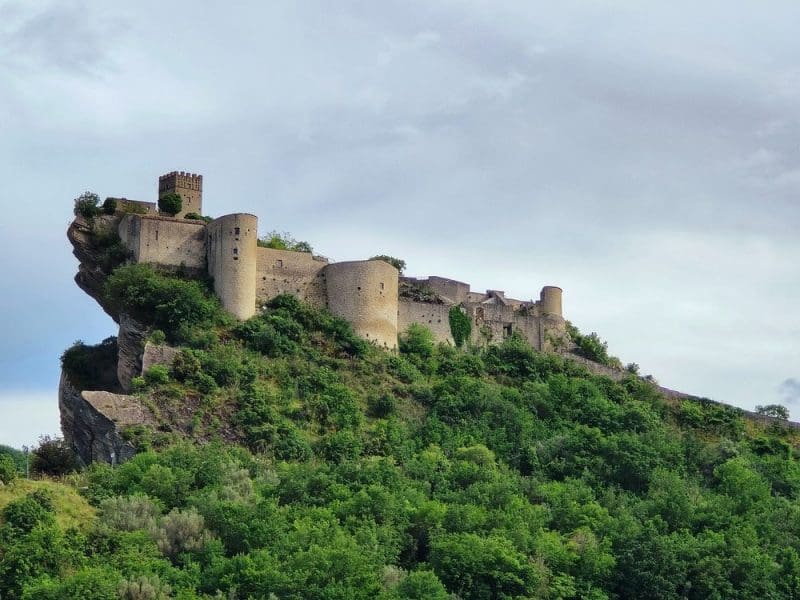
A Guide to Pecorino Wine of Abruzzo
Pecorino is a white wine grape variety that is grown primarily in the central Italian regions of Marche, Abruzzo, and Umbria. In Abruzzo, Pecorino is primarily grown in the province of Teramo. The grape produces wines with a distinct floral and citrus aroma, and a slightly herbal and mineral flavor.
Pecorino wines from Abruzzo are usually dry, with medium to high acidity and a light to medium body. They are often described as having flavors of lemon, lime, grapefruit, and peach, with a slightly bitter finish. Pecorino wines from Abruzzo are typically enjoyed young, within a few years of their vintage.
When purchasing Pecorino wine in Abruzzo, it is a good idea to visit the wineries themselves, as this will give you the opportunity to taste the wine and learn more about the winemaking process. Many of the wineries in Abruzzo also offer guided tours of the vineyards and the cellars, which can be a fun and educational experience.
RELATED ARTICLES MORE FROM AUTHOR
Popular categories.
- Lifestyle 795
- Food And Drink 328
- United States 205
- Wellness 144
- Interior Design 92
- The Hamptons 87
- Privacy Policy
Travel Tips
- Attractions
- Things to do
- Food & Wine
- Art & Culture

Rest of the world
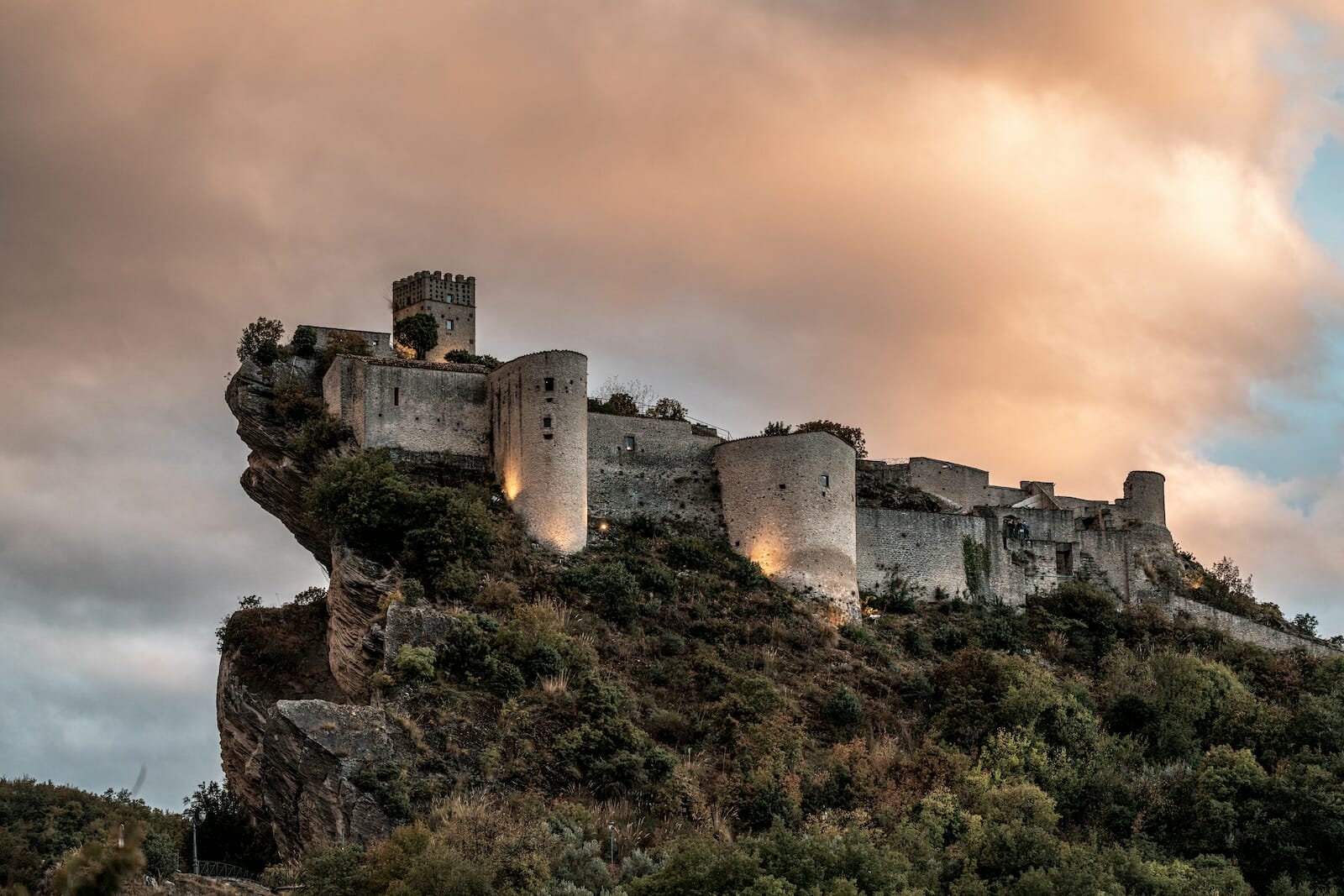
Things to Do in Abruzzo: Hiking, Swimming, Eating Locally, & More
May 5, 2023
There is no shortage of amazing things to do in Abruzzo. Known as Italy’s greenest region, Abruzzo featuers both the Adriatic coastline and the Apennine Mountains. If you like outoor adventures and off-the-beaten-path travel, Abruzzo should definitely be on your radar!
Filled with miles of unspoiled parks and countryside, the southern region of Abruzzo offers tons of green travel options. And, of course, green travel isn’t just about reducing the carbon footprint while on vacation—it’s also about supporting local businesses, and really getting to know the land and the people who live there. Since Abruzzo tends to be off the beaten path for most travelers, there are even more authentic ways to do that here than elsewhere in Italy.
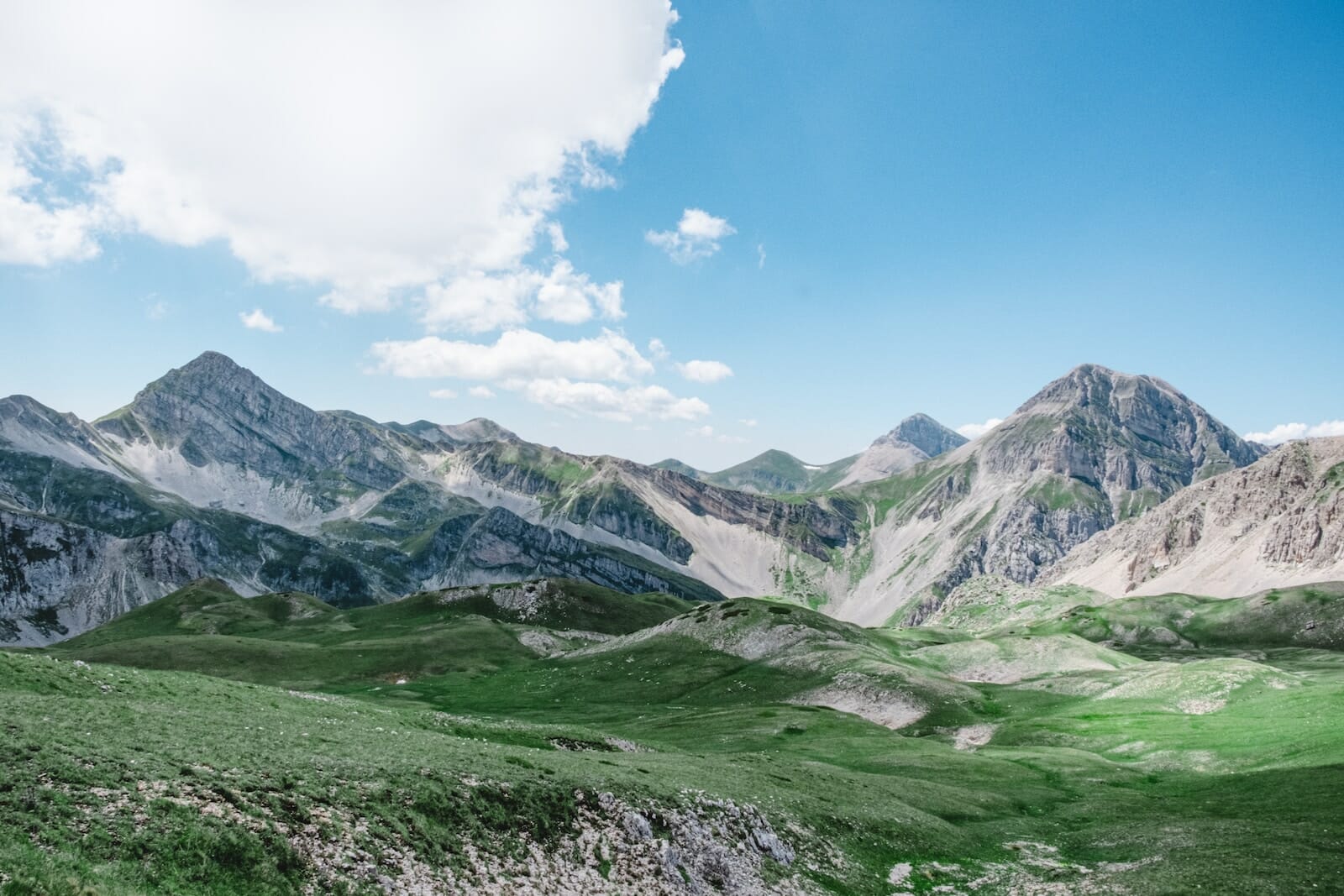
Gran Sasso d’Italia is a mountain range that contains the highest point of the Apennine Mountains. Photo credit: Daniele Franchi
Table of Contents
Best things to do in Abruzzo
If you like the outdoors and off-the-beaten-path travel, you’ll love Abruzzo! You won’t find a grand tour of famous sites in this region… but you will get a genuine feeling of what daily Italian life is like, plus get to experience rolling hills, spectacular mountains, and stunning beaches.
Explore Abruzzo’s national parks
Abruzzo is especially famous for its parks, which cover about a third of the region. Head to Parco Nazionale d’Abruzzo, Lazio e Molise , Parco Nazionale del Gran Sasso e dei Monti della Laga, and Parco Naturale Regionale Sirente-Velino to get in touch with the “green heart of Italy.” In particular, we’d like to highlight Majella National Park (Parco Nazionale della Majella), a UNESCO Global Geopark with incredible landscapes.
These parks aren’t just green; they also boast some of Europe’s tallest mountains. The Apennines are perfect for skiing in the winter and hiking in the summer, and so high that you can see both the Mediterranean and Adriatic seas from their peaks.
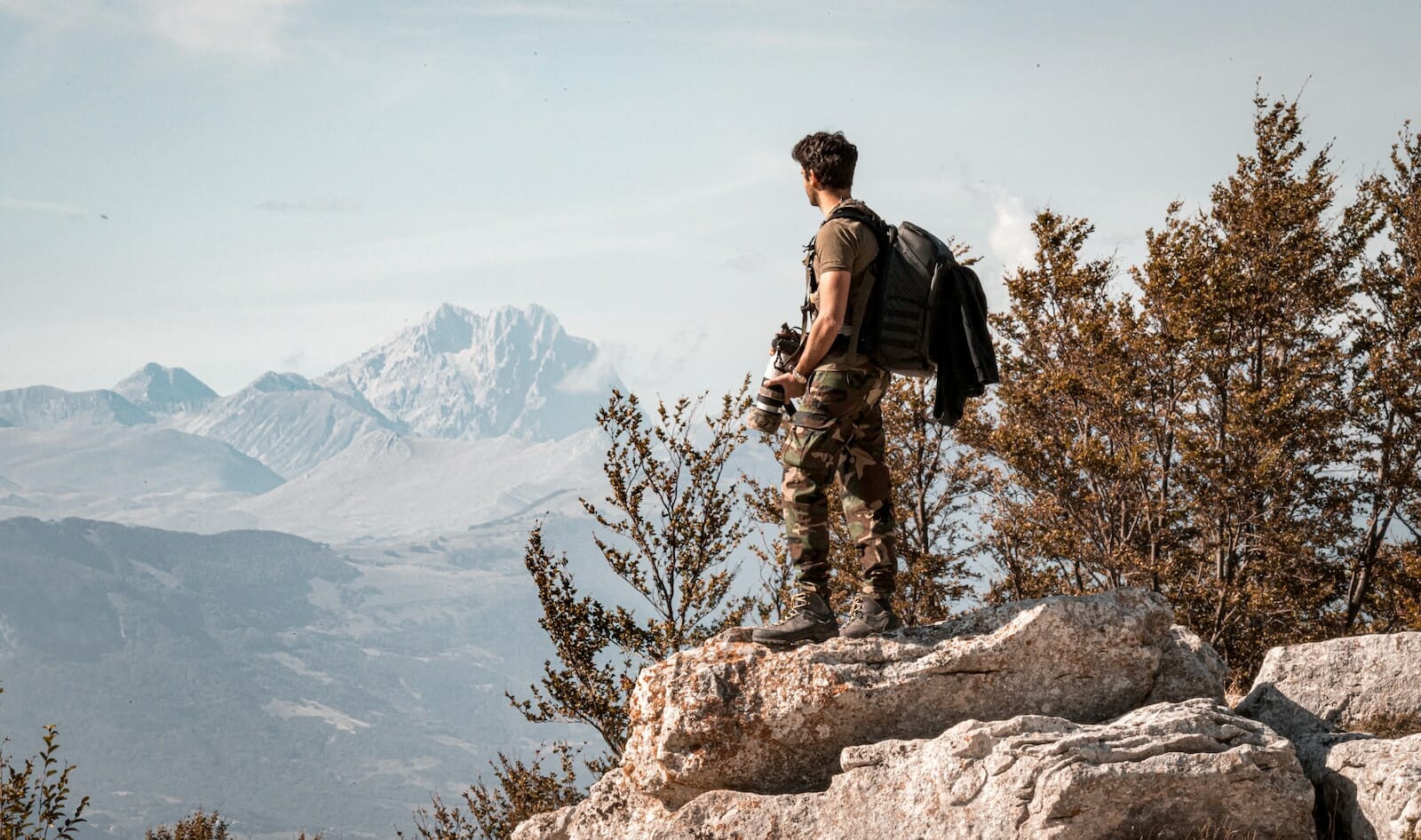
Abruzzo, Italy has no shortage of incredible natural areas. Photo credit: Federico Di Dio photography
Swim or relax at the amazing beaches
Looking for something more relaxing? Another great thing to do in Abruzzo is explore one of the region’s many beaches along the crystal-clear Adriatic Sea. Many are known for their crystal-clear waters and are great for snorkeling. Plenty of hiking trails are near the beaches, as well. Overall, Abruzzo has a variety of beautiful beaches to choose from, with something for everyone. Some of the top beaches in Abruzzo include:
- Spiaggia di Punta Penna : Located near the town of Vasto, this beach is known for its crystal-clear waters and golden sand. It’s a popular spot for swimming, sunbathing, and water sports.
- Spiaggia di Torre Cerrano : This sandy beach is located in the town of Pineto and is part of a protected marine area. It has a long stretch of beach, and the waters are perfect for swimming and snorkeling.
- Spiaggia di Silvi Marina : Silvi Marina is a popular beach town in Abruzzo with a long sandy beach and clear waters. It’s perfect for families, with plenty of amenities nearby, such as restaurants, bars, and shops.
- Spiaggia di Francavilla al Mare : Francavilla al Mare is a town located just north of Pescara, and it has a beautiful beach with golden sand and clear waters. There are plenty of amenities nearby, including restaurants, bars, and hotels.
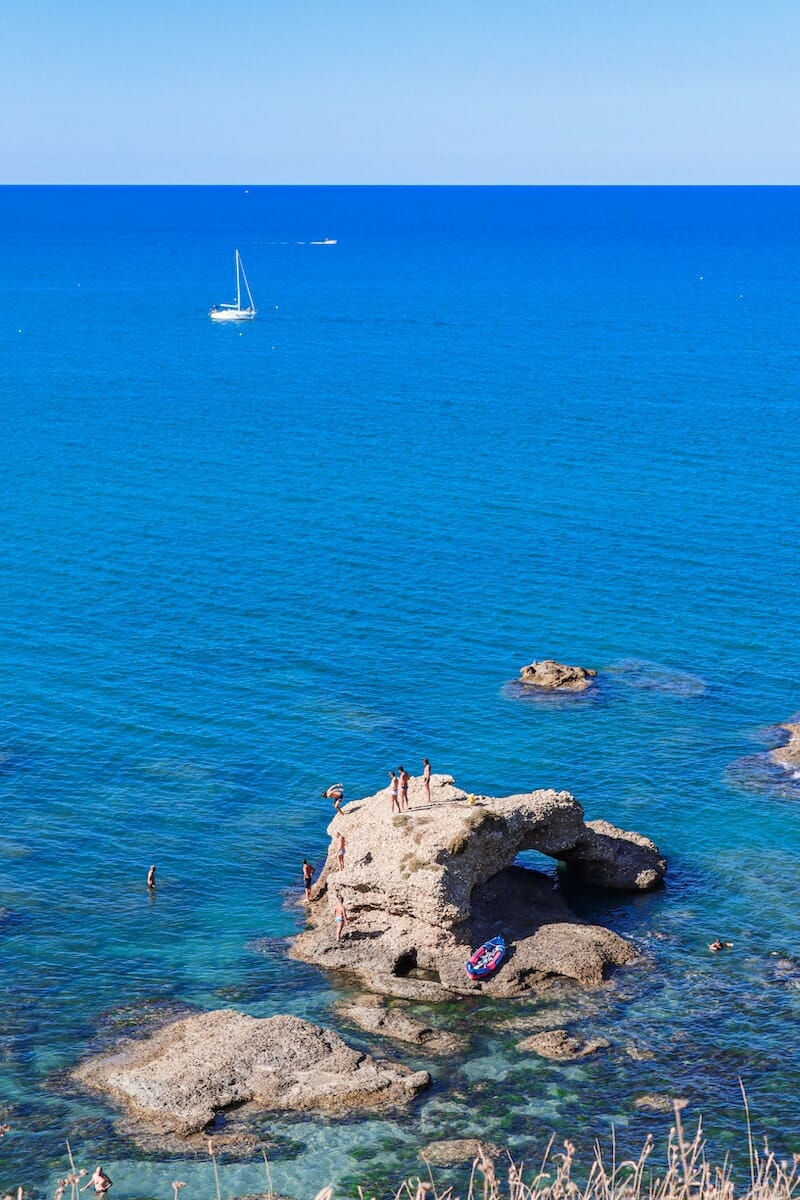
Sentiero d’Accesso, in the town of Vasto is located in the Regional Natural Reserve Punta Aderci. Photo credit: Vincenzo De Simone
Savor Abruzzo’s culinary scene
Abruzzo’s rich mix of mountains and sea makes for very fertile farmland—which means deliciously fresh produce! Abruzzo’s traditional dishes tend to serve up seasonal products, so you may not find the same dishes in the winter as you do in the summer (which is much better for the environment!).
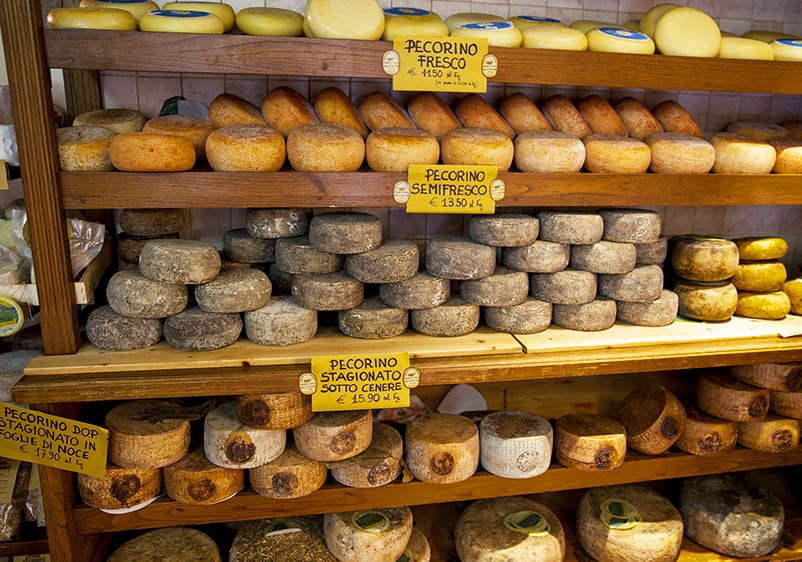
Pecorino cheese is popular in Abruzzo.
Specialties in Abruzzo include arrosticini (roasted lamb skewers), handmade maccheroni alla chitarra (a pasta similar to spaghetti and resembling guitar strings) and pecorino (hard cheese made from sheep’s milk). These dishes tasted even better when paired with Montepulciano d’Abruzzo red wine!
Travel sustainably

Roccascalegna is a picturesque destination in the province of Chieti. Photo credit: Federico Di Dio
Staying at organic farms and hiking in the mountains are green ways to travel in Abruzzo. But there are other sustainable ways to travel in Abruzzo and help the region, too. In 2009, Abruzzo’s capital of L’Aquila was devastated by an earthquake. It’s slowly rebuilding, but one way to help is to promote the region’s local businesses.
And that’s easier than you may think! There are plenty of great things to do in Abruzzo to support the local economy. Eating local, seasonal food , buying artisanal goods, and staying at family-owned establishments not only boost local business, but give you a real feel for the region.
Of course, we also recommend traveling as little as possible by car. Instead, get lost on foot. Not only is it good for you, but it allows you to see the many hidden treasures that the region has to offer.
Stay in a unique setting
Immerse yourself in nature and enjoy sustainable accommodation in any one of Abruzzo’s four provinces (L’Aquila, Teramo, Chieti, and Pescara). Green lodging options include renting an apartment or staying at a local bed-and-breakfast or agriturismo (farms that rent out rooms to guests).
Interested in getting your hands dirty during your Abruzzo adventures? Include organic farming in your vacation by using websites like WOOF and GrowFood , which can organize opportunities for working on farms and living with local families for extended periods of time.
Update notice: This article was updated on May 5, 2023.
by Elena Ciprietti
Book a tour.

Pristine Sistine - The Chapel at its Best
1794 reviews

Premium Colosseum Tour with Roman Forum Palatine Hill
850 reviews

Pasta-Making Class: Cook, Dine Drink Wine with a Local Chef
121 reviews

Crypts, Bones Catacombs: Underground Tour of Rome
401 reviews

VIP Doge's Palace Secret Passages Tour

Legendary Venice: St. Mark's Basilica, Terrace Doge's Palace
286 reviews
Stay up to date with travel tips, local insights and all things Italy on our social channels!
Subscribe to our Newsletter
Get curated Italy travel tips delivered to your inbox!
Your browser is out-of-date!
Update your browser to view this website correctly. Update my browser now
7 Magical Places To See in Abruzzo
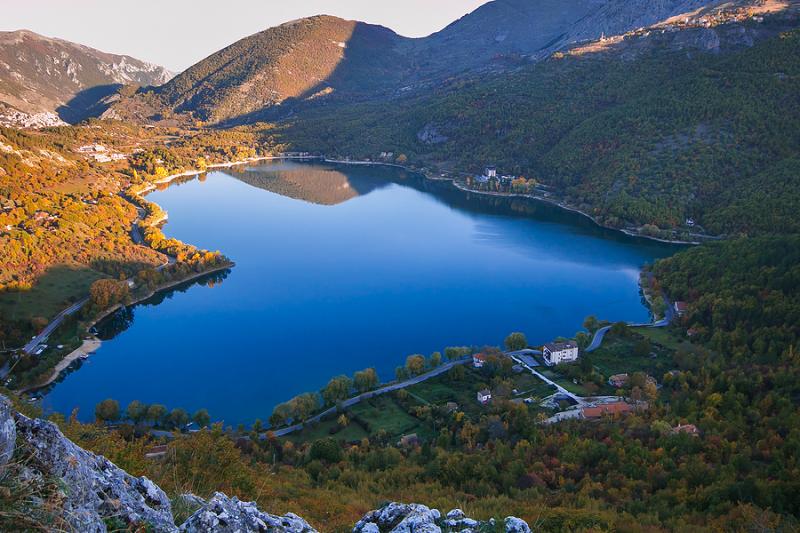
We can never write enough about Abruzzo and its many beautiful places. Save these ideas for your next trip!
Rocca Calascio
Standing atop a hill at 1,460 meters (4,790 ft) above sea level, the 13th-century Rocca Calascio is the highest fortress in the Apennines, the mountain chain that runs through the length of Italy.
Rocca Calascio was never intended as a noble residence; it was built for military purposes and to accommodate troops, as evident from its architecture and design. Built of stone and masonry, its lower half features larger stones than its upper half, probably to make the base unassailable. The fortress, however, was never used in a battle. It was instead badly damaged by a powerful earthquake in 1481.
Owners of the Rocca included the Medici of Tuscany.
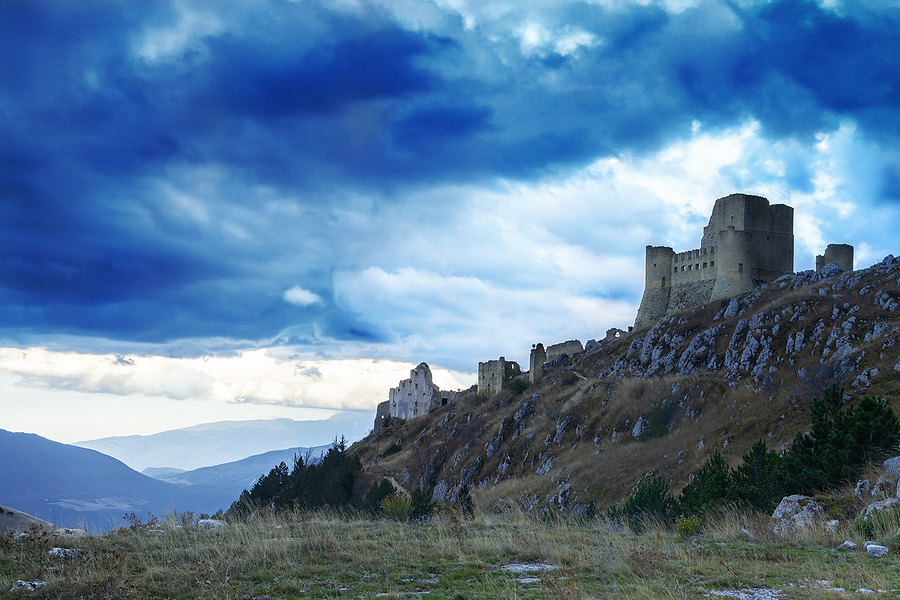
From the fortress, the view is spectacular as you admire the Corno Grande peak of the Gran Sasso mountain, and the 17th-century Church of Santa Maria della Pietà just below.
Because of its spectacular position and views, Rocca Calascio has been used to film scenes for a number of movies, including Ladyhawke , The Name of the Rose and The American .
Basilica of Santa Maria di Collemaggio
A masterpiece of Abruzzese Romanesque and Gothic architecture, the Basilica of Santa Maria di Collemaggio is L’Aquila’s most important church and the largest in Abruzzo. It was heavily damaged during the 2009 earthquake that devastated the city, which is the regional capital of Abruzzo.
The Basilica was built in 1287, and, a few years later, in 1294, Celestine V was crowned pope inside, and later buried there. The façade resembles a wall, and its peculiarity is the pattern of blocks of alternating pink and white stone, arranged in a sort of tapestry. Each of the three doors, one central and two smaller ones to the side, is surmounted by a rose window. The interior is grand and austere.
The Basilica underwent a €14 million restoration after the earthquake, privately financed.
Some call it the ‘pearl of Abruzzo’, and Scanno surely is a beautiful village, surrounded by the Majella mountains, in the National Park of Abruzzo.
Stroll the alleys and visit the artisans’ shops; especially renowned are the lace and goldsmith workshops, where the local jewel ‘presentosa’ is still made. Try the ‘pan dell’orso’, a traditional dessert, then head to the lake, which, seen from above, looks like the shape of a heart. According to legend, Scanno's natural lake was created by a feud between a white witch and a sorcerer; the lake marks the spot where the witch fell.
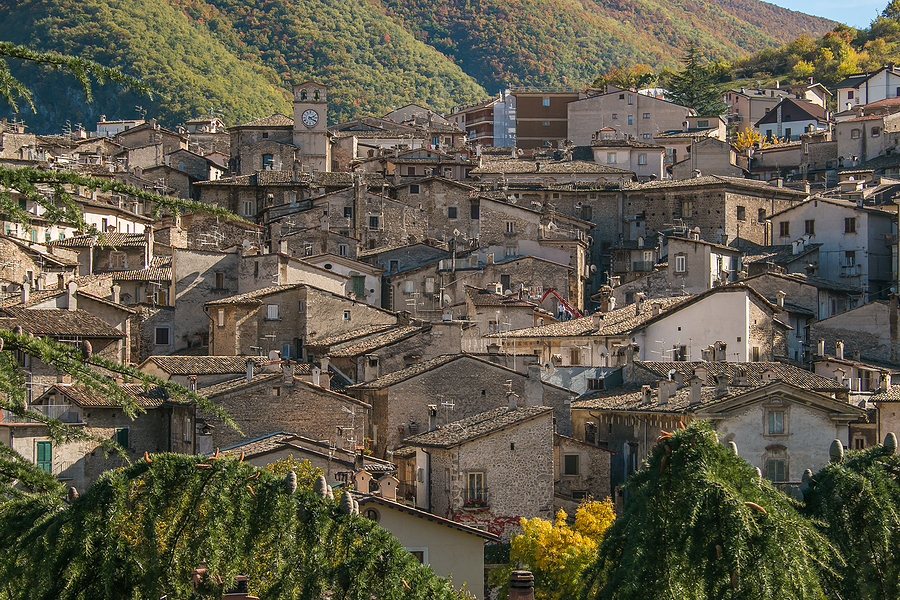
Fun fact: Scanno has been photographed by several world-famous photographers, including Henri Cartier-Bresson, Elliot Erwitt, Gianni Berengo Gardin and Mario Giacomelli, whose photo, Il Bambino di Scanno (Scanno’s Child) is exhibited at the Moma in New York.
Stiffe Caves
Among the most spectacular examples of karst caves in Italy are the Grotte di Stiffe, near L’Aquila, which formed about 600,000 years ago, produced by an underground river that emerges on the surface.
They are more than a kilometer long and are not fully explored yet.
It is possible to visit the caves following a tourist route of about 700 meters that concludes at a waterfall. Along the way you can see big stalactites and stalagmites, black lakes, rushing streams. It really is quite spectacular.
Make sure to wear warm clothes as the temperature inside stays at a constant 10°C all year round.
Costa dei Trabocchi
Trabocchi are large, spider-like fishing platforms, made of wood, ropes and nets, found along the coast of Abruzzo. These structures unique to Abruzzo were invented in the 18th century to allow farmers to hunt for fish without having to face the dangers of the open sea.
The Trabocchi Coast corresponds to the Adriatic stretch that goes from Ortona to San Salvo for about 70 kilometers and is where you will find the most trabocchi, along with typical little towns that have preserved their ancient traditions.
The most beautiful beaches along the coast include Punta Aderci, Punta Penna, Punta d’Acquabella, Calata Turchino and Punta Cavalluccio. Some trabocchi have been turned into restaurants where you can try the local cuisine.
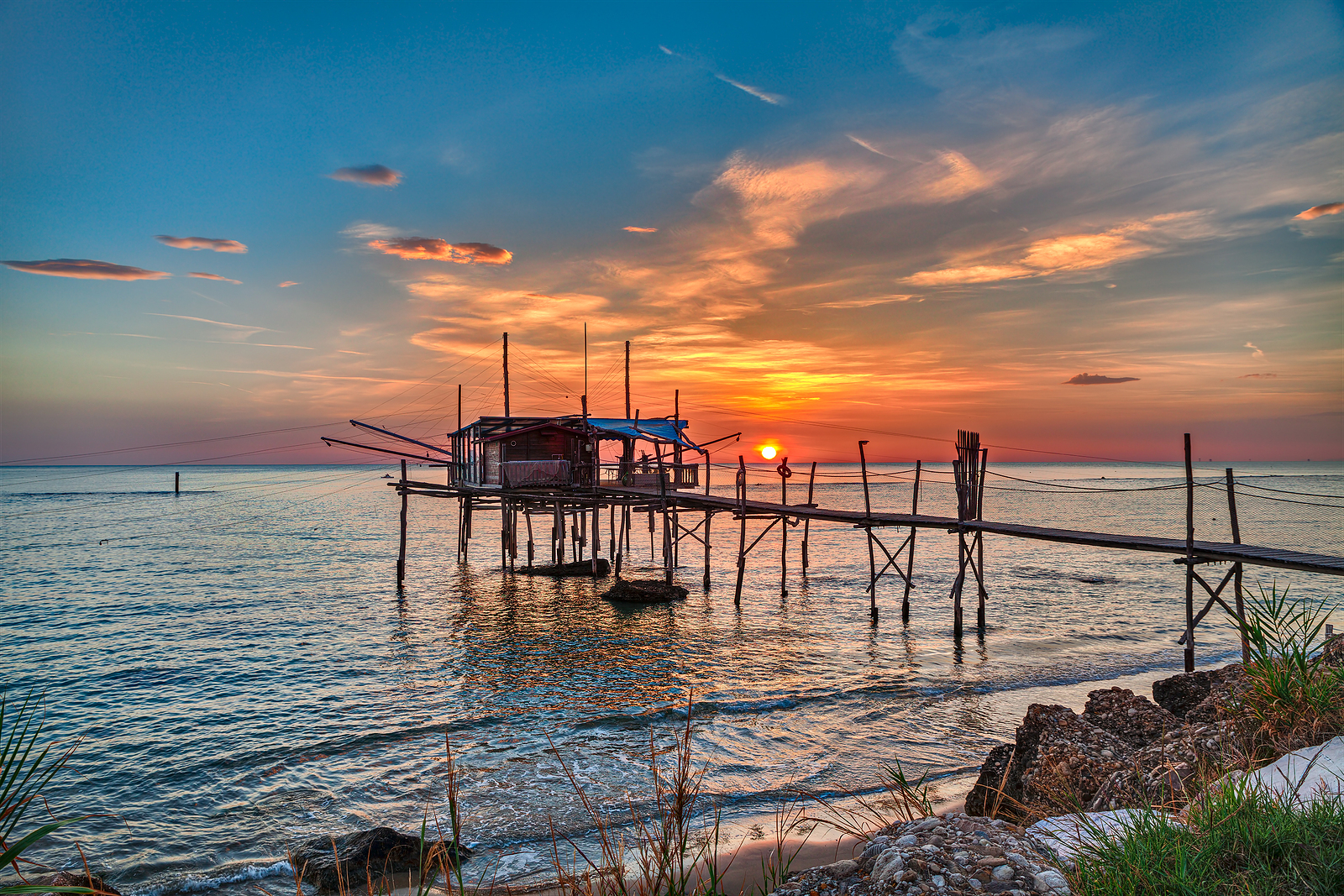
Eremo di San Bartolomeo in Legio
The hermitage of San Bartolomeo in Legio is located on a rocky spur 700 meters above sea level in the Majella, not far from another hermitage place, Santo Spirito a Majella.
San Bartolomeo dates back to before the 11th century and was restored by Pietro dal Morrone, the future Pope Celestino V, around 1250. Celestino himself lived there around 1274 for at least a couple of years.
The hermitage consists of a chapel and two rooms carved into the rock intended for the hermits. Access is via four different stairs, also carved into the rock.
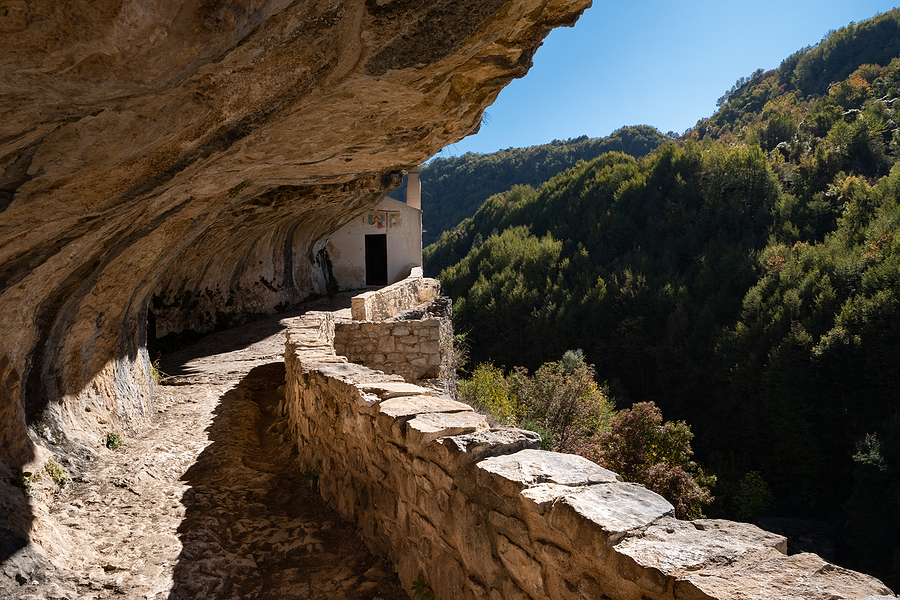
The facade of the church shows traces of severely damaged frescoes.
If you need a break from the madness and the noise, this is the place!
Piccolomini Castle
In the wild heart of the Marsica, stop by Celano for a taste of history and nature. First, walk the streets of the historic center and visit the fairytale medieval Piccolomini Castle, which overlooks the Fucine plain. The castle dates back to the Middle Ages, and was built for defensive purposes.
Afterwards, head to the Gorges of Aielli-Celano, some of the most important canyons in Abruzzo and Italy, with a deep valley carved out by the La Foce stream and spectacular rock walls that can be up to 200 meters high. Look out for golden eagles, kites and griffins, which nest in the canyon.
You may also be interested in...
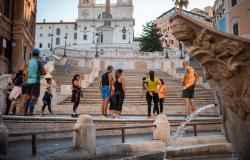
Latest property in Abruzzo

What to do in Abruzzo
Enjoying this Italy intel? You might also love:

10 THINGS YOU WANT TO KNOW WHEN TRAVELLING TO ABRUZZO
Top 10 Places to Visit in Abruzzo
If you haven’t heard of Abruzzo, now is the perfect chance to know more about it.
Abruzzo is in central Italy, a few hours’ drive from Rome. It is located between the Apennines and the Adriatic coast. It is one of the country’s lesser-known locations, but it has everything tourists love: pristine lakes, unpolluted parks, awe-inspiring mountain ranges, and enchanting medieval villages. It is genuinely a region where you can immerse yourself in local culture, sample a wide range of cuisine, and learn about the authentic Italian way of life .
In this article, we will take you to different places and show you what to do in Abruzzo.
Majella National Park
Majella National Park is one of the three national parks in Abruzzo. With over 100 square miles of stunning mountains and valleys to explore, it’s one of the best-preserved Apennine ecosystems. Throughout the summer months, hiking in this area is perfect for individuals with a passion for the outdoors.
The Hermitage of San Bartolomeo in Legio, Abruzzo’s most famous cliff face retreat, the Hermitage of Santo Spirito, one of the Majella’s most prominent monasteries and the Hermitage of San Giovanni all’ Orfento, one of the remotest hermitage of Italy, are three additional must-sees.
Do you dare?
Passolanciano–Majelletta
At approximately 2000 meters above sea level, Passolanciano–Majelletta is a ski resort with a spectacular view of the Adriatic coast. You can go hiking and wander through the many magnificent views as well as the secluded hermitages found in the steep hillside. It’s a beautiful place to visit!
In some seasons during March you can end up skiing in the morning and swimming in the afternoon. At just 1 hour away from the skiing resort you can find beautiful beaches of Punta dell’Acquabella or Spiaggia di Punta Ferruccio
Fara San Martino
Abruzzo has a long history in pasta-making, which is why eating is one of the best things to do in the region. The charming town of Fara San Martino, located in the Majella National Park, is famous for the flavour and quality of its pasta. Giuseppe Cocco, De Cecco, and Delverde are three of the most well-known high-end pasta brands globally, and this is where they are made. You may enroll in a culinary class to learn the finest ways to make homemade pasta.
Apart from that, Fara San Martino is noted for its “gole,” one of Italy’s longest canyons, which is only a few minutes away from the town. This route is ideal for hikes and picnics.
Civitella del Tronto
It is one of the most beautiful hamlets of Italy. Civitella del Tronto secretly holds the narrowest street of Italy and its fortress. The fortress was built by the Spanish and now it holds the primate to be the largest fortress in Italy.
Campo Imperatore
Campo Imperatore also known as the ‘little Tibet’ is a huge mountain plateau located between 1500 & 1900 meters above the sea level (4921-6233 feet) inside the Gran Sasso & Monti della Laga National Park. A vast glacier-formed intermountain plateau that spans over dozens of kilometers and creates a breathtaking natural landscape. Its old, heart-wrenching appeal has made it popular in recent years as a natural backdrop for scores of commercials and movies , some of which are rather well-known.
Fun fact to know: at the top of the astronomical observatory, the is the historical Campo Imperatore hotel where Mussolini was kept prisoner at the end of WWII.
L’Aquila & its Surroundings
L’Aquila city is known as the Florence of Abruzzo or the Salzburg of Italy was almost completely destroyed by the earthquake in 2009. Now is almost completely restructured and it’s definitely worth a visit.

L’Aquila province, L’Aquila’s surroundings alternate round high grounds with narrow valleys, cultivated with the open field system, and dotted with numerous villages such as Santo Stefano di Sessanio, Castel del Monte, Calascio, Navelli, Castelvecchio Calvisio and Fontecchio.
Pacentro is a medieval village in Abruzzo with a magical ambiance. There’s nothing like spending a day wandering around the town’s tiny stone-paved lanes, appreciating the architectural intricacies of the beautiful houses and taking in the spectacular vistas along the route.
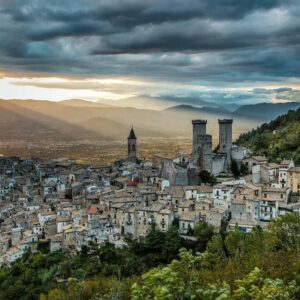
Roccascalegna
Perched on a mountain ridge, Roccascalegna is a fully preserved medieval town and one of the must-visit tourist attractions in Abruzzo. It’s most famous for its 16th-century castle, which rises out of a limestone cliff and must be seen to be believed. It is, without a doubt, one of the most spectacular castles in the region, even if there are over fifty others in Abruzzo alone.
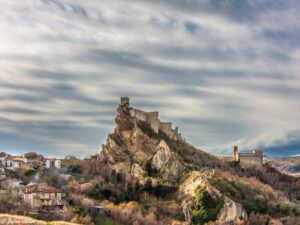
Vasto, well recognized for its diverse beach options, is a hilltop village that overlooks the Adriatic Sea. Aside from its nature, the town center is a magnificent medieval site with lovely structures from the 15th century. The Caldoresco Castle, the San Giuseppe Cathedral with its Romanesque facade, and Palazzo d’Avalos, where you may explore its museums and Neapolitan-style gardens, are all within walking distance of Piazza Rossetti.
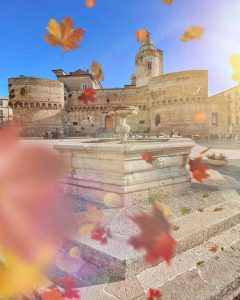
Punta Aderci Natural Reserve
With its rocky promontory, the Regional Nature Reserve of Punta Aderci preserves one of the most evocative and magnificent portions of the Abruzzo coast, which alternates vast and sandy beaches with natural cliffs, bays and coves of suggestive beauty.
Abruzzo may be a lesser-known location, but it is well worth considering for your next trip. You’ll get the opportunity to learn about different locations, cultures, cuisines, customs, and ways of life. Traveling to a less well-known place might help you realize how vast the world is and how much more there is to discover.
If you want to know more things to do in Abruzzo , Experience BellaVita can introduce you to the genuine and authentic Italian lifestyle. With us, you get to know the hidden gem of Central Italy. Get in touch with us today!
Privacy Overview
Visititaly.info
Holidays, tours, packages, hotels, travel guide.
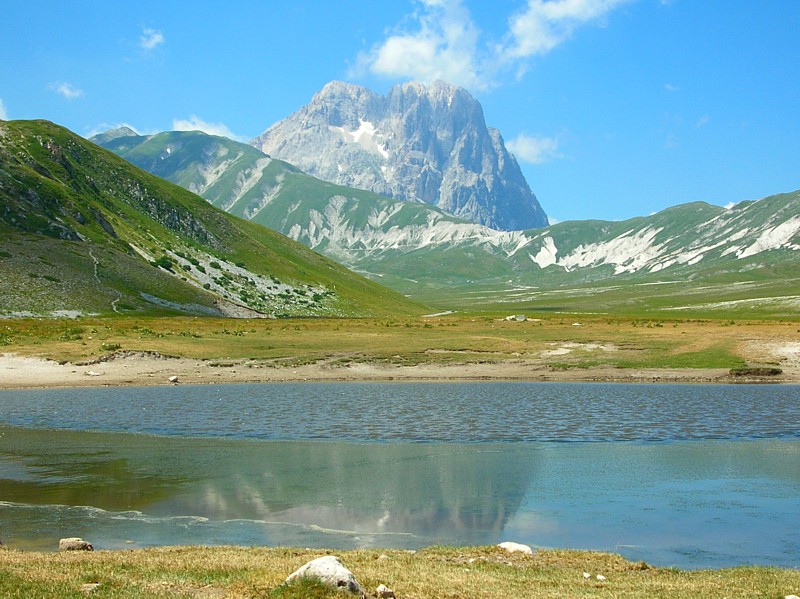
Most beautiful places to visit in Abruzzo

Abruzzo is a region in Central Italy. Adjacent to the Marche to the North-West, Umbria to the West, Lazio to the South, Molise to the Southeast and the Adriatic sea to the East.

Abruzzo occupies an area of 10,794 square kilometres and almost two-thirds of this area are covered by the mountains. The remaining part consists of hills, which are spread in the 129 km long Adriatic coast. In summer the region, like the most of Italy, offers long sandy beaches with a lot of entertainment, bars and restaurants.
The southernmost part of the region is formed by the Parco Nazionale d’Abruzzo, which is one of the most important in the whole of Europe, covered with beech forests, which guarantees the preservation of the typical local countryside and various rare species of flora and fauna. Corno Grande (Big Horn) is the highest peak of the entire mountain range of the Apennines, which stretches across the whole of the Italian “boot”.
It is also the most impressive peak of the Apennine mountains. Rising in 45 kilometres from the Adriatic Sea and 120 kilometers from the Tyrrhenian Sea it is really a great dominant feature of the region of Abruzzo. Corno Grande is the highest, while lower one, but also very impressive is Corno Piccolo with a wild maze of towers of stunning shapes.
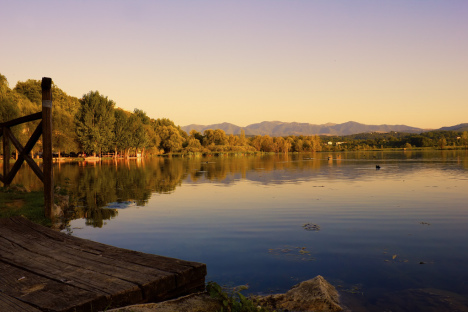
This area is rich in natural beauty and history, but its not over crowded by the tourists. This region is montanious and a plain can be found just at a narrow coastal strip, which follows the shore of the Adriatic Sea and does not interfere to the inland.
The most important rivers are the Aterno, Sangro, Tronto, Trigno, Tordino, Vomano and mountain part of the Liri, which flows into the Tyrrhenian Sea. The territory of Abruzzo is protected also by several natural parks and reserves. The region is rich with diverse flora and fauna and rare animals, such as the brown bear, Apennine wolf or Abruzzo chamois.
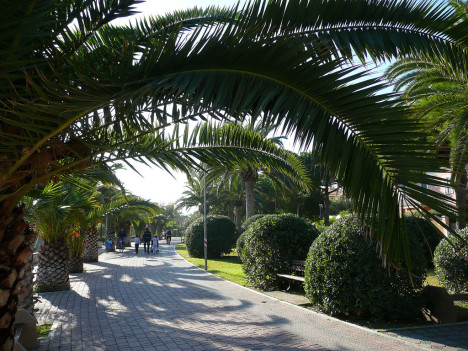
Abruzzo, with its mountains, offers excellent ski resorts, that attracted such stars as Alberto Tomba and Deborah Compagnoni. You could see the ski slopes of Roccaraso, Pescocostanzo and Rivisondoli in the TV during the finals of the European Cup in the Alpine skiing held in the years 2005 and 2006. Other ski resorts are e.g. Campo Felice, Ovindoli, Prati di Tivo, Prato Selva, Gran Sasso, Monte Piselli, Passolanciano and Campo di Giove in Maiella and Pescasseroli. There are more small resorts as well. Pescara (together with the entire region) hosted the Mediterranean Games in 2009 (Giochi del Mediterraneo).
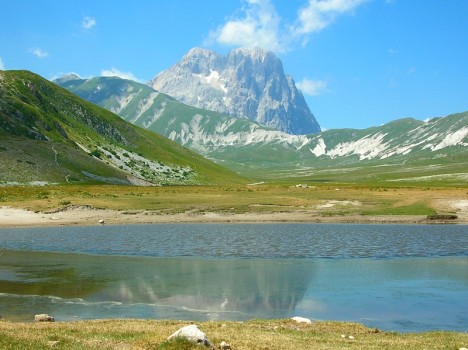
The climate is strongly influenced by the Apennine mountains but has also a typical Mediterranean areas. For example, the city of Pescara, which has an altitude of about 10 metres has an average temperature of 15,5°C and annual precipitation only slightly exceed 700 mm, and Chieti, which is situated at an altitude of 330 m, has an average temperature of 13 °C, but the annual rainfall at around 900-1000 mm). The freezing is nothing uncommon in the winter months when the temperature can fall well below -20°C.
Palm Riviera is a part of Central Italy, situated in the regions of Marche and Abruzzo, on the coast of the Adriatic Sea around the city of San Benedetto del Tronto. Palm Riviera is named after the quantity of palms, which grow here. Along with the flood of Oleander creates an exotic atmosphere.
San Benedetto del Tronto was founded in the 9th century BC. Characteristic feature of this summer centre are Palm trees, which add a tropical feel. The resort is ideal for spending a beautiful vacation, thanks to the comfortable climate. Other great resorts include Martinsicuro, Alba Adriatica, Tortoreto Lido and the Villa Rosa.
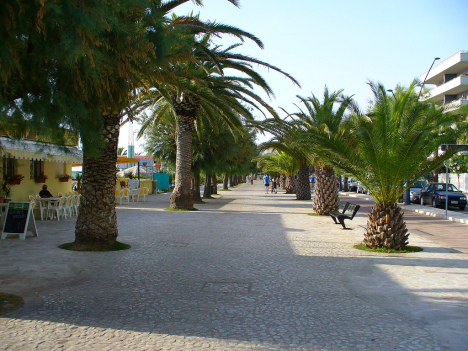
Top places to visit in Abruzzo region
- Alba Adriatica
- Campomarino Lido
- Canosa Sannita
- Città Sant’Angelo
- Giulianova Lido
- Gran Sasso e Monti della Laga National Park – the largest national park in Italy
- L’Aquila
- Marina di Montenero
- Martinsicuro
- Montesilvano
- The National Park of Abruzzo, Lazio and Molise – the oldest national park in the Apennines
- Palm Riviera
- Riserva regionale Majella Orientale
- Rocca Calascio
- Rocca San Giovanni
- Roccascalegna Castle
- Roseto degli Abruzzi
- San Benedetto del Tronto
- Silvi Marina
- Tortoreto Lido
Leave a Reply Cancel reply
Your email address will not be published. Required fields are marked *
This site uses Akismet to reduce spam. Learn how your comment data is processed .
Abruzzo, Italy: travel guide and places to visit

Visit Abruzzo
With a varied landscape Abruzzo is known for its seaside resorts, its mountain scenery and its ski resorts - with the great advantage that the sea and the mountains are never far apart so it is easily possible to combine both during your visit.
Abruzzo - a travel guide and places to visit
For a summary of the most popular sights in the region see also Abruzzo places to visit .
The Abruzzo region runs along the Adriatic coast of western central Italy.

To the east of Abruzzo the area also has popular beaches and coastline on the Adriatic Sea. For almost 100 miles Abruzzo follows the Adriatic, where well established resorts attract large numbers of families from across Italy and elsewhere in Europe. Apart from the long beaches in the major destinations there are also long stretches of quieter coast where you might find a smaller beach where you are almost alone.
Advertisement
Western Abruzzo - Inland with beautiful mountain scenery
The region away from the coast is defined by its mountains, and it is one of the most mountainous regions in Italy, culminating with the Corno Grande mountain at almost 3000 metres high.

The mountains of Abruzzo also contains numerous attractive villages, often huddled around an ancient church, and several other interesting towns, castles and other historic monuments.
In the north in particular Abruzzo has a particularly impressive mountain backdrop, perhaps nowhere more so than the region around the town of L'Aquila. L'Aquila, the capital of Abruzzo is in the Gran Sasso mountains and has a long tradition of being one of the most historically interesting centres in Abruzzo, although the historic center suffered a great deal of damage during an earthquake in 2009, which also killed several hundred people.

A little to the west is the ski-resort of Ovindoli and the nearby town of Celano , famous for the huge Piccolomini castle which dominates the attractive hill-top town.
Further south is a cluster of villages which count amongst the most beautiful villages of Italy. Pacentro , Anversa degli Abruzzi , Scanno and Opi all have this distinction. As a bonus they are all situated in beautiful mountain settings. Pacentro also has a 14th century castle which is currently being renovated. Nearby is the lovely town of Sulmona which has many palazzos and piazzas to admire as well as a large aquaduct. Another highlight is the dramatic village and castle of Roccascalegna (photo above) which is near the border with Molise.
There are parts of three different Italian National Parks within Abruzzo's borders - the Abruzzo, Lazio and Molise National Park, the Mount Majella National Park and the Gran Sasso e Monti della Laga National Park - as well as the Sirente Velino Regional park and several Nature Reserves. Together these cover more than a third of the territory and as a result you are never far the chance to enjoy the protected environment of mountains and forests, lakes and rivers, and an abundance of wildlife.
Eastern Abruzzo and the coastline
Eastern Abruzzo has some beautiful beaches with, in general, the longer, sandier beaches being on the northern part of the Abruzzo coast.
Among the most visited of the Abruzzo sea resorts are Alba Adriatica, Costa dei Trabocchi, Francavilla al Mare, Giulianova, Martinsicuro, Montesilvano , Ortona , Pineto, Roseto degli Abruzzi, San Salvo, Silvi Marina, Tortoreto and Vasto and several of them have been awarded the prestigious 'blue flag' award for cleanliness and facilities. Ortona as well as being a coastal resort is home to a large Argonese castle. The main town on the coast is at Pescara, which also has about 10 kilometres of sandy beaches.

Atri is a pretty hill village fairly close to the coast and further south, also occupying a hilltop location is Lanciano with its medieval cathedral to the south. Lanciano is an important tourist destination as it is the site of the Eucharist miracle where bread and wine were apparently seen to turn into flesh and blood. Between the two Crecchio is home to an impressive castle which contains an Etruscan and Byzantine museum.
Abruzzo is famous for its olive oil and Loreto-Aprutino is part of the 'golden-triangle' of olive oil along with Moscufo and Pianella.
A highlight of Abruzzo is the hill top city of Chieti is one of the oldest cities in Italy and is home to many fine Palazzos and churches. Another highlight is the dramatic village and castle of Roccascalegna which is in the south of the region near the border with Molise.
Abruzzo photo gallery

Tourist Awards in Abruzzo
Most beautiful villages.
The following Italian towns and villages in Abruzzo are listed among the ' most beautiful villages in Italy ': Anversa degli Abruzzi , Bugnara, Castel del Monte, Castelli, Città Sant'Angelo, Civitella del Tronto , Guardiagrele, Introdacqua, Navelli , Opi , Pacentro , Pescocostanzo, Pettorano sul Gizio, Pietracamela, Rocca San Giovanni, Santo Stefano di Sessanio , Scanno , Tagliacozzo, Villalago
Orange Flag Tourism towns in Abruzzo
The following Italian towns and villages in Abruzzo are listed among the ' Orange flag towns in Italy '(a national tourist award): Palena, Roccascalegna
Map of Abruzzo and places to visit
Abruzzo places to visit.

Select your language
Site search

Cinque Terre

Palatine Chapel
Italy This Way - copyright 2009 - 2024 :: privacy policy

12 Best Places to Visit in Abruzzo, Italy
Best Places to Visit in Abruzzo, Italy However you see it, Abruzzo is a beautiful and historic playground that you can discover as the world ventures elsewhere.
Its proximity to Rome makes travel easy, without overwhelming the trio of national parks, alpine villages, and coastal hideaways. The nature within Abruzzo makes it a haven for hikers and explorers, plus skiers when the temperature drops.
The mountains which are so stunning were seen as natural fortresses for the region’s towns. These villages and cities tucked away along mountain ranges, have connections to pre-Roman times. Their culture, craftsmanship, and recipes survive as the generations pass.
As travelers venture further north in Abruzzo, Italy, or to the western coast, take time to explore a place as raw and wild as any in Abruzzo, Italy
Unassuming, unheralded, or underrated. However you see it, Abruzzo is a beautiful and historic playground that you can discover as the world ventures elsewhere.
Table of Contents
12 Best Places to Visit in Abruzzo, Italy 12. Civitella del Tronto

Home to the highest fortress in Italy, Civitella del Tronto is a trip back in time. In the 1860s, the fortress helped the city become the last bastion of resistance against Victor Emmanuel’s plans to unify Abruzzo, Italy
Much of Civitella del Tronto is encased in the Bourbon Fortezza, whose origins can be traced to the 11th century. Its almost 700 years of defending the town allowed its cobbled streets to blossom with sightly buildings, delicious cuisine, and gravity-defying stairways.
One of these stairways rises steeply out of the valley to the fortress entrance. Soon you’ll pass the old Governor’s house and the Church of San Giacomo where the parapets guide you around the fort’s entirety.
11. Sulmona

Fast forward to now and Sulmona is synonymous with confetti. No, not the kind that blasts into the sky. Instead, Italian confetti is a collection of colorful, flavored almonds.
Designed in all sorts of artistic fashions, including colorful bouquets, the streets of Sulmona are laden with confetti. While you wouldn’t want to eat those, head into the town’s many shops to find delicious confetti featuring fruit flavors, Nutella, hazelnut, and even tiramisu.
10. Trabocchi Coast

These “nets” are in face lengthy wooden platforms that run into the Adriatic. From the end of them, fishermen could essentially deep sea fish. As old as many are, they stand before you, some with their own restaurants.
A memorable coastal drive takes you from town to town with an endless blue sea to enjoy along the way. Other highlights include the Abbazia of San Giovanni. The gothic abbey is set upon an ancient Roman temple looking out to the sea.
9. Majella National Park

One of three national parks in the Abruzzo region, Majella National Park, features spectacular Apennine mountain scenery. Among the high peaks are jaw-dropping valleys where vast canyons have carved their way ruggedly through the otherwise pristine landscape.
Under the delightful Italian sun, lather on the sunblock and make your way down the park’s miles of hiking trails. The extensive system guides you to postcard-worthy views, with each step bringing the chance to discover Majella’s rich natural diversity.
One trek to add to your Majella National Park itinerary is the jaunt to the Gorges of Fara San Martino. A brief hike takes you to a natural rock entrance where a vast valley spreads out before you and you’ll uncover the ruins of the historic Benedictine Abbey of St. Martin. If you’re still energetic, continue on to Mount Amaro, the park’s highest peak.
Aside from nature, this national park is packed with ancient culture and archaeology. Aside from the abbey, there are roughly 40 hermitages that were first developed to house monks.
8. Roccascalegna

A 16th-century castle in Roccascalegna will redefine what you can expect from medieval architecture. Rising out of an angled limestone cliff, the Castle of Roccascalegna sits in an impressively precarious location.
Lying in the valley beneath is a small village whose origins can be traced to the 7th-century. Designed to protect it, the aptly named Castle in the Sky looked over the village and helped slow the rise of invaders. The very folks that led people to think of Roccascalegna as Death Valley.
The castle’s most famous inhabitant was the Crow Baron, Corvo de Corvis. He was an evil ruler who forced high taxes and made all new brides spend their first night of marriage with him. A fact that would eventually lead to his downfall, with a newlywed plunging a knife into his heart.
Today, you can visit the castle’s keep, courtyard, and prison.

The alpine town of Scanno is known as the Pearl of Abruzzo. In many ways, it combines the best parts of the region into one, featuring medieval architecture, surrounded by mountains and fresh alpine air.
In the 15th century, thanks to agriculture and a talented community, Scanno was a wealthy town. Today, its buildings tell the tales of the era’s past but the old skills and craftsmanship survive.
As you explore the ancient streets of Scanno, shops selling handmade ricami (lace work), orafa (goldsmiths), and high-end ceramics are direct descendants of a time when affluent goods were in high demand.
The maze of streets makes Scanno a great place to get lost. But be sure to find time to see the Sarracco Fountain and the Church of Santa Maria Dalla Valle.

L’Aquila may be the capital, but Pescara is the biggest city in Abruzzo. Famous for its golden coast, line with marinas that jut out into the Adriatic, Pescara is the place to develop a terrible tan line.
Compared to other parts of Abruzzo, Pescara is refreshingly modern. Its now lively waterfront owes its recent developments to its predecessors being heavily bombed during the Second World War.
Boasting just shy of 20 kilometers (12 miles) of pristine waterfront, Pescara is a buzz of action during the summer months. The beaches are lined with umbrellas, locals reading in the shade, and hordes of swimmers making use of the refreshing Adriatic that is just as easy on the eyes.
As the sun falls behind Pescara, restaurants quickly fill out and the DJ beats flow out of nearby nightclubs into the happening streets.
5. Roccaraso Ski Area

With little outside interests (aside from those in Rome and Naples), the ski area has developed its own way of doing things. Once we are sure you’ll appreciate it. Roccaraso is the most popular of Abruzzo’s budding slopes. It covers all abilities, from beginners to experts with over 1000 meters (3,200 ft) of vertical.
In town, you’ll find a relaxing cafe culture, bars for après-ski, and shops for when the slopes aren’t calling out. In addition, Roccaraso connects with other ski resorts, vastly increasing the amount of downhill and cross-country trails all on the same pass.

From the Adriatic Sea, the coastal hills rise quickly towards the center of Vasto, which sits elegantly along the peak. With great views around every corner, Vasta is a joy to discover on foot. Fortress walls blend in with spots of gorgeous green vegetation and narrow streets guide you by 500-year-old buildings.
At the heart of Vasta’s history is the stunning Caldoresco Castle and the San Guiseppe Cathedral. Their delightful Romanesque facades will stop you in your tracks. After a day of walking, stop by Piazzo Rossetti for an afternoon espresso surrounded by a quaint local atmosphere.
Beyond the center of town, Vasto offers lovely beaches. Pick between the resort-laden Vasta Marino or go off-trail and seek out the crystalline waters of San Nicola.
3. Gran Sasso National Park

Epitomizing the beauty and personality of Abruzzo, Gran Sasso National Park is spectacular yet unheralded. As one of the biggest national parks in Italy, Gran Sasso boasts astonishing scenery. Its towering mountains have taken inspiration from the Swiss Alps, and its alpine lake offers a hint of Patagonia.
Home to three mountain ranges, there’s plenty of exploration for travelers to embark on. Hiking, mountaineering, and rock climbing are the main sports when the sun is high and warm. Come winter, snow falls heavy and climbing shoes are switched for snowshoes and cross-country skis.
One hike not to miss takes you from the valley floor to the above treeline and into the alpine tundra. Clouds waft by and after a hearty 8-hour trek, your feet bring you to the park’s tallest peak. At almost 3,000 meters (9840 ft), the peak’s 360-degree views will be a memory for years to come.
2. L’Aquila

Set in a beautiful yet small valley, L’Aquila is laden with history, gorgeous architecture, cultural highlights, and amazing food. The town’s well-kept buildings feature Renaissance and Baroque-style facades, and behind each door lies something more captivating.
L’Aquila’s rich heritage has survived into the modern era. Conservatories, symphonies, churches, and historic academies peel back the curtain on life here, long before the 21st century. A highlight is the National Museum of Abruzzo. Housed in the 16th-century San Giorgio castle, the museum focuses on pre-Roman era artifacts, Renaissance works, and historic religious art.
1. Abruzzo National Park

Wild animals, epic hikes, and ancient history come to the fore in Abruzzo National Park. In Italy’s most protected region, this national park is the centerpiece. Just two hours from Rome, you’ll feel a world away, in a raw paradise where bears and wolves linger.
Spotting either is not an easy task. But in such a wild and lively landscape, evidence of both lies around every corner. Thus, Abruzzo National Park is a perpetually unfolding journey. One you can embark on along the park’s well-maintained trail system.
Guided or on your own, seek out the hundreds of miles of trails that lead you into a wilderness where evidence of human interference becomes almost null. The primeval forest full of beech tree words hides various ecosystems and mountain huts fit snugly within the surrounding landscapes.
The park’s huts are the perfect spot to kick back after a day of exploration. Hosts cook up a feast of Abruzzo cuisine, which is notoriously hearty.
What is famous about Abruzzo Italy?
Abruzzo Italy is known as “the green lung of Europe” for its three National Parks, one Regional Park and several natural reserves. Around a third of the region is protected nature and this makes the region the largest naturalistic area in the European continent, with 75% of the flora and fauna species in Europe.
Is Abruzzo Italy’s best kept secret?
Abruzzo has been defined as Italy’s best kept secret by CNN travel: it’s the ideal place to visit if you are planning your holidays to discover some authentic and lesser known destinations in the country.
What food is Abruzzo famous for?
7 Essential Foods of Abruzzo Saffron from L’Aquila. Among the best in the world and protected with the DOP status, the saffron comes from the area of the Navelli plateau, near L’Aquila. … Licorice of Atria. … Mortadella di Campotosto. … Spaghetti alla Chitarra. … Gentian Liqueur. … Confetti di Sulmona. … Nougat/Torrone.
Leave a Comment Cancel reply
Save my name, email, and website in this browser for the next time I comment.

10 beautiful towns to visit in Abruzzo
This is our selection of some of the most beautiful towns to visit in Abruzzo . Each has something special to offer: breath-taking views, rich history, charming old streets, a lively Sunday market, traditional festival or a magnificent medieval castle. Here we have only picked 10 towns, but there are many more to explore. Make sure you subscribe to our magazine for in-depth articles about the region’s history, culture, places to see and things to do.

GUARDIAGRELE
A lively town with a rich history, Guardiagrele is often described as the “balcony of Abruzzo” for its sweeping views of the surrounding countryside, the Majella Mountains, and the sea stretching at the horizon.
Being one of Italy’s most beautiful towns ( I borghi più belli d’Italia ) Guardiagrele has an undeniable charm. The old part of the town tightly sits on the hill, while the newer neighbourhoods with modern villas sprawl among the olive groves below. Unlike in many other of Abruzzo’s towns, here the historical centre remains a vibrant residential area with a Sunday market, busy shops, bars, and restaurants. Walk along Via Roma, Via San Francesco, and Via Tripio, which run through the heart of the centro storico , to immerse yourself in the town’s atmosphere, chat with shopkeepers, people watch, and discover the many layers of history Guardiagrele still preserves.

Set in the mountains of the Majella National Park, Pacentro is one of the most beautiful places to visit in Abruzzo . According to legend, the town was founded by Trojan hero Pacinus. Historians say that Pacentro’s origins can be dated between the 8th and 9th centuries, but numerous archaeological finds suggest the human presence in the area well before that, in early prehistoric times. Pacentro is dominated by the spectacular Caldora Castle. First mentioned in a document dating back to 951, it is one of the oldest and best-preserved castles in Abruzzo.

Historical palaces, ancient churches, old ladies making bobbin lace outside their houses, tiny traditional pastry and goldsmith shops ticked away in narrow alleyways. Scanno is all these and much more. No wonder that in recent years, the town has become one of the region’s biggest tourist destinations. Local associations organise regular festivals celebrating Scanno’s rich history and culture and in summer months the town is abuzz with visitors from all over the world. The town is also renowned for its delicious mostaccioli biscuits, pan dell’orso sweet bread made with dried fruit and covered in chocolate and sheep milk cheeses from the Valle Scannese farm .
Just outside Scanno, lies the famous heart-shaped lake with well-equipped beaches and many hiking trails.

Famous for its painted majolica that has been made here for many centuries, Castelli is reached via windy mountain roads. Works by local masters can be found in such museums across the world as the Louvre, the Metropolitan, and the Hermitage. You can learn about local majolica tradition in the Museum of Ceramics which displays the splendid works of the masters from the past.
Not far from the town centre stands the 17th century Church of San Donato, built in the early known as “the Sistine Chapel of majolica” for its marvellous majolica ceiling, unique in Italy. Every year, on August 15, there is a fun competition that attracts many spectators: local teams throw plates from the top of the town which must land in a specific spot. For more details see the local tourism Facebook page . Castelli is located in the heart of the Gran Sasso e Monti della Laga National Park and there is an extensive network of hiking trails in the area, so bring your walking shoes if you want to explore them.

Built around Ducal Castle, the picturesque town is perched on a hill above the Aventino River and boasts spectacular views of the Majella Mountains. One of the most beautiful towns to visit in Abruzzo , it has been recently added to the list of I borghi più belli d’Italia . Whereas, the Church of Santa Reparata, built in the mid-15th century, has been declared a National Monument thanks to its valuable coffered ceiling carved and painted in gold and Romanesque portals. Don’t miss the town’s cheerful three-day festival dedicated to Santa Reparata and San Gilberto that takes place the first week of October. For more about what to see and do in Casoli see our post here .

CARAMANICO TERME
Caramanico Terme, one of Italy’s most beautiful towns, has a lot to offer: plenty of history, magnificent views, traditional festivals, and good food.
The ancient town of Caramanico Terme is flanked by the imposing massif of the north-western Majella — the green and reassuring “Mother Mountain” as it is often called here — and the spur of Monte Morrone. It is one of the most spectacular settings in Abruzzo’s landscape, with the town rising in perfect, natural harmony against the dramatic backdrop of the mountains. Narrow and elongated rows of old stone houses run from a summit where an ancient castle once stood to the bottom of the valley at the confluence of the Orta and Orfento rivers.
The Orfento River Valley is one of the most spectacular places in the entire Apennines. Over thousands and thousands of years, the river has chiselled a canyon with vertical walls that today are covered with thick vegetation. The area is crisscrossed with easy and well-marked hiking trails. You can set off along the river independently, after registering at the Visitor Center, or with an organised group.

Castel del Monte
In the heart of the Gran Sasso mountain range stands the medieval village of Castel del Monte. It boasts spectacular views of the Gran Sasso mountains, rich history, ancient traditions, and hearty cuisine. Due to its strategic position, it played an important role in the so-called Land of the Barony, which included such villages as Santo Stefano di Sessanio, Calascio, Castelvecchio Calvisio, Carapelle, and Barisciano. Located only a few kilometers from the famous plateau of Campo Imperatore, in the view line of the magnificent castle of Rocca di Calascio and an easy drive from the city of L’Aquila, it is becoming a popular destination among both Italian and foreign tourists.
For such a small place, home to fewer than 500 people, Castel del Monte packs a punch: there are things to see and do for nature lovers, foodies, history, and art buffs. A day trip here can include a leisurely walk in the part of the village under the ancient sporti (arches); a tour in the Museum of Traditions; sampling pecorino canestrato di Castel del Monte — a traditional unpasteurised sheep milk cheese made by local shepherds; and sipping craft beer made with local ingredients, while admiring incredible vistas over the surrounding mountains. For more read our article about Castel del Monte available in this archive bundle .

It takes strong legs to climb up from the first house to the top of Pretoro, as there are more than 1,407 steep steps but it is certainly worth the effort.
Located in an ancient beech forest, the town has always had some of the region’s best masters of woodworking. They made spindles, kitchen utensils, and chairs. Only a few of them continue their work today (read our story about a chitarra maker from Pretoro in the December 2021 issue of ABRUZZISSIMO available here ).
Walking through the narrow streets flanked by medieval stone houses, you can glimpse beautiful views of the distant sea and stone lions observing you from the balconies. Many of the 875 town’s inhabitants play at least one musical instrument and some of them are members the famous local marching band, so the sounds of music can be often heard as you walk in Pretoro. There are many events and festivals throughout the year (when the current restrictions are lifted): Notti di San Lorenzo in August (traditional crafts, food, music), Maiella Uttobeer Fest (a beer festival) in October and a nativity scene contest in December. For further information, check the local tourism office page .

Città Sant’Angelo
Forbes magazine listed Città Sant’Angelo among the 10 best destinations in the world to both visit and live in, calling it “a corner of paradise” and “Italy’s best-kept secret.” Spend a day walking along the town’s ancient streets and discover its rich history, spanning over centuries and visit its magnificent churches.
The old part of the town, originating from the 8-9th century, sits on a hilltop. Its position played an important part in coastal defense and land trade routes which guaranteed commercial and cultural exchanges for centuries. The town’s historic center still retains many architectural gems, such as ancient gates, Romanesque churches, and noble palaces which stand along the picturesque streets called rue in the local dialect. Around 900 people live in the historic part of Città Sant’Angelo, but the majority of its 15,000-strong population is spread out across the surrounding picturesque hills.
In February, the town celebrates the Carnival with colourful parades that attract thousands of visitors. For more about it see our article here .

Crecchio is a beautiful village nestled on a hill near the Arielli river in the province of Chieti, with a formidable medieval castle. Inside the castello is the Museum of Byzantine and Early Medieval Abruzzo, where it is possible to admire archaeological finds from the area. The town’s glorious past is celebrated during the hugely popular festival A Cena Con I Bizantini (Dinner with the Byzantines) at the end of July. The town is also famous for its quality extra virgin olive oil and excellent wines.
Featured image: Pacentro, by Getty Images
Share this:
You may also like.

Easter in Abruzzo: where to go and things to do
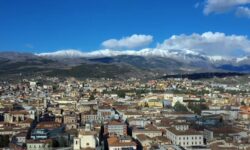
L’Aquila Italian Capital of Culture 2026

The Feast of Sant’Antonio Abate in Abruzzo

20 Best Towns in Abruzzo Italy to Visit in 2023
Welcome to this journey through the best towns in Abruzzo! In this article, you will discover the hidden gems of this region rich in history and natural beauty.
From the majestic mountains of Abruzzo National Parks to the coastline overlooking the Adriatic Sea, Abruzzo boasts a variety of charming small towns.
I often visit Abruzzo because it borders the region where my hometown, Rome, is located. By the way! I bet you want to visit these off-the-beaten-path places in Abruzzo just as a getaway from crowded Rome .
Each of the most beautiful towns in Abruzzo has its own unique tradition to tell, especially when it comes to food. In this post, I’ll also share with you the typical dishes from each of these Abruzzo towns.
I will break the article into two main groups: inland towns and coastal towns.
In the first part, we will explore, from north to south of the region, the most characteristic villages built among the valleys of Abruzzo.
Next, we will focus on some of the best destinations on Abruzzo’s Trabocchi Coast, famous and unique all over the world precisely because of the stilts built since ancient times for fishing.
We seem all set, so let’s go, or as they say in Abruzzo, jamme !
Civitella del Tronto

In northern Abruzzo, you find Civitella del Tronto , which is part of the club of The Most Beautiful Villages of Italy.
This village is located in the province of Teramo, in the Vibrata Valley, at an altitude of 589 meters. This medieval jewel set among the rolling hills of Abruzzo captures the eye with its imposing walls and cobblestone streets, which invite you to explore every corner.
History comes alive in the majestic Fortress of Civitella , one of the largest in Europe, which narrates the epic battles of the past. Here you can admire breathtaking views from the walls, casting a glance at the valley below, a silent witness to centuries of events.
Its origins date back to the Middle Ages, but one of the most important chapters in the fort’s history occurred in the 16th century when Civitella del Tronto became a vital stronghold for the Kingdom of Naples, controlled by the Spanish crown .
During the War of Spanish Succession (1701-1714), the Fort of Civitella del Tronto was the subject of sieges and battles between Spanish and Austrian forces, with the defenders putting up tenacious resistance.
The 1703-1704 siege, in particular, has become famous for the strenuous defense by Spanish soldiers against enemy forces, although the fort eventually fell into the hands of the Austrians.
Even the typical dishes derive from military contexts. In fact, the two most cooked dishes are “Franceschiello chicken” and “fillet steak Bourbon style.” Among those that really encapsulate the whole essence of the culture is “ le ceppe .” In fact, the name comes from a wooden stump around which a small piece of flour and water dough was rolled to create a kind of tube-shaped pasta.
Don’t worry, it will not be difficult to dispose of all these delicacies in Civitella del Tronto. The Gran Sasso and Laga Mountains National Park will offer you wonderful landscapes and some of the best Abruzzo hiking trails.
Pietracamela

Continue your journey of discovery of Abruzzo’s most beautiful villages by descending about fifty kilometers southwest of Civitella del Tronto to Pietracamela.
You are still in the province of Teramo. Moving toward the center of the region, the altitude rises and you arrive at 1005 meters.
This village has only three hundred and fifty inhabitants and is perched on the slopes of Corno Piccolo . It, too, has been part of the Most Beautiful Villages in Italy since 2008. Finding out why is quite simple. The village was founded in the 12th century, with the need for people to take refuge in safe and hard-to-reach places.
Lovers of skiing and mountaineering can delight in the area of the Prati di Tivo ski resort. Also within the Gran Sasso National Park, it is home to Europe’s southernmost glacier, the Calderone . Visiting it is simple: start at Prati di Tivo and follow the trail to the Vallone delle Cornacchie, until you reach the Franchetti refuge, the true gateway to the glacier.
In Pietracamela you will not find great nightlife or special attractions, but you will surely appreciate the pure air that surrounds every corner and the tradition that hovers within the walls of the small village perched on the mountain.
Being a village of shepherds, it will be easy to find dairy specialties in every little store, but if you really want to savor the essence of Pietracamela, don’t miss the “ socretti ,” short type pasta topped with pecorino cheese.
Santo Stefano di Sessanio
Continue southward on your journey through the Abruzzo lands and you will reach Santo Stefano di Sessanio . You continue to climb in altitude, reaching 1250 meters above sea level. This village is in the province of L’Aquila.
The village seems to date back to Roman times. Following the fall of the Roman Empire, Lombard monks redeveloped the area, making the land cultivable and, most importantly, creating a fortified and secure place.
There are countless outdoor activities here as well, starting with skiing and continuing with horseback riding or biking on the old mule tracks leading to Campo Imperatore .
Santo Stefano di Sessanio boasts the slow food presidium of its own lentils . This type of legume is very difficult to grow elsewhere, in fact, it can only be grown on the dry mountain soils between 1200 and 1450 meters.
I recommend trying them in one of the village taverns, in the form of soup accompanied by little squares of bread fried in olive oil.

Staying in the province of L’Aquila, with only an 8-minute drive you will reach another hidden gem of the Abruzzo mountains: Calascio .
As for the village, consisting of not even 200 inhabitants, it is located at an altitude of 1214 meters. As for the famous Calascio Fortress , which can be visited on foot from Campo Imperatore, you’ll reach 1520 meters above sea level.
The history of this mystical place , which dominates the southern slope of Mount Gran Sasso , is very ancient and intriguing. The construction of the tower dates back to around 1000 according to scholars. But it was only in 1380 that the first written documentation was found, above which it can be understood that the tower was built as an isolated lookout site.
The center of the village is very picturesque, and getting lost in its narrow streets will prove to be a very pleasant experience.
After the earthquake that struck the L’Aquila area, the inhabitants of Calascio were halved. Today, the testimony of those who remained and, day after day, rebuilt, is really valuable. Hearing the stories of those who still live in this small perched village will be a truly unforgettable gift to add to your stay.
I suggest you add Calascio to your bucket list of small towns in Abruzzo, Italy.
Continue on the road of the most beautiful villages in the Abruzzo mountains to arrive, 70 kilometers south of Calascio, at Pacentro.
The origin of the village is around the 10th-11th centuries when the castle was erected to defend the population of the Peligna Valley from Saracens and Normans.
Pacentro is the gateway to the Maiella National Park , and although the village is 700 meters above sea level, it is possible to reach 2,800 meters with hikes that reach Mount Amaro , the peak of the Maiella.
The medieval atmosphere of the village captivates anyone who decides to visit, but the real masters of the area are the towers of Caldora Castle , which dominate the entire landscape.
If you are a lover of ancient traditions and village legends, don’t miss a visit to la Preta Tonna . This stone, also known as the “scandal stone”, was the place where insolvent debtors were forced to sit completely naked. A very undiplomatic, but curious method.
Beech is the main tree in the local flora, and you can enjoy wonderful walks at the beech groves that surround the entire village.
To totally immerse yourself in the medieval atmosphere of Pacentro, you cannot miss its typical dish: polta pacentrana , a hearty dish of beans, potatoes, and cabbage boiled separately. The ingredients are then shredded and sautéed in a pan with oil, garlic, and, in the spicy version, chili peppers. This simple and flavorful dish will truly leave you speechless, giving your palate a timeless culinary experience.

Abbateggio lies on the northern slopes of Majella , the mother mountain of Abruzzo.
Explore the oldest part of town by walking through winding streets and steep stairways.
The houses here are built with a local white stone that has made this hamlet very popular. But without going overboard. In fact, Abbateggio is one of Italy’s most off-the-beaten-path tourist destinations.
In the historic center once stood the Castle of Abbateggio. There now stands the Church of San Lorenzo Martire , with a Renaissance facade and 15th-century portal.
On a rocky hill opposite the village is the Shrine of Our Lady of Elcina . It seems that the Virgin Mary appeared here repeatedly to the locals between the 15th and 16th centuries. From here, there is an exceptional view that sweeps all the way to the Adriatic Sea.
Abbateggio is an ideal destination for relaxing in Abruzzo, but also for embarking on hikes in the still little-known Majella National Park .
Near the village stands the intact forest “ Macchia della Majella .” From the village start trails that reach some of the medieval rock hermitages for which this national park in the heart of Abruzzo is famous, such as:
- Hermitage of S. Bartolomeo,
- Hermitage of S. Spirito
- Hermitage of S. Onofrio
Nearby Località Cusano, instead, you will find one of my favorite places in the whole world.
Take a path through an olive grove that leads you to a fairy-tale gorge where a very pure stream flows. Hiking to the spring of the stream you will encounter the crystal-clear Cusano Waterfall (or Lejo Waterfall), where you can cool off during the Italian summer . It’s places like these that make me realize that this is one of the best national parks in Italy.
The opportunity to visit this enchanted place makes Abbateggio the best town in Abruzzo for waterfall lovers.
The typical product of the village is spelt , a cereal that has been consumed in the Mediterranean since the time of the ancient Egyptians.
In winter, you can taste spelt soup, and in summer spelt salad.
If you are in Abbateggio on August 10, the day dedicated to St. Lawrence, the patron saint of the town, you can attend the spelt festival , the town’s most vital and joyful day.
Roccascalegna
Move a few miles eastward now and reach the village of Roccascalegna in the province of Chieti.
This small hillside village is surrounded by the Sangro River . Its origins date back to Roman times, but it was in the Middle Ages that the village assumed a prominent role.
Dominated by the mighty fortress , the citadel witnessed conflicts and alliances between noble families.
Over the centuries, Roccascalegna passed under different dominations, each contributing to its architectural and cultural evolution. The castle, set on a rocky spur, was the scene of struggles for territorial control, while the village below developed around the Church of San Pancrazio .
Even today the main attraction of the village is the marvelous castle. Built on a spur of limestone rock, it represents a symbol of power and defense in medieval times. Its origin dates back to the 11th century when it was built by the Normans.
In addition to its strategic function, Roccascalegna Castle is a unique testimony to medieval military architecture, with mighty walls, towers, drawbridges, and an access path carved into the rock.
Visits to the castle offer the opportunity to explore the inner halls, admire the panoramic views of the surrounding valley, and immerse oneself in a fascinating journey through time. The castle is a historical and cultural treasure, transporting visitors to a time of chivalry, nobility, and ancient battles, offering a unique perspective on the life and architecture of the medieval past. Ready to live a day in the Middle Ages?
Pescocostanzo
The village of Pescocostanzo is located 1395 meters above sea level and fifty kilometers southwest of Roccascalegna.
This place is part of the Maiella National Park . Here, too, finds of ancient tombs suggest that the village was established as early as Roman times.
Attacks were never too strong to destroy it. Despite a devastating earthquake in 1456, the village quickly recreated itself, a testament to the perseverance and strength that still dominates its inhabitants.
Ski resorts here, too, know how to delight their visitors during the winter months, especially those on the Cinquemiglia Plateau .
Maiella National Park offers large canyons, rock walls, and forests in the valleys, perfect for outdoor activities or healthy relaxation.
Lovers of ancient trails can experience the thrill of walking the original paths of monks, brigands, and shepherds, exploring the mountain areas surrounding Pescocostanzo.
In case all this walking makes you hungry, you can enjoy one of Pescocostanzo’s traditional local dishes. Tacconi con orapi is what you are looking for!
This particular type of handmade pasta is served with orapi , the very tasty local wild spinach.

Opi is a small town in western Abruzzo, belonging to the province of L’Aquila. This town consists of 3 rows of houses and it’s perched on a rock ridge overlooking the breathtaking panorama of the Camosciara natural amphitheater.
Opi is the ideal destination in Abruzzo for those who want to contemplate the landscape and maybe spot bears and wolves. Chatting with the locals, you can get them to tell you about the time they saw a bear run through the village.
Among the activities you can enjoy here, there is hiking, biking, horseback riding, and cross-country ski trails in winter.
Among the most beautiful hikes you can do here are the one through the Fondillo Valley and the climb to the top of Mount Amaro from the Fondillo Valley. The latter though is for expert hikers seeking the best adventurous things to do in Italy .
In summer, you can bathe in the clear lakes of Barrea or Scanno , which are among the most beautiful lakes to see near Rome .
Besides bears and wolves, these mountains are inhabited by chamois, golden eagles, and bobcats.
In this area, which has continually been inhabited by shepherds, traditional foods are those based on sheep milk and meat.
If you visit Opi, try some of these delicacies:
- ricotta cheese
- pecorino cheese
- dried sheep meat
- ‘ mpaniccia (slices of stale bread softened in whey)
- cicatelli (a pasta made from flour and water)
- pecora al cotturo (a sheep stew cooked over low heat for many hours)

Move east again now and you will arrive in Scanno. Also listed among the most beautiful villages in Italy, Scanno has an altitude of 1060 meters. It is located in the province of L’Aquila, one of Abruzzo’s main cities .
Along the course of the Carapale River, statuettes of Hercules were found, suggesting early civilian settlements in Roman times.
The towns’ architecture is very rich and varied and derives from the landowning aristocracy that gained a foothold over the centuries.
Fountains, building facades, churches: the entire street furniture of Scanno cannot be said to be left to chance. The manicured and elegant architecture of the village creates a very interesting contrast to what we are used to seeing in Italian mountain villages.
Scanno overlooks the ancient mountain lake of the same name, which is why there are so many activities available.
One of the most popular, and certainly romantic, is the path of the heart of Lake Scanno , which will give you a very unusual perspective for a lake, presenting itself in fact in the shape of a heart.
The village is guarded among the vegetation of the Abruzzo National Park, home of the Marsican brown bear .
Not surprisingly, one of Scanno’s typical dishes is dedicated to him.
Bear bread can be found in historic bakeries and is a kind of sweet focaccia, made with dried fruit and covered with chocolate.
Civitella Alfedena
Let’s reach the last stop on our tour among Abruzzo’s mountain villages by staying in the province of L’Aquila to reach Civitella Alfedena.
This is the smallest village in the valley of the Abruzzo National Park , and it is located at an altitude of 1121 meters.
The town develops on the slopes of Mount Sterpi D’Alto, and behind it, you can enjoy one of the most beautiful sights in all of Abruzzo: the Camosciara amphitheater .
This nature reserve is perfect for taking more or less challenging walks and trails, immersed in a truly incredible landscape. The typical features you will encounter walking through the streets of the village are medieval and feudal, to which its origin is precisely linked.
At the foot of the village is Lake Barrea , easily reached by a walk from the center.
Getting lost in the streets of the village, you can try to discover the secret of the ancient recipe for the village’s typical dessert, scurpella , which has been guarded by generations of women.
It is a fried leavened dough meant to be a symbol of abundance.
Caramanico Terme

The village dates back to the Middle Ages. During the time of the Longobard invasion (6th century), to defend themselves from raids, the locals built houses along narrow, winding alleys founding Caramanico Terme.
If you want to visit, make sure you are in good shape! We did it with a baby carriage and it was a bit exhausting. But you will be rewarded with views of a green valley and mountains.
The name immediately reveals what the town is famous for: thermal water of different types flows from three springs in town.
The spa is now unfortunately disused but you can still taste the sulfur water that comes out of a fountain. In the historic center, there are several old churches to see, to name only the most beautiful:
- Church of St. Tommaso d’Aquino
- The Abbey of Santa Maria Maggiore
- Church of St. Nicola di Bari
The most satisfying activity to do near Caramanico is hiking. From the village, there is quick access to trails of different lengths (from 2km to 14km) through the pristine, lush Orfento River Valley .
The best times to go into this fairy forest of Abruzzo are not only in spring and autumn but also during the hottest days of summer.
The environment is refreshed by the passage of this wonderful river.
Fara San Martino

This town is tucked into the natural scenery of the Majella National Park. Fara San Martino is also known as the “ capital of pasta “, due to the presence of two major pasta factories (De Cecco and Del Verde) that take advantage of the presence of the Verde River for their production.
The oldest part of the village consists of a medieval known as “ Terra Vecchia ,” which runs uphill and is accessed through the Porta del Sole gate. There are several churches to see in the village: the Church of San Remigio, the Church of the Annunziata, and the Church of Santa Maria delle Grazie.
For mountain lovers, a stay in Fara San Martino will be extremely pleasant.
You can walk through the San Martino Gorges to discover the remains of the Medieval Abbey of San Martino , a walk of about 2 hours. The more adventurous can reach the Top of Mount Amaro (a 14 km hike).
You can obtain a map of the hiking trails in the area at the Majella Park Info Point.
After seeing the gorges, walk down to the headwaters of the Verde River to dip your feet in the icy water. A perfect day in Fara San Martino can’t miss a meal of delicious sheep Arrosticini , the typical Abruzzo skewers popular all over Italy.
Most beautiful towns in Abruzzo’s Trabocchi Coast
Franca villa al mare.
One of the most popular coastal towns in Abruzzo is Franca Villa al mare , just south of Pescara.
The town has a very ancient history, but it was in the 19th century that it acquired a very high cultural value. In fact, it was at that time that the painter Francesco Paolo Michetti converted an old convent into a cultural hub, frequented by such illustrious figures as Gabriele D’Annunzio , one of the most famous contemporary Italian poets .
During World War II Franca Villa al mare was almost completely destroyed, but then rebuilt with great success and speed by its citizens.
The sea is clean and clear and surrounded by fine golden sand. Franca Villa al mare is known for being the last town on the Pescara coast before the wonderful Costa dei Trabocchi .
Let’s discover in the next paragraphs some of the most spectacular towns on this coast full of magical atmosphere.

This stretch of Abruzzo coastline is characterized by ancient trabocchi , wooden structures similar to stilts traditionally used by fishermen to catch fish.
These trabocchi have become an icon of the region, skillfully blending history and nature. The earliest record of a trabocco dates back to the 18th century, when Abruzzo’s fishing communities invented these ingenious structures to make the most of the area’s marine resources.
Today, many of these structures rising above the Adriatic Sea have been restored and transformed into picturesque restaurants where you can enjoy fresh fish and admire the breathtaking views.
A truly unforgettable experience. One of the most beloved villages on the Costa dei Trabocchi is undoubtedly Fossacesia .
This medieval village truly resembles an enchanted place, especially thanks to the Abbey of San Giovanni in Venere , a wonderful medieval structure overlooking the coast.
Certainly, the sea is one of Fossacesia’s flagships, but this ancient village is also famous for its production of high-quality extra virgin olive oil. You can visit centuries-old olive groves and learn about the production process during harvest time.
San Vito Chietino

The town sits on a hill that stretches to the sea. Here one discovers that Abruzzo is so much more than mountain walks and medieval hermitages.
I spent my summer vacation here and have fond memories of the atmosphere of this quiet, off-track Italian coastal hamlet . San Vito is one of the best places to live in Abruzzo, Italy.
San Vito (not to be confused with the town of the same name located in Sicily) is an off-the-beaten-path town in Abruzzo and a privileged gateway to the Trabocchi Coast .
Along this coast are some of the most beautiful beaches in Abruzzo . If you enjoy cycling, you can discover all the beaches and bays via the cycle route which is developed on the track of the former coastal railroad, now disused.
Start in the small city of Ortona and go as far as the Punta Aderci Nature Reserve , 40 km further south. You can rent a bicycle in the part of San Vito Chietino that borders the beach, namely San Vito Marina .
In this small town near Chieti, you will also find tiny restaurants where to enjoy the fresh catch at very affordable prices. One of the succulent dishes to try is spaghetti alla chitarra with seafood . It is a homemade pasta similar to tonnarelli .
In the summer evenings, enjoy the breeze in the hilltop part of the town where, from the Belvedere Guglielmo Marconi, you’ll enjoy a view that encompasses the entire Trabocchi Coast.
Rocca San Giovanni
Continue your journey along the Costa dei Trabocchi and arrive in Rocca San Giovanni. Here, too, speaking of origins, we come to the Middle Ages. It seems, in fact, that the castle was precisely built in protection of the local inhabitants during the first centuries of the Middle Ages.
Rocca San Giovanni, because of its charm suspended between the hills and the sea, has, too, been certified as one of Italy’s Most Beautiful Villages, and once you arrive you will immediately realize why.
Rocca San Giovanni is famous for its pristine olive groves and vineyards, and this is where the culinary specialties come from.
One of the most beloved is definitely the “ cellipieni .” As tradition dictates, during the grape harvest women pick the best bunches of grapes, crush the berries and remove the pits.
The grapes are then placed in copper pots and, as in a magic ritual, patiently stirred in a slow cooking process. Almonds and chocolate are then added until it is made into a paste for the fragrant “cellipieni.” This strong-tasting dessert gives a unique taste in the mouth, that of the old but always new peasant civilization of the area.
Torino di Sangro
I end this long journey among the beautiful villages of Abruzzo in a really fascinating place, even from the history of the name.
I am talking about Torino Di Sangro .
According to legend the inhabitants of “Civita di Sangro,” attacked by the Saracens fled preceded by a bull (toro) that stopped under the ancient Tower, where they took refuge, giving birth to a new village that took the name of Torino .
The peculiarities of this village lie not only in its name: the entire coastline that runs along it, about six kilometers, is adorned with hills of ancient trees and woods that overlook the very sea.
A truly spectacular panorama. The Punta Aderci Nature Reserve is a truly unique paradise of biodiversity where you can enjoy many outdoor activities.
Two of the most beautiful beaches on the Adriatic Riviera are located here: Punta Aderci Beach and Libertini Beach .
Wrap-up – Best towns in Abruzzo Italy

One of the reasons I wrote this post about the most beautiful towns in Abruzzo was to convince you to explore this little-known region of Italy .
At this point you have no excuse not to visit Abruzzo, or as the locals say, the Abruzzi , using the region’s name in the plural form. Perhaps they do so because there are truly so many riches this region of central and southern Italy has to offer.
First of all, here you will find both wild mountains and beaches on which to relax for the day, washed by clean seas.
The quality of the food, which is always served in generous portions and at affordable prices, is another plus point for Abruzzo.
As for traditions and authenticity, you’ll find plenty of that here.
Hopefully, this post has given you many clues to decide where to stay in Abruzzo, so all you need to do is start planning your trip.

I’m Lisa, an Italian from Rome who one day discovered she finds incredible joy in traveling to new places. With this blog, I help you discover Italy (especially Rome and its surroundings) as a local would. Find out more about me here .

- Privacy Overview
- Strictly Necessary Cookies
This website uses cookies so that we can provide you with the best user experience possible. Cookie information is stored in your browser and performs functions such as recognising you when you return to our website and helping our team to understand which sections of the website you find most interesting and useful.
Strictly Necessary Cookie should be enabled at all times so that we can save your preferences for cookie settings.
If you disable this cookie, we will not be able to save your preferences. This means that every time you visit this website you will need to enable or disable cookies again.
- Hidden Gems
- Popular Classics
- Travel Tools
- Photography
- Vintage Pieces
- Digital Prints
The Best Towns in Abruzzo, Italy Worth Visiting
- March 18, 2024
Abruzzo is a vastly underrated destination in Italy with much to be discovered and admired. Not only is it undeniably beautiful, it is also equipped with everything you could want in one place – medieval ruins, national parks, vibrant cities, the sea, castles, valleys, and rivers. Among the region’s best features are the towns of Abruzzo , Italy. Some are built into mountains while others sit perfectly on hilltops. The range of marvellously historic villages and towns in Abruzzo is abundant.
Each a little different and extraordinary in their own way, these are the best towns in Abruzzo, Italy worth visiting.
Where Is Abruzzo in Italy?
What is the abruzzo region like, map of the best towns in abruzzo, italy, villa santa maria, colledimezzo, fara san martino, pescocostanzo, roccacasale, castel di sangro, santo stefano di sessanio, castel del monte, marina di san vito / san vito chietino, l’aquila, what is the main city in abruzzo, where do expats live in abruzzo, italy, final thoughts on the best towns in abruzzo, italy, travel resources for visiting towns in abruzzo.
→ 🎒Book a day trip from Rome to visit Abruzzo ←
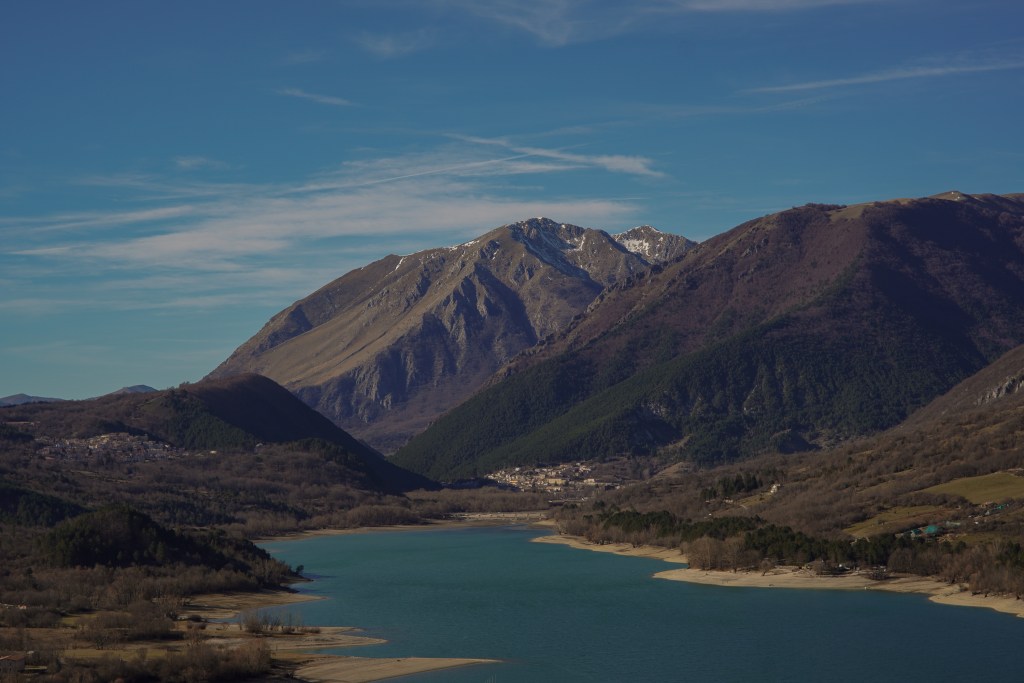
Geographically speaking, the Abruzzo region is located in central Italy . Although, if you were to divide Italy into north and south, Abruzzo falls in the southern half of the country. The Abruzzo region is east of Rome and consists of an Adriatic Sea coastline along with the Apennines mountain range.
Abruzzo is situated just north of the ever so popular summer destination of the Puglia region. Far, far in the distance from Abruzzo’s shoreline and across the Adriatic, is the Balkan country of Croatia.
Based on surface area alone, it is the 13th largest region out of Italy’s 20 and has a population count of just over 1.3 million.
Furthermore, the region is divided into four provinces – Teramo, Chieti, Pescara, and L’Aquila. The best towns in Abruzzo, Italy are dispersed among the various corners of the region, but some may prefer a particular province over another.
→ ✈️ Book cheap flights to Pescara or Rome ←

Although it feels like Italy has been seen and done by the masses, there are still so many regions and areas of the country that are considered to be off the beaten path . At the top of lesser known places in Italy is the entire region of Abruzzo.
The towns and villages of Abruzzo are nowhere near as celebrated as ones you’d find in Tuscany, but they are equally as historic and picturesque . Abruzzo’s region is in fact comprised of many communities that aren’t vastly developed, which honestly make it near impossible to choose the most extraordinary ones to visit. Ancient hilltop towns and medieval villages (known as borghi in Italian) are in abundance in Abruzzo.
The region boasts an incredible shoreline of the Adriatic Sea with no shortage of beautiful beaches to enjoy in the summer. Abruzzo is also notably one of the most famous regions in Italy for its national parks. Whether or not it is winter, the national parks are sure to please any outdoor lovers, sports enthusiasts, hikers, and photographers. Among its landscape, you’ll uncover gorges, waterfalls, rivers, and panoramic views of mountain peaks.
→ 🐟 Discover the gem of Abruzzo: The Trabocchi Coast ←
We have yet to visit another region in Italy that feels as authentic as Abruzzo does. Since it is not touristy, the region is left in a beautifully unbothered state where travelers have the opportunity to experience what Italy looks and feels like without crowds and souvenir shops. Naturally, it’s proud of its own distinct cuisine , cultural events, and century-old traditions that still live on among everyday life with much of the older population. Frankly, the best towns of Abruzzo, Italy are those that are unspoiled .
→ 👣 Learn more from a local: 3-hr walking tour of L’Aquila ←


The Most Beautiful Towns in Abruzzo, Italy
The town of Villa Santa Maria is located in the Chieti province and within the foothills of the Maiella mountains. It is notable for a couple of reasons but still remains as a destination that many people touring Abruzzo will overlook. First, it is prominently known for its Hotel Institute, widely known as the “School of Chefs.” Culinary tradition and cooking workshops are said to have formed as early as the 13th century in Villa Santa Maria. For decades, a multi-day long event is held in Villa Santa Maria to celebrate its culinary roots along with gastronomy experts. For anybody who appreciates good food, this is among the best towns in Abruzzo, Italy for you.
Its natural landscape is another fascinating reason to visit Villa Santa Maria. A portion of the town is built into the side of the cliff, and you can see actual houses that have been constructed around the stone of the mountainside. It is somewhat of a marvel to witness! Furthermore, the Sangro River runs just beneath the town and is one of the most beautiful places to hang around during the summer.
→ 🛌 Book the best rated place to stay in Villa Santa Maria ←

Rather than a town, Atessa is more of a small city. Like any settlement situated on a hilltop, Atessa is steeped in ancient history and heritage. Most famously, it is known for its legend of Saint Leucius of Alexandria, a patron saint that killed a dragon who was terrorising the medieval hamlet. To this day, the dragon is a mythologic symbol of Atessa and little homages can be found throughout the city.
Today, Atessa is a charming combination of both old and new world, comprised of a neighborhood with new development that is still tied to the historic center. Instead of large commercial shops, you’ll find locally owned businesses and boutique storefronts throughout its streets. It’s one of the best towns in Abruzzo, Italy with a bigger city feel rather than a sleepy energy.
Atessa is particularly fond of festivals, events, and celebrations so the list of things to do is never in short supply. We’ve attended an Oktoberfest beer festival, Carnival parade, outdoor ice rink in the winter and even a go-karting race built into the town’s streets.
→ 🛌 Book the best rated place to stay in Atessa ←

Colledimezzo is nestled in the Val Sangro community of mountain towns in the Chieti province. It balances perfectly on a sharp rock on the side of a mountain and overlooks the Bomba Lake below. At first glance, one would think the whole town will topple down at any moment, but centuries have gone by and Colledimezzo lives to tell the tales. With a view of the Maiella mountains in the background, this town is truly one of the most picture-perfect there is, perhaps in all of Italy.
A majority of Colledimezzo’s historic centre is only accessible on foot. Additionally, there are a ton of stairs to conquer, a handful of ancient churches to visit and beautiful panoramic views to experience . To wander through the maze of cobblestone streets and stone houses is one of the closest experiences you can have to stepping back in time.

The small comune of Fara San Martino is located directly at the base of the Maiella mountain range. The town’s most famous characteristic is that it’s known as the “pasta capital of the world.” Fara San Martino is blessed with natural spring water, also known as the green river ( fiume verde ), which is directly used to produce pasta by some of the world’s most renowned companies like Delverde and De Cecco. The proof is most definitely in the water!
Fara San Martino is also a beloved destination for outdoor lovers, given its location within the Majella National Park. Among the town’s backdrop is the canyon of Gorges of S. Martino which includes a hiking trail leading to the ruins of the ancient Monastery of St. Martin .
In the heart of the village is where you’ll stumble across Terra Vecchia, the oldest section of Fara San Martino and the only area to survive the destruction from World War II.
→ 🛌 Book the best rated place to stay in Fara San Martino ←

With just over 1,000 residents, it’s surprising how many visitors the town of Pescocostanzo draws in every year. Pescocostanzo is known throughout Abruzzo as one of the most beautiful villages because of its well-maintained facades, street decor, and, for lack of a better word, “cuteness.” Furthermore, it’s equally an admired destination in the winter as it is in the summer.
Located in the heart of the national park and within an alpine-like environment, the village of Pescocostanzo is favored for relaxing getaways in a quaint and traditional atmosphere. Hiking, mountain biking, and horseback riding are popular activities for tourists visiting in the summer. Additionally, the village is a stop along the Trans-Siberian Railway , an iconic journey that runs with historic trains.
In the winter, Pescocostanzo is frequented by skiers who either visit the slopes directly near the town or in nearby Aremogna.
→ 🛌 Book the best rated place to stay in Pescocostanzo ←

There is an official club of the “most beautiful villages in Italy” and Pacentro is a rightful member. It is one of the most historic towns in Abruzzo with evidence suggesting it has been around since the 8th century AD. The beautifully preserved medieval centre and its fairytale-like location are what set it apart from many other villages in the area.
The castle of Castello Caldora was originally erected in the 10th century but has since been wonderfully conserved in an effort to boost tourism and celebrate the community’s history and heritage. Throughout the village, you’ll find works of art and information panels, a couple of things that are certainly not found in every town.
Although the big city of Sulmona is within close proximity, the village of Pacentro feels like you’re centuries away.
→ 🛌 Book the best rated place to stay in Pacentro ←

From certain angles, the town of Roccacasale appears to be built completely vertical, in typical medieval fashion and surrounded by a forest. Its landscape is defined by the ruins of Castello De Sanctis, a stone fortress which you can hike to for panoramic views of the valley below. Further up into the hills is where you’ll also find the fascinating cave church of Grotta San Michele Arcangelo.
Roccacasale has a unique reputation which has naturally evolved over hundreds of years of legends and stories. It is famously known as the town of magicians, sorcerers and even fairies. Whether or not you’re one for imagination, it is a fact that Roccacasale boasts no shortage of magic.
→ 🛌 Book the best rated place to stay in Roccacasale ←
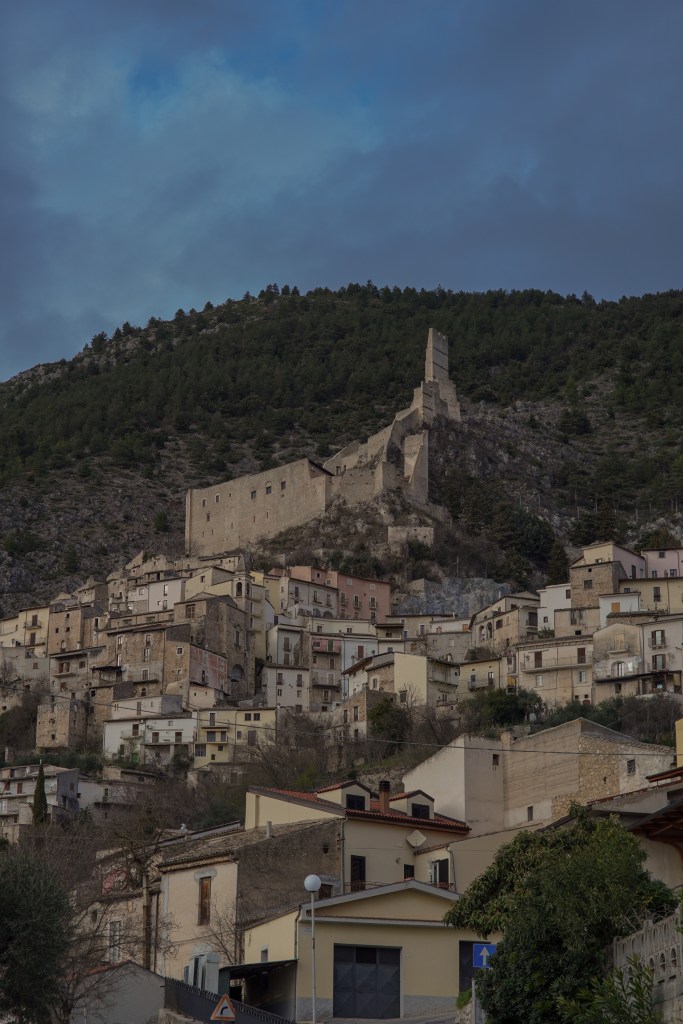
Castel di Sangro is a bustling town with antique shops, local boutiques and no shortage of restaurants and bars. Given its location along the Gustav Line during World War II, much of the city has been reconstructed, which has left the town with an intriguing mix of architecture from various time periods.
Located 800 metres above sea level and by the border between Abruzzo and Molise, Castel di Sangro is frequently known as the Gateway to Abruzzo. It is within close reach of Abruzzo’s most frequented ski resort of Roccaraso but also a popular place to visit the Sangro River in the summer.
At the highest peak of Castel di Sangro, you’ll find the remnants of the medieval castle which also holds the best panoramic view of the city below. The town square of Piazza Plebiscito is among the most picturesque meeting points for drinks or coffee that we’ve come across in Abruzzo.
→ 🛌 Book the best rated place to stay in C astel di Sangro ←

The ancient village of Santo Stefano di Sessanio is found over 1,200 metres above sea level and in the middle of two national parks – Gran Sasso and Monti della Laga. It is a member of the “most beautiful villages in Italy” club and upon visiting, it’s very apparent why. Although there are many medieval villages in Abruzzo, Santo Stefano di Sessanio truly embraces its heritage and historic architecture throughout the town centre. In other words, there is a lot of care and pride put into maintaining the community.
A number of high-end hotels and restaurants have made a home in the small village along with shops that have established themselves in the arched alleyways.
Santo Stefano di Sessanio may be ancient but what sets it apart from many other villages is the apparent presence of intention to celebrate its history. The town had endured its fair share of ups and downs and continues to persevere and prove itself as one of the most delightfully traditional places to visit in Italy.
The hamlet of Santo Stefano di Sessanio is well known for its tower homes, the Torre Medicea landmark and its distinct cultivation of lentils.
→ 🛌 Book the best rated place to stay in Santo Stefano di Sessanio ←

Castel del Monte is situated on the slope of Mount Bolza, which belongs to the Gran Sasso National Park in the L’Aquila province. The village is small but has been deemed beautiful enough to even be featured in films of both local and worldwide productions. With an altitude of 1,346 meters, it is magnificently located among nature and surrounded by mountain peaks, rolling hills, and valleys.
Before World War II, the village was a thriving center for the production of wool but since, has experienced a large wave of emigration. Today, Castel del Monte is rather silent but beautiful by all means. You must tour the historic centre exclusively on foot, which is filled with stunning stone buildings and whimsical features around each corner.
Among one of the top reasons to visit Castel del Monte is because it is located just down the street from Abruzzo’s most famous landmark, the hilltop castle of Rocca Calascio .
→ 🛌 Book the best rated place to stay in Castel del Monte ←
→ 🎒 Take a day trip from Rome to visit Abruzzo ←
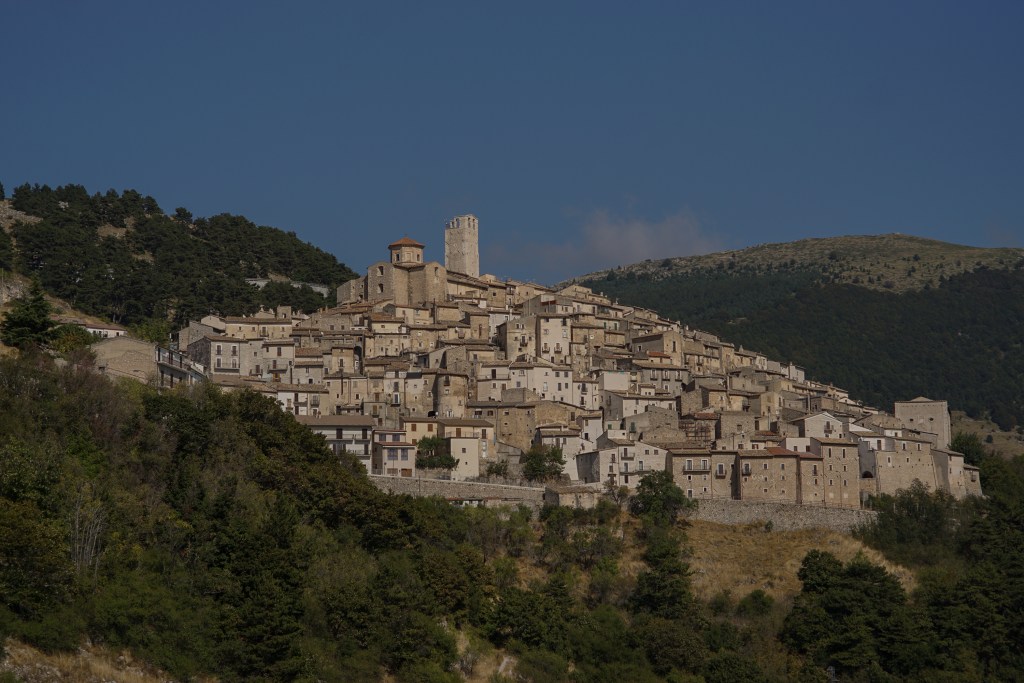
The Best Coastal Towns in Abruzzo, Italy
Location: chieti province.
- The cliffside castle of Castello Aragonese
- Beginning point of the Trabocchi Coast and its countless gorgeous beaches
- The historic WWII site of the Battle of Ortona
- The Musical Museum of Abruzzo
→ 🛶 Recommended Activity: Kayak Excursion of the Trabocchi Coast ←
→ 🛌 Book the best rated place to stay in Ortona ←

- The Caldoresco Castle
- Church of Santa Maria Maggiore with the crypt of San Cesario
- Giardino Napoletano D’Avalos Vasto – Neapolitan-style garden built on Ancient Roman ruins
- Palazzo d’Avalos art museum
- Numerous beaches and the breathtaking Punta Aderci Nature Reserve
→ 🛌 Book the best rated place to stay in Vasto ←

- Cycling and walking along the Green Path, a paved trail that runs along the Trabocchi Coast
- Beach clubs, water sports and waterfront accommodation
- Clear, shallow and calm water with sandy beaches that are ideal for families
- Historic trabucco fishing structures that are used as high-end resturants for regional Abruzzese cuisine.
→ 🍽 Recommended Activity: Food & Wine Tour of San Vito Chietino ←
→ 🛌 Book the best rated place to stay in San Vito Chietino ←
- The wonderfully restored church of Abbey of San Giovanni in Venere
- Dreamy beaches like Spiaggia della Fuggitella
- An exceptional winery experience at Frentana Cantina
- In the heart of Abruzzo’s best seafood restaurants like Trabocco Punta Punciosa Restaurant
→ 🛌 Book the best rated place to stay in Fossacesia ←
→ 🍇 Historic Wine Cellar Tour and Tasting in Abruzzo ←

The Best Cities in Abruzzo, Italy
Location: l’aquila province.
- The production of Sulmona’s confectionery specialty – the sugared almond
- An aqueduct from 1256 which still stands in the main town square
- The birthplace of the famous Latin poet Ovid
- A departure point on the scenic Trans-Siberian Railway journey
- The Cathedral of San Panfilo and complex of the Santissima Annunziata
→ 🛌 Book the best rated place to stay in Sulmona ←

- The main town square of Piazza Duomo
- Basilica of Santa Maria di Collemaggio, known to be an architectural masterpiece in Abruzzo
- The wall of fountains with 99 spouts
- A combination of archaeological, religious and historic exhibits at The National Museum of Abruzzo (MUNDA)
- An impressive rooftop fresco painting inside Chiesa di San Silvestro
→ 🛌 Book the best rated place to stay in L’Aquila ←
Location: Pescara Province
- The pedestrian and bicycle only bridge of Ponte di Mare
- The oldest quarter of the city (Pescara Vecchia) is believed to have originated in the 1st millennium BC.
- Lungomare di Pescara – the boardwalk which runs along the sea and numerous beaches
- The birthplace of the famous Italian poet and novelist Gabriele D’Annunzio which has been turned into an art collection
- The Pineta Nature Reserve – a pine forest park
→ 🍽 Recommended Activity: 4-Course Home Cooked Meal in Pescara ←
→ 🛌 Book the best rated place to stay in Pescara ←
- The Eucharistic Miracle that is said to have taken place in the 8th century
- Church of San Biagio – the oldest church in Lanciano dating back to 1059 that is built on a Roman temple
- Impeccably preserved medieval workshop storefronts from the 15th century
- The restored Lanciano Cathedral
- A cultural hub which regularly hosts artistic events and festivals
→ 🛌 Book the best rated place to stay in Lanciano ←
- A melting pot of architectural styles from Gothic to Renaissance
- Marrucino Theatre – a lavish theatre built in the early 1800s.
- According to legend, Chieti was originally founded by Achilles
- The Chieti Good Friday procession is known to be one of the oldest in Italy
- Ruins from the 3rd century and an underground passageway from the Roman era
→ 🛌 Book the best rated place to stay in Chieti ←
Based on technical status, L’Aquila is the capital of the Abruzzo region. However, it is not the region’s largest city by population. Pescara, located on the coast, is the biggest city in Abruzzo and also acts as the region’s major port.
Pescara is also a larger commercial hu b, meaning you will find more shopping centres, large warehouses, and big-name brands known worldwide. The Abruzzo International Airport is the region’s only international air hub and conveniently located in Pescara.
L’Aquila is located in the middle of Italy, and you can conveniently reach Rome in just 1.5 hours by car or bus!
→ 🚉 Search for bus and train tickets from Rome to L’Aquila ←

Unfortunately, there is no clear answer to this question for those looking to purchase property or retire in Abruzzo. After traveling throughout and living in Abruzzo, we have bumped into expats everywhere from small villages, big cities to remote countryside. Ultimately, expats choose to live in specific areas of Abruzzo that most meet their preferences – we’re all a little different!
Even so, there are a couple of trends that we have noticed. First, many expats tend to like the close proximity of being near Rome , so in the Province of L’Aquila. Even if you do not want to live in the big city of L’Aquila, there are numerous small towns and quaint villages in the province that still keep you within under two hours of Rome.
Based on our own observation and statistics from real estate agents in Abruzzo, many British expats prefer to live near the sea along the Adriatic coast . Villages and bigger towns found in the Chieti province are a great option for those who want to live precisely on the coast in Abruzzo or in the middle of mountains with a short distance to the sea.
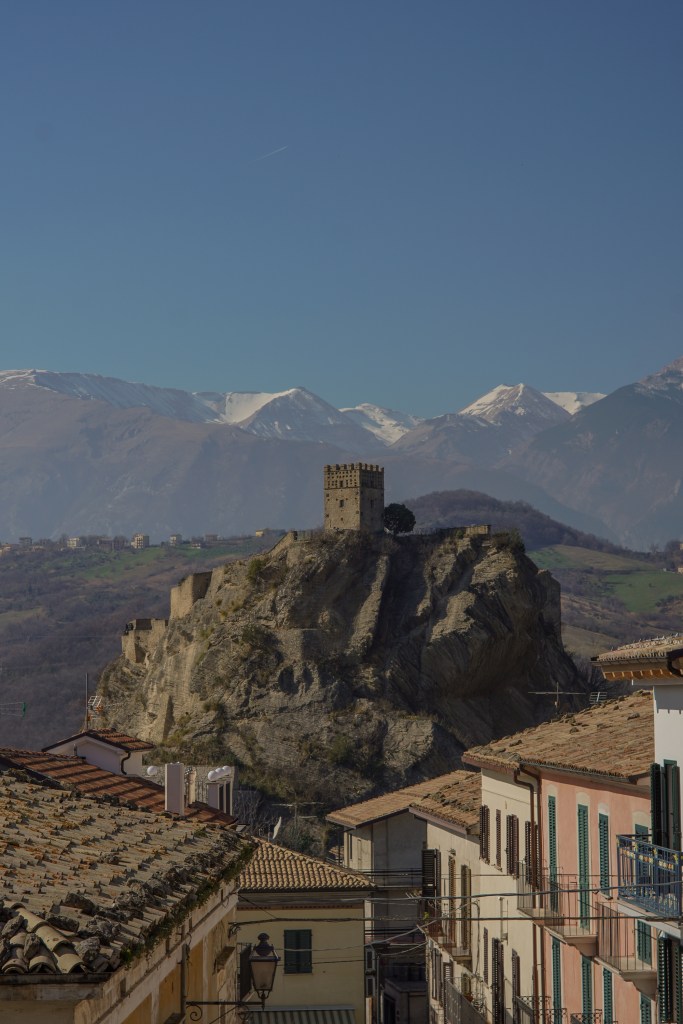
- If you’re keen on being by the sea, Vasto is the best coastal town in Abruzzo that provides something of interest for everyone.
- The L’Aquila province is where you’ll find the most number of hilltop villages with medieval town centres and remarkable backdrops of mountain peaks .
- For the most low-key and less traveled towns in Abruzzo, visit the Chieti province and the villages of Val Sangro.
- While L’Aquila is the official capital of Abruzzo, there is more to do from a commercial standpoint in Pescara .
- The best beaches are found along the Trabocchi Coast which begins in Ortona and ends in Vasto.
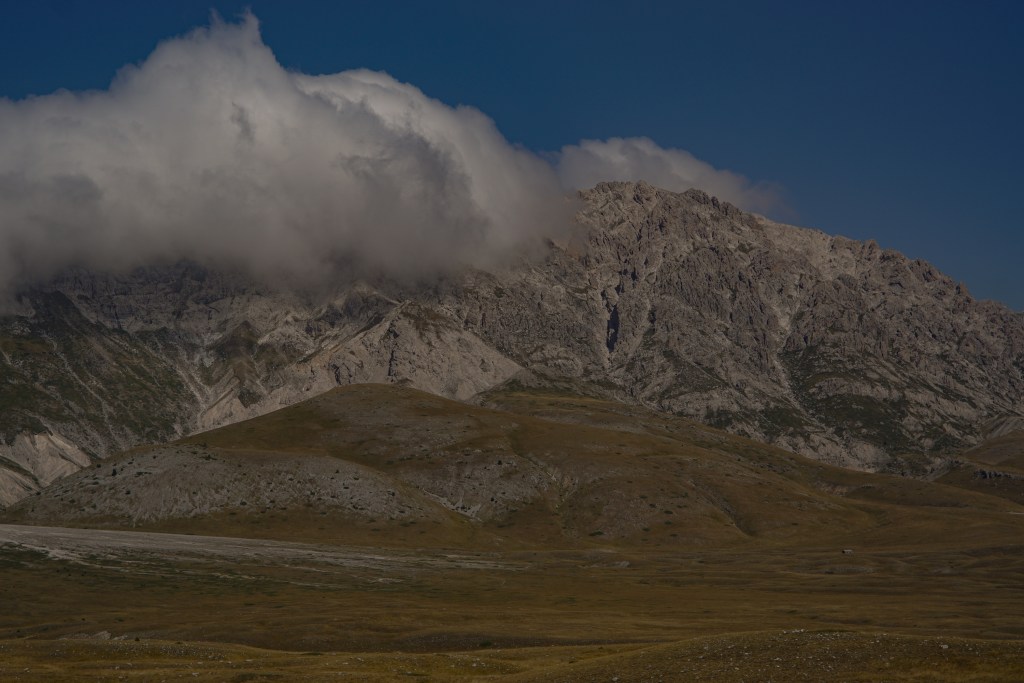
Affiliate Disclaimer: Please note that some links found in our posts are affiliate links. Should you choose to purchase through these links, we may receive a small commission at no extra cost to you.
Share this:
Leave a reply cancel reply, discover more from adventures of ace.
Subscribe now to keep reading and get access to the full archive.
Type your email…
Continue reading

Vacation Countdown App

The Charming Villages of Abruzzo: The Best-Kept Secrets of Italy
We’re reader-supported. When you buy through links on our site, we may earn an affiliate commission.
Central Italy’s best-kept secret, Abruzzo, is seeping with authenticity and old-world charm. Just two hours outside of Rome, and largely unknown to international travelers, this crown jewel of Italy is filled with nostalgic Italian villages that have remained preserved throughout time and offers visitors everything that they are looking for in an authentic Italian experience.
The region’s cuisine, landscape, heritage, and wines depict one of the last old-world destinations in Italy. Abruzzo’s remarkable variety of flavors and aromas, reaped from the produce of its uncontaminated mountainous areas, offer a diverse cuisine that appeals to the most discriminating taste buds.
Destination Abruzzo in Central Italy
This stunning destination welcomes travelers with rich, wild landscapes filled with olive grove draped hillsides, rolling acres of vineyards, the vast white sandy beaches of the Adriatic Coast, and awe-inspiring peaks of the Apennine Mountains. Prepare to uncover these breathtaking landscapes of some of the most charming and idyllic villages of Abruzzo, Italy , where nature converges with a rich history, ancient traditions, and unparalleled flavors.

Central Italy is where Abruzzo is located, making it the perfect home base to explore other regions of this picturesque country. The region of Abruzzo has a medieval atmosphere and covers a vast area with plenty to see and do. You can explore medieval villages perched atop rocky cliffs, drive through the pristine countryside filled with vineyards and olive groves, or enjoy the stunning Adriatic Sea. The top of Abruzzo is dominated by the jagged peaks of the Apennines, which are perfect for hiking or skiing, while its coastline offers miles of beautiful beaches and seaside villages to visit. Travelers will always find what to do in Abruzzo no matter how many days they spend exploring this wonderful region.
Wander through the narrow alleyways of one of Abruzzo’s most beautiful hilltop towns. With an expansive view of the Adriatic Sea, the town brims with medieval architectural wonders that date back to 15th century Italy.
Take in the views where the crystal blue waterways of the Adriatic meet warm golden beaches with a backdrop of medieval structures, art, and cultural centers, and even a palace. Visit the Palazzo d’Avalos palace, which houses a quartet of museums including the Museo Civico Archaeologica. After looking at ancient bronzes and glasswork as well as 19th-century art, make sure to immerse yourself in the beauty of the nearby Neapolitan-style garden.
Descend on the charming town of Sulmona located at the foot of the majestic Majella National Park. This lovely village is one of the most famous of Abruzzo’s villages, made popular for its sugary coated almonds, commonly known as “confetti.” The quaint streets bustle with vendors who boast vibrant bouquets and artfully sweet arrangements available in a wide array of succulent flavors. Learn all about the traditions of throwing confetti at weddings that were born here. Despite a devastating earthquake that hit the historic village in 1706, you’ll find medieval architecture and a spirit throughout the village that has stood the test of time.

Visit Abruzzi’s capital of vibrant ceramics known as “majolica,” which were collected by the elite of Europe for hundreds of years. Select some magnificent pottery and bring part of nostalgic Italy back home. Sealed with clear colored glazes, brightly colored hand-painted adornments, and a signature color palette, these works of art are certain to get your attention. Travelers can even take a cultural tour of the area and learn how to make their very own “Majolica” masterpiece.
Enter into the pages of a fairy tale when you arrive in the scenic, magical hill town of Scanno. Take a canoe adventure through Scanno lake, which formed when a landslide from the mountainside blocked the natural course of the river than ran through it. This enchanting medieval town is known for its magnificent crystal blue lake and its precarious alleyways, baroque architecture, and its costumed inhabitants. Take home a special memento of an intricately laced pattern embroidered on pillows made within the village borders.

Sneak into the tiny village of Villalago and discover the sacred, small church, The Hermitage of San Domenico. Unlock access from the outside, stroll past the altar and climb a few steps and discover the hidden sanctuary. Find your zen and connect with the world at this peaceful spot surrounded by serene views of the bluest waters and the pure beauty of nature.
Roccascalegna
Take a trip back in time to the 16th century with an excursion to the medieval village of Roccascalegna. Seemingly frozen in time, this medieval castle stands elevated on a gravity-defying ledge of limestone. This is only one of the more than fifty awe-inspiring castles that will amaze you on your journey through Abruzzo.

Civitella del Tronto
Travel to the site of the largest Italian military fortress and experience the wildly breathtaking panoramic views that peer over three majestic mountain ranges, a charming village, and the vast blue reachings of the Adriatic Sea. Explore the architecture and venture down the hillside and stroll through the streets and winding alleyways of the beautiful village that it oversees.
Fara San Martino
Discover pasta in Italy’s kingdom of pasta, Fara San Martino! Look no further for extraordinary pasta and Italian cuisine. This producer of the highest quality pasta brands prides itself on its distinctive flavors and ancient pasta-making techniques. Gaze at the wide, beautiful valley of the Verde River, whose waters combine with other special ingredients to make the world-famous pasta. Enjoy your dinner with wine from the region.
Explore the village’s stunning Canyon of St. Spirito. Once inside, stretch your arms out and touch two distinct mountains as you hike to the 13th-century Monastery of St. Martino in Valle along beautiful terrain.
Santo Stefano di Sessanio
The mountain village of Santo Stefano di Sessanio is one of the most charming in all of Abruzzo. This medieval village, located in the province of L’Aquila at 1250 meters above sea level, is within the Gran Sasso and Monti della Laga national park. The village has been abandoned for many years, but recent restoration efforts have brought new life to the town. There are now several restored buildings, including a hotel and vacation homes. The village hosts a festival each year in September celebrating its delicious lentils. If you’re looking for a charming and off-the-beaten-path village to visit in Italy, Santo Stefano di Sessanio is a great choice.
The Climate in Abruzzo – What is the best time to visit?
The climate in Abruzzo is largely Mediterranean, which means that summers are very hot and winters are mild. Spring and autumn are the most popular times to visit an Italian village in this region because the temperatures are comfortable enough for long walks along the beach, checking out a hiking trail through the mountains, or enjoying some Italian dishes or lunch with wine outside. The average high temperature in July is around 86 degrees Fahrenheit, while the average low in January is around 38 degrees Fahrenheit. Although it does not rain as much as other regions in Italy, October and November can be very wet months.
There is no perfect time to visit Abruzzo because every season offers something different and beautiful to see and do. Travelers who want to enjoy the best of what the region has to offer should plan their vacation during either spring or fall when there are mild temperatures and less crowds. Summer is an ideal time for those who want to be surrounded by the warm sea and sunshine of Italy’s coasts.
Accommodations in Abruzzo
There are plenty of unique accommodations in this central Italian region. You can stay in beach hotels, farmhouses, cute villas, or even a 17th-century castle.
Abruzzo offers a wide range of accommodations to fit any budget and preference. Whether you want to enjoy a luxurious stay in the Italian countryside, or live like a local and spend their nights tucked away in an agriturismo (Italian for “farm”), you can find it all in Abruzzo. With so many options available, it can be difficult to choose where to stay in Abruzzo, but no matter what travelers decide, they’re sure to have an amazing and unique experience.
Finding the best places to stay in Abruzzo is easy with this form because you can sort through hundreds of properties and choose the ideal one for your needs and budget.

Getting Around in Abruzzo, Italy
One of the best ways to get around Abruzzo is by car . The roads are winding and the scenery is gorgeous, so it’s the perfect place to take a leisurely drive. If you’re not comfortable driving in Italy, there are also plenty of buses and trains that will take you around the region.
If you’re looking for a more adventurous way to travel, Abruzzo is a great place to go hiking or mountain biking. There are trails for all levels of hikers, and the views from the top of the mountains are absolutely incredible.
Books about Abruzzo
If you’re looking for a deeper understanding of Abruzzo, its history, and its culture, there are several books that we can recommend.

Counting Castles in Abruzzo: A Journey Through the Land of Enchantment is an excellent resource that covers everything from the region’s history, art, and architecture to its food and wine.

Walking in Abruzzo is a must-have guidebook for trekking in Abruzzo, especially in the Maiella and Gran Sasso national parks as well as Sirente-Velino regional park.

Italy Abruzzo (Bradt Travel Guide) is the best English-language guidebook to this beautiful and increasingly favored part of Italy. It covers all of the major destinations in Abruzzo, from the bustling city of L’Aquila to the stunning medieval villages in the National Park of Gran Sasso e Monti della Laga. The guidebook also includes information on where to eat, what to see and do, access details for how to get around the region, as well as background on Abruzzo’s biodiversity, culture, history, traditions, cuisine, literature, and landscape.
Similar Posts

Best Solo Travel Destination in 2022: Exploring the Mysteries of Tulum, Mexico
Tulum has been on the lips (and minds!) of many solo travelers due to its sandy beaches, rich culture, and abundant nightlife.

Best Islands For Solo Traveler in 2023 (Safe For Females!)
Looking for your next solo travel destination? We have a list of the best island destinations for solo travelers across the world!

5 Surprisingly Affordable European Destinations to Visit in 2024
If you’re looking for an epic yet budget-friendly vacation in 2023, these affordable European destinations are exactly what you’re searching for!

Top 5 Destinations in Mexico for Female Solo Travelers
Welcome to the vibrant and colorful Mexico! This land of tacos, enchiladas, and tamales is teeming with life’s pleasures. A heady mix of art and culture (this is the home…

Best Islands in Croatia – Four Islands for Travel Lovers
Discover the best places to visit in Croatia. Here are our suggestions of some of the most beautiful islands, beaches and towns that you’ll find on your travels around this gorgeous country.

Things to Do in Tulsa Oklahoma: Your Ultimate Guide to Adventure
Curious about the things to do in Tulsa Oklahoma? This guide will answer all your questions!

The Italian region with beautiful landscapes and ancient villages – but few tourists
I taly has welcomed visitors since time immemorial. But not all of Italy: some regions have remained impervious to the Grand Tourists of the past and the Instagrammers of today. Who, for example, visits Abruzzo, a region east of Rome and south of the Marche ?
Very few is the answer – but why so secret? Poverty, for one thing, and the sheer wilderness of the mountains for another. The region was too high and too isolated for vines and olives, and the medieval trade and rich history that fostered the cities – and art – of Tuscany , Umbria and Sicily.
And yet things are now changing, albeit slowly (houses here can still be had for under €10,000). Travellers are finally learning that its mountains, still the haunt of wolves and bears, are the finest in Italy outside the Alps, that its coast is gloriously wild in places, and that many of its ancient villages are timeless and traditional in the best sense. And if visitor infrastructure is still in its infancy – part of the region’s charm, of course – newer destination hotels are gradually opening , and the food, as ever in Italy, is superlative.
The new Tuscany? The new Umbria? Not quite. But a place to visit now before everyone else? Definitely.
The landscapes
Glorious mountain landscapes are Abruzzo’s principle lure. The Apennines – the Italian peninsula’s rocky spine – reach their highest point here in the peak of the Gran Sasso (9,553ft/2,912m), still home – just – to one of Europe’s most southerly glaciers.
Gran Sasso is also the name given to one of three immense massifs in the region, the other two being the Monti della Laga to the north and the Maiella to the south. All three have national park status, as does a fourth enclave, the Parco Nazionale d’Abruzzo on the region’s western flanks.
For those who only know the more benign aspect of the Apennines in Tuscany, Umbria or Liguria, it is hard to appreciate the sheer scale of Abruzzo’s mountains or their wild impenetrability. Wolves and even bears still roam here and vast, beautiful tracts of the region are accessible only on foot, following ancient transhumance trails, or with a patient – but hugely rewarding – odyssey on high mountain roads.
Most people visit the Parco Nazionale d’Abruzzo, partly because it is closest to Rome (81 miles/130km via the A2 motorway and the towns of Frosinone and Sora) and partly because it is among the best administered of Italy’s national parks. You’ll also find more in the way of hotels, facilities and marked biking and hiking trails here, notably in the main centres of Pescasseroli and smaller Opi, plus pretty, medieval Scanno just outside the park borders.
In the Monti della Laga, travel the beautiful road between Acquasanta Terme (just in the Marche) and Teramo, and consider the village of Pietracamela as a base. From here you could easily head south and take one of the finest drives in Europe, never mind Italy: the road that runs west to east under the Gran Sasso across the vast upland plains of the Campo Imperatore, known locally as “Little Tibet” after its remarkable scenery.
Visit Castel del Monte, one of the region’s loveliest villages and situated at well over 4,000ft. This is also a good place to stay, but drive on a few miles and tiny Santo Stefano boasts one of central Italy’s most interesting hotels, the Sextantio (doubles from around £150 including breakfast).
Alternatively, if you are heading for the coast (see below), continue east to Farindola, a classic little Abruzzese village with superb views and a great dining option (see below). Be sure to devote an hour or so to Loreto Aprutino to the east, one of the region’s most appealing medieval villages.
Explore the third of Abruzzo’s massifs, the Maiella, and you’ll be venturing into one of western Europe’s last great wildernesses. There are few places to stay in the heart of the mountains, with Caramanico Terme your best bet, but Sulmona just to the west is the Abruzzo’s most interesting larger town, birthplace of Ovid and of sugared almonds, or confetti (Sulmona almonds were served at Harry and Meghan’s wedding ).
It’s a town worth visiting in its own right, especially if you can be here on Wednesday or Saturday morning, when Piazza Garibaldi hosts a wonderful market. It’s also on a railway line – and there aren’t many of those in this mountain area: the ride here from Rieti via L’Aquila, and especially on to Castel di Sangro and beyond, is one of Italy’s most scenic .
The resorts and beaches
Mountains take the most plaudits in Abruzzo but the region’s long coast provides another compelling attraction. Many of the beaches and resorts are typical of Italy’s eastern, Adriatic coast, which is to say they are small, family-friendly affairs, often close to the coast’s main rail and road links, and with decent if unspectacular sand and hotels.
While some some spots in the north are fairly workaday, there are two notable exceptions: the wild, glorious stretches of sand in the Riserva Naturale del Borsacchio , north of Roseto degli Abruzzo , and Torre del Cerrano near Pineto, named after the adjacent historic defensive tower .
South of Pescara, head for Punta Ferruccio near Ortona – the scene of bitter fighting in 1943: it’s not easily reached, but is worth the effort, and has clothes-optional stretches. Equally wild and lovely are the nearby Calata or Spiaggia del Turchino close to San Vito Chietino, where the contemporary hotel Le Chiave dei Trabocchi makes a fine base (doubles from around £60).
This part of the coast takes its name from the eerily beautiful trabocchi , spindly wooden walkways and fishing shacks built on stilts which are unique to the region.
A few miles farther south still, the Lido di Casalbordino is another point of pilgrimage for beach aficionados, with the simple Finis Terrae bar a favoured spot to watch the sunset. Two more beaches stand out close to Vasto, the Abruzzo’s last hurrah before the border with Molise: Punta Penna and Punta Aderci. Both are wild places in part protected by nature reserves.
Abruzzo also has several family-friendly Green Flag beaches.
The food and wine
Like much else in the Abruzzo, the region’s food is barely known but often exceptional. The coast has predictably good fish and seafood, notably the mussels (cozze) from Vasto, often served with saffron (itself a regional speciality) or stuffed with breadcrumbs, lemon, parsley, garlic and tomato sauce.
The classic pasta is maccheroni alla chitarra, a spaghetti-like creation made by pressing sheets of pasta through wires (hence chitarra, or “guitar”).
When all’s said and done, however, the Abruzzo is a mountain region, and it’s the mountains, and centuries where poverty was the culinary mother of invention, that most colour the region’s cuisine.
Mushrooms and truffles abound, along with pulses and beans, but lamb and mutton were and are the mainstay of mountain cooking. One of the region’s great meals – one of Italy’s great meals – is to be had up on the high plains of the Campo Imperatore and elsewhere (see above).
Windblown, remote shepherds’ shacks will sell you a hunk of bread, several rough-cut chunks of pecorino (sheep’s cheese) and a fistful of arrosticini – skewers loaded with tiny pieces of lamb and mutton – that you (or they) grill on open fires. Eat with your fingers and want for nothing more.
Arrosticini are a mainstay of many mountain villages, too – make a pilgrimage to Farindola and Lu Strego , a trattoria whose version has more than once been acclaimed the best in the Abruzzo.
Wine-wise , no-one is going to Abruzzo to tour the region’s vineyards – for the most part the mountains aren’t conducive to growing vines – but wherever you go you’ll be able to drink Montepulciano d’Abruzzo, a more-than-decent red that you’ll probably have come across at home. Trebbiano is the standard white, while Cerasuolo is a lighter red also made from the Montepulciano grape.
But there is quality. As elsewhere in “lesser” Italian wine regions such as Umbria, the post-war period saw newer, dynamic producers pioneering some now top-notch wines. In particular look for bottles from Pepe and Valentini , along with CantinArte, Annona, Italo Pietrantoj, Cataldi Madonna and Valle Reale.
For more unusual regional drinks, risk a glass of ratafia, a black cherry liqueur; Aurum, a branded orange-scented brandy made in Pescara since 1925; centerbe (literally “one hundred herbs”), made from the mountain herbs of the Maiella; and genziano, made from the root of the gentian.
Getting there
Ryanair flies to Pescara Airport from Stansted. A far greater of options exist if you fly to Rome, from which regional capital L’Aquila is a 90-minute drive.
Staying there
Villa companies on the whole are still feeling their way into Abruzzo – typically a company might only one or two properties in the region – but look at the dedicated Abruzzo Turismo page or properties on the owner-listed Vrbo (formerly HomeAway) site . For more ideas on where to stay, see our guide to the best hotels in Abruzzo .
This story was first published in March 2022 and has been revised and updated.
Sign up to the Front Page newsletter for free: Your essential guide to the day's agenda from The Telegraph - direct to your inbox seven days a week.


IMAGES
COMMENTS
It is a must see spot for anyone who visits Abruzzo. 7. Sulmona, the capital of "confetti". Sulmona is a charming town located at the foot of the Majella, surrounded by mountains, where ancient history and a strong tradition for colorful sweets live together making it one of the most famous villages in Abruzzo.
Here are the must-visit spots in Abruzzo you should know about. 1. Abruzzo National Park. Step into the wild heart of Italy at Abruzzo National Park, a sanctuary of biodiversity and natural beauty. Here, the Apennine wolves roam free, and the Marsican brown bear leaves its elusive footprints.
Map of Abruzzi italy. The Abruzzo region is bordered by the Marche region to the north, Lazio to the west and southwest, Molise to the southeast, and the Adriatic sea to the east. The region spans an area of 10,795 square kilometers, within a third of these lands there are three national parks, nature reserves and protected areas.
per adult (price varies by group size) A day with the shepherd milking sheeps and making cheese in the National Park of Abruzzo. 1. Food & Drink. from. $1,091. per adult (price varies by group size) Marsican Abruzzo Tour with Sheep Cheese Making Experience. Food & Drink.
Here are 10 reasons you should visit Italy's next hot destination. 1. Abruzzi cuisine. Pasta production house Antico Pastificio Rosetano, which makes pasta brand Verrigni, is located in Abruzzo ...
6. Pescara. L'Aquila may be the capital, but Pescara is the biggest city in Abruzzo. Famous for its golden coast, line with marinas that jut out into the Adriatic, Pescara is the place to develop a terrible tan line. Compared to other parts of Abruzzo, Pescara is refreshingly modern.
From €34.00. 8. The Majella National Park: between History and Nature. The Majella National Park is another unmissable event for nature lovers traveling to Abruzzo. The park, established between 1991 and 1995, extends between the provinces of Chieti, L'Aquila and Pescara and offers a vast range of attractions.
Abruzzo. Neither part of fashion conscious, Ferrari-producing northern Italy, nor the siesta-loving, anarchic world of the south, Abruzzo is something of an enigma. Despite its proximity to Rome and its long history of tribalism and pre-Roman civilisation, it sits well down the pecking order of Italian regions in terms of touristic allure.
This is Italy 's Abruzzo National Park, a triumph of conservation and rewilding in both Italy and Europe. In the entirety of the Abruzzo region - of which the national park is only a portion - just 1.3 million tourists visited in 2021, with far less making the journey from Abruzzo's gorgeous coastline inland to the park.
Let's dive into the must-see attractions in Abruzzo, Italy. 1. The Trabocchi Coast. Truly one of the best reasons to visit Abruzzo, the trabocchi have always been associated with the region. A UNESCO World Heritage Site, the Trabocchi Coast is named for its collection of trabocchi, old fishing platforms that have been in use here since the ...
from $35 per adult. 2-Hour Picnic among the Olive Trees with Typical Abruzzese Products. 4. from $33 per adult. Among ancient sunny vineyards, visit and taste the wines from the San Lorenzo cellar. 5. from $33 per adult. 3-Hours of Activities with Safari Grand Tour and Tasting in Vineyards.
Here is a suggested two-day travel itinerary for Abruzzo, including tips on how to travel from Rome, the best places to visit, the best food to try, and where to stay. Day 1 Anversa degli Abruzzi in the mountains of Abruzzo, Italy. Image by Depositphotos.com Morning. The easiest way to travel to Abruzzo from Rome is by train or car. If you ...
Best things to do in Abruzzo. If you like the outdoors and off-the-beaten-path travel, you'll love Abruzzo! You won't find a grand tour of famous sites in this region… but you will get a genuine feeling of what daily Italian life is like, plus get to experience rolling hills, spectacular mountains, and stunning beaches.. Explore Abruzzo's national parks
Basilica of Santa Maria di Collemaggio. A masterpiece of Abruzzese Romanesque and Gothic architecture, the Basilica of Santa Maria di Collemaggio is L'Aquila's most important church and the largest in Abruzzo. It was heavily damaged during the 2009 earthquake that devastated the city, which is the regional capital of Abruzzo.
Majella National Park. Majella National Park is one of the three national parks in Abruzzo. With over 100 square miles of stunning mountains and valleys to explore, it's one of the best-preserved Apennine ecosystems. Throughout the summer months, hiking in this area is perfect for individuals with a passion for the outdoors.
Top places to visit in Abruzzo region. Alba Adriatica. Bomba Lake. Campomarino Lido. Canosa Sannita. Città Sant'Angelo. Giulianova Lido. Gran Sasso e Monti della Laga National Park - the largest national park in Italy. L'Aquila.
Places to visit in Abruzzo. Top Things to Do in Abruzzo, Italy. Places to Visit in Abruzzo. Explore popular experiences. See what other travellers like to do, based on ratings and number of bookings. See All. Dining Experiences (37) Culinary Tours (4) Historic Walking Areas (211) Wine Tastings (24) Walking Tours (22)
For a summary of the most popular sights in the region see also Abruzzo places to visit. The Abruzzo region runs along the Adriatic coast of western central Italy. Much of the inland (western) part of the Abruzzo region is a wilderness, and includes a part of the Apennine mountains to the north, and extensive plains and forests to the south ...
12 Best Places to Visit in Abruzzo, Italy 12. Civitella del Tronto. Home to the highest fortress in Italy, Civitella del Tronto is a trip back in time. In the 1860s, the fortress helped the city become the last bastion of resistance against Victor Emmanuel's plans to unify Abruzzo, Italy
Pacentro. Set in the mountains of the Majella National Park, Pacentro is one of the most beautiful places to visit in Abruzzo. According to legend, the town was founded by Trojan hero Pacinus. Historians say that Pacentro's origins can be dated between the 8th and 9th centuries, but numerous archaeological finds suggest the human presence in ...
20 Best Towns in Abruzzo Italy to Visit in 2023 Civitella del Tronto. In northern Abruzzo, you find Civitella del Tronto, which is part of the club of The Most Beautiful Villages of Italy. This village is located in the province of Teramo, in the Vibrata Valley, at an altitude of 589 meters.
For the most low-key and less traveled towns in Abruzzo, visit the Chieti province and the villages of Val Sangro. While L'Aquila is the official capital of Abruzzo, there is more to do from a commercial standpoint in Pescara. The best beaches are found along the Trabocchi Coast which begins in Ortona and ends in Vasto.
Italy Abruzzo (Bradt Travel Guide) is the best English-language guidebook to this beautiful and increasingly favored part of Italy. It covers all of the major destinations in Abruzzo, from the bustling city of L'Aquila to the stunning medieval villages in the National Park of Gran Sasso e Monti della Laga. The guidebook also includes ...
Most people visit the Parco Nazionale d'Abruzzo, partly because it is closest to Rome (81 miles/130km via the A2 motorway and the towns of Frosinone and Sora) and partly because it is among the ...
547 likes, 1 comments - welcometoabruzzo on February 5, 2024: " 05/02/2024 . ⓒ ⓞ ⓝ ⓖ ⓡ ⓐ ⓣ ⓤ ⓛ ⓐ ⓣ ⓞ ⓝ ⓢ . VISIT ITS BEAUTIFUL GALLERY ARTIST : ...". WELCOME TO ABRUZZO | 🔷05/02/2024🔷 . ⓒ ⓞ ⓝ ⓖ ⓡ ⓐ ⓣ ⓤ ⓛ ⓐ ⓣ ⓞ ⓝ ⓢ . 🏆🏅VISIT ITS BEAUTIFUL GALLERY 🏆🏅 📷ARTIST ...